More nursing homes could go on strike -
VerifiedAdded on 2022/08/21
|39
|13915
|22
AI Summary
Contribute Materials
Your contribution can guide someone’s learning journey. Share your
documents today.
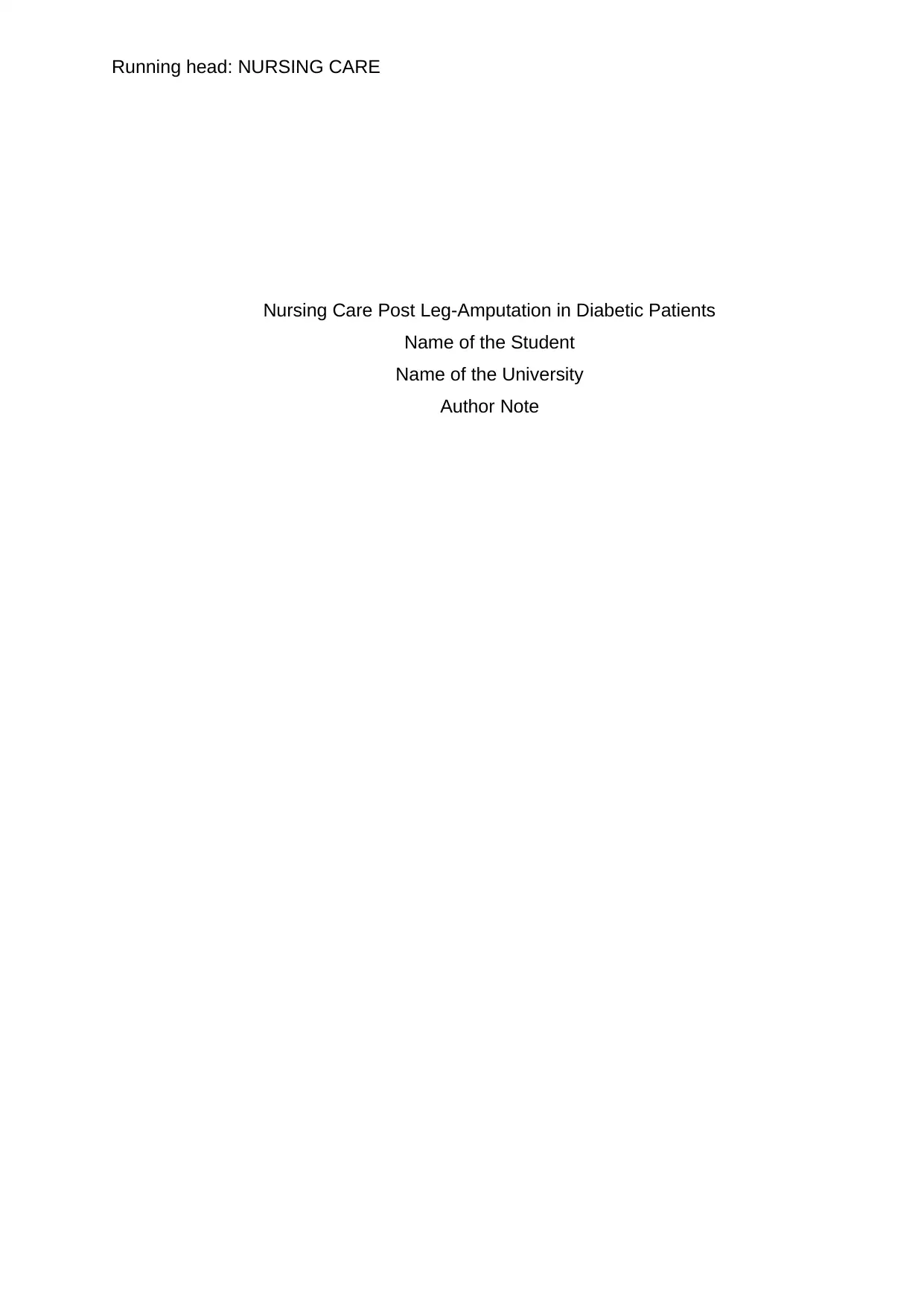
Running head: NURSING CARE
Nursing Care Post Leg-Amputation in Diabetic Patients
Name of the Student
Name of the University
Author Note
Nursing Care Post Leg-Amputation in Diabetic Patients
Name of the Student
Name of the University
Author Note
Secure Best Marks with AI Grader
Need help grading? Try our AI Grader for instant feedback on your assignments.
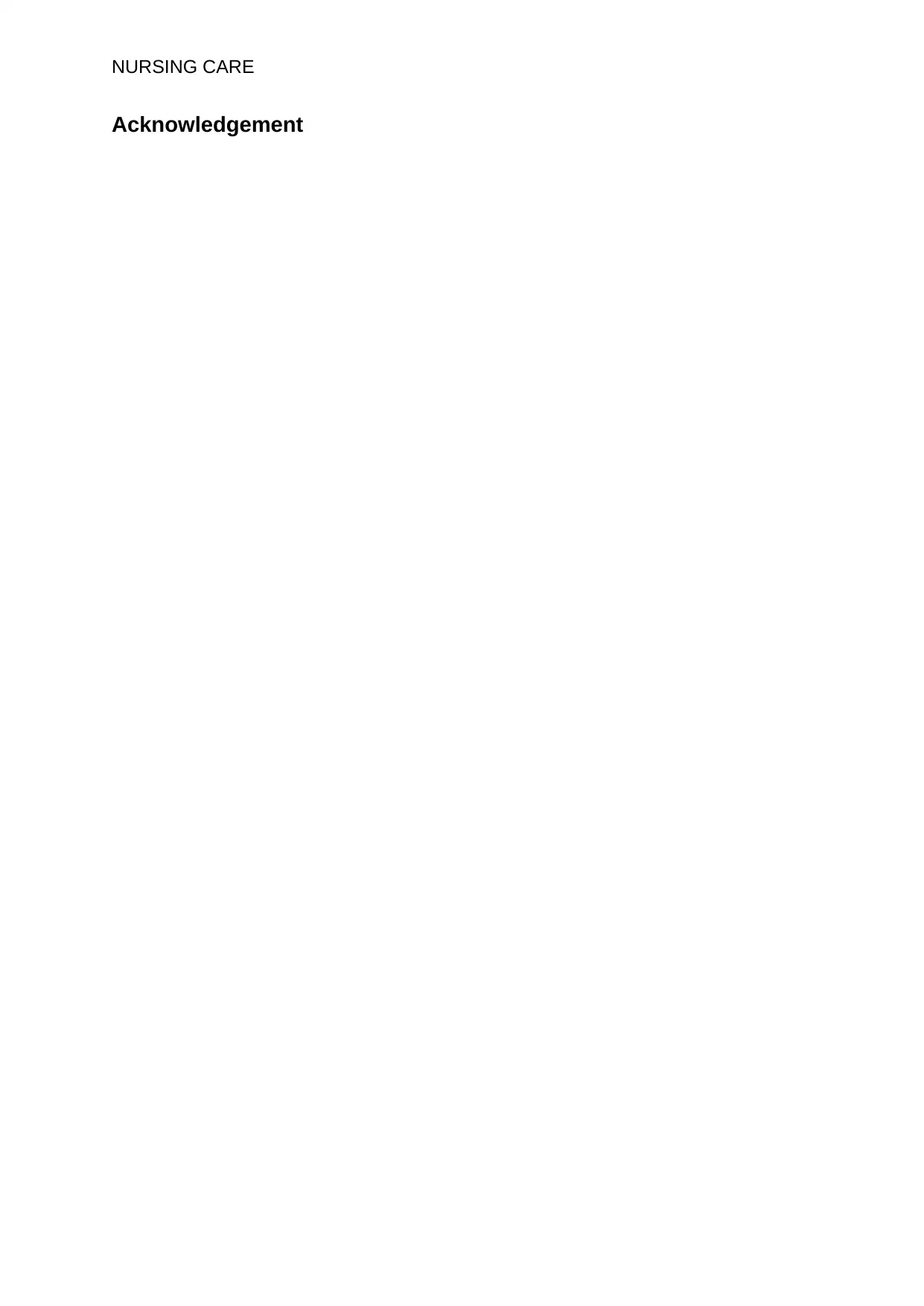
NURSING CARE
Acknowledgement
Acknowledgement
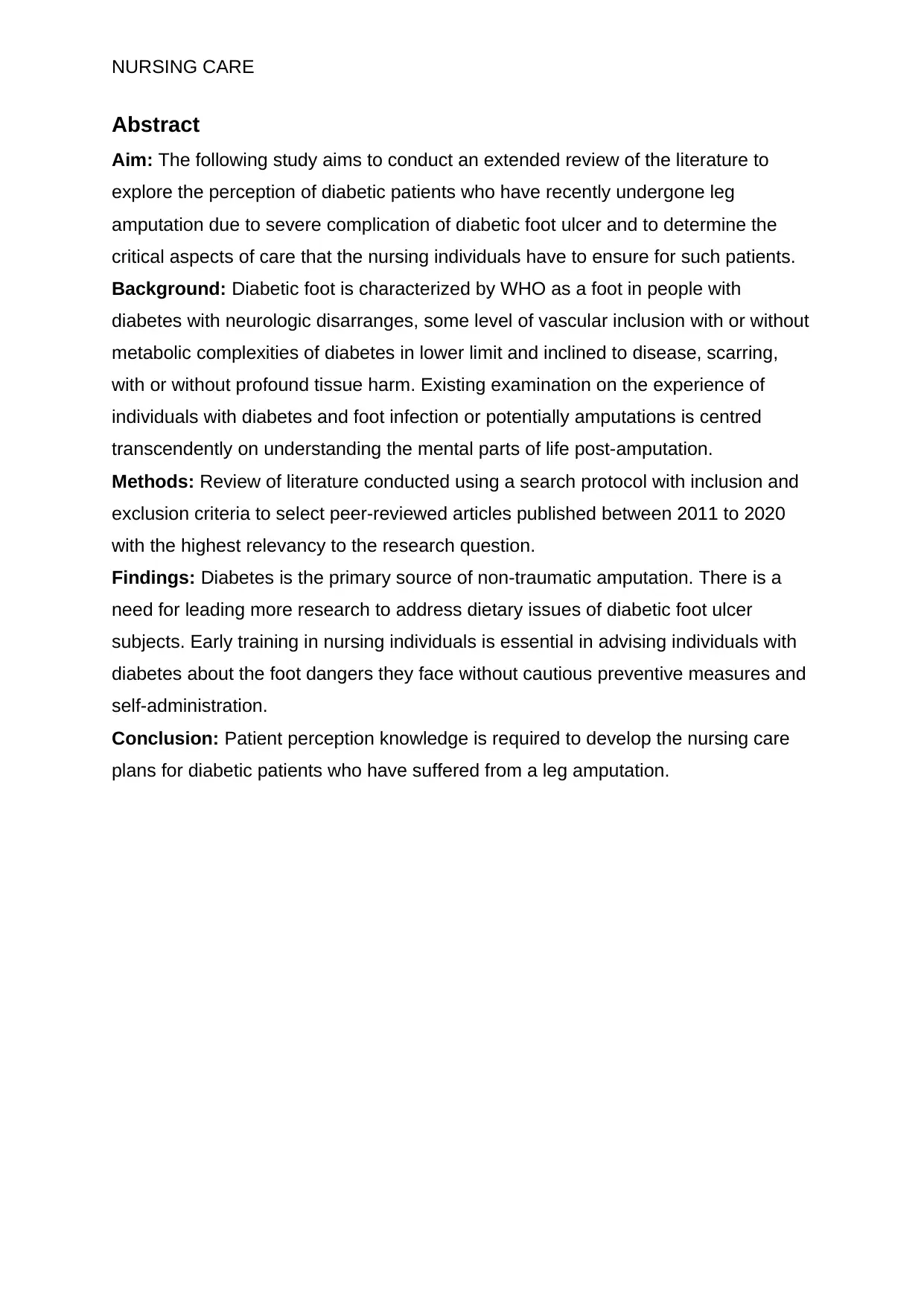
NURSING CARE
Abstract
Aim: The following study aims to conduct an extended review of the literature to
explore the perception of diabetic patients who have recently undergone leg
amputation due to severe complication of diabetic foot ulcer and to determine the
critical aspects of care that the nursing individuals have to ensure for such patients.
Background: Diabetic foot is characterized by WHO as a foot in people with
diabetes with neurologic disarranges, some level of vascular inclusion with or without
metabolic complexities of diabetes in lower limit and inclined to disease, scarring,
with or without profound tissue harm. Existing examination on the experience of
individuals with diabetes and foot infection or potentially amputations is centred
transcendently on understanding the mental parts of life post-amputation.
Methods: Review of literature conducted using a search protocol with inclusion and
exclusion criteria to select peer-reviewed articles published between 2011 to 2020
with the highest relevancy to the research question.
Findings: Diabetes is the primary source of non-traumatic amputation. There is a
need for leading more research to address dietary issues of diabetic foot ulcer
subjects. Early training in nursing individuals is essential in advising individuals with
diabetes about the foot dangers they face without cautious preventive measures and
self-administration.
Conclusion: Patient perception knowledge is required to develop the nursing care
plans for diabetic patients who have suffered from a leg amputation.
Abstract
Aim: The following study aims to conduct an extended review of the literature to
explore the perception of diabetic patients who have recently undergone leg
amputation due to severe complication of diabetic foot ulcer and to determine the
critical aspects of care that the nursing individuals have to ensure for such patients.
Background: Diabetic foot is characterized by WHO as a foot in people with
diabetes with neurologic disarranges, some level of vascular inclusion with or without
metabolic complexities of diabetes in lower limit and inclined to disease, scarring,
with or without profound tissue harm. Existing examination on the experience of
individuals with diabetes and foot infection or potentially amputations is centred
transcendently on understanding the mental parts of life post-amputation.
Methods: Review of literature conducted using a search protocol with inclusion and
exclusion criteria to select peer-reviewed articles published between 2011 to 2020
with the highest relevancy to the research question.
Findings: Diabetes is the primary source of non-traumatic amputation. There is a
need for leading more research to address dietary issues of diabetic foot ulcer
subjects. Early training in nursing individuals is essential in advising individuals with
diabetes about the foot dangers they face without cautious preventive measures and
self-administration.
Conclusion: Patient perception knowledge is required to develop the nursing care
plans for diabetic patients who have suffered from a leg amputation.
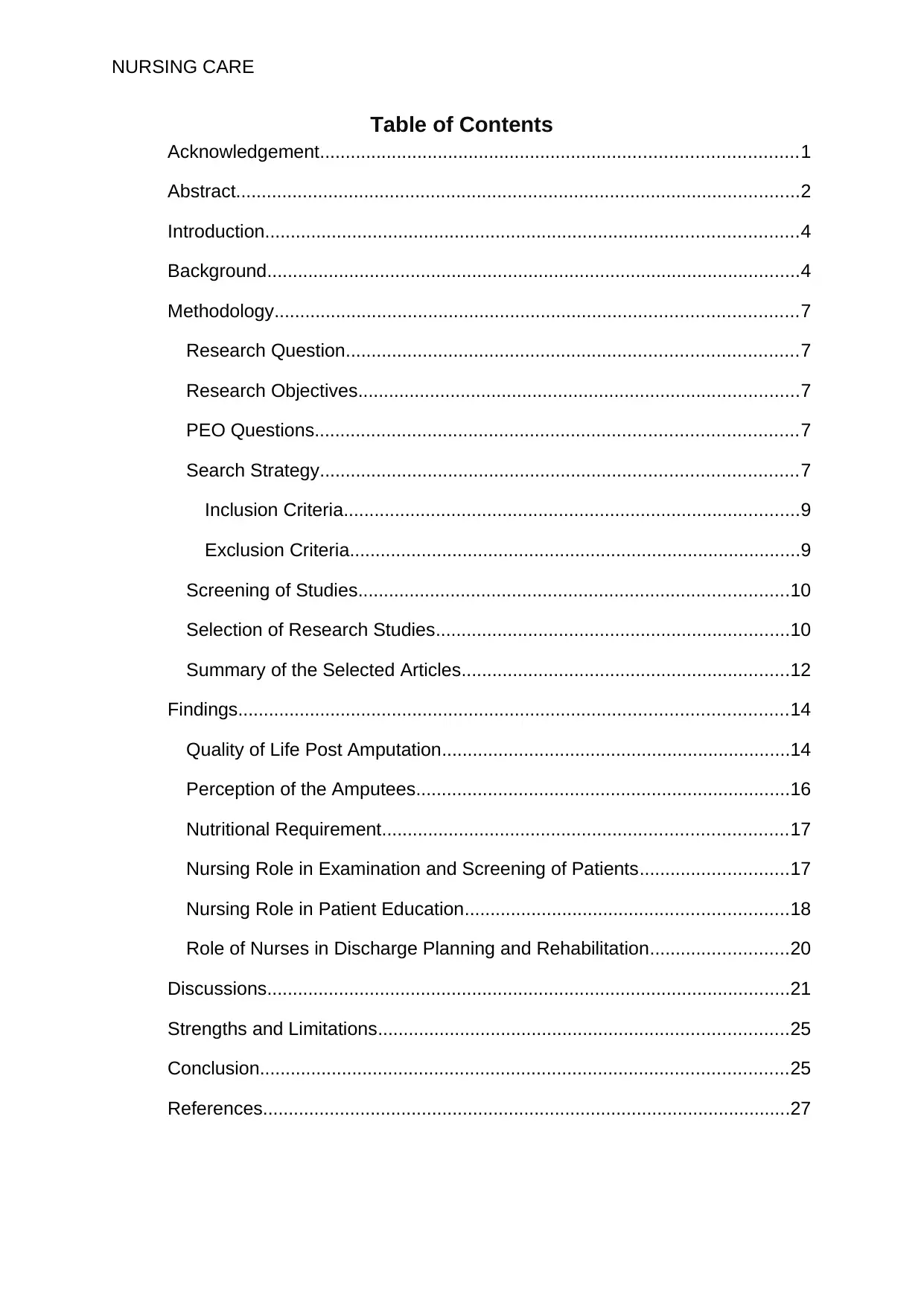
NURSING CARE
Table of Contents
Acknowledgement.............................................................................................1
Abstract..............................................................................................................2
Introduction........................................................................................................4
Background........................................................................................................4
Methodology......................................................................................................7
Research Question........................................................................................7
Research Objectives......................................................................................7
PEO Questions..............................................................................................7
Search Strategy.............................................................................................7
Inclusion Criteria.........................................................................................9
Exclusion Criteria........................................................................................9
Screening of Studies....................................................................................10
Selection of Research Studies.....................................................................10
Summary of the Selected Articles................................................................12
Findings...........................................................................................................14
Quality of Life Post Amputation....................................................................14
Perception of the Amputees.........................................................................16
Nutritional Requirement...............................................................................17
Nursing Role in Examination and Screening of Patients.............................17
Nursing Role in Patient Education...............................................................18
Role of Nurses in Discharge Planning and Rehabilitation...........................20
Discussions......................................................................................................21
Strengths and Limitations................................................................................25
Conclusion.......................................................................................................25
References.......................................................................................................27
Table of Contents
Acknowledgement.............................................................................................1
Abstract..............................................................................................................2
Introduction........................................................................................................4
Background........................................................................................................4
Methodology......................................................................................................7
Research Question........................................................................................7
Research Objectives......................................................................................7
PEO Questions..............................................................................................7
Search Strategy.............................................................................................7
Inclusion Criteria.........................................................................................9
Exclusion Criteria........................................................................................9
Screening of Studies....................................................................................10
Selection of Research Studies.....................................................................10
Summary of the Selected Articles................................................................12
Findings...........................................................................................................14
Quality of Life Post Amputation....................................................................14
Perception of the Amputees.........................................................................16
Nutritional Requirement...............................................................................17
Nursing Role in Examination and Screening of Patients.............................17
Nursing Role in Patient Education...............................................................18
Role of Nurses in Discharge Planning and Rehabilitation...........................20
Discussions......................................................................................................21
Strengths and Limitations................................................................................25
Conclusion.......................................................................................................25
References.......................................................................................................27
Secure Best Marks with AI Grader
Need help grading? Try our AI Grader for instant feedback on your assignments.
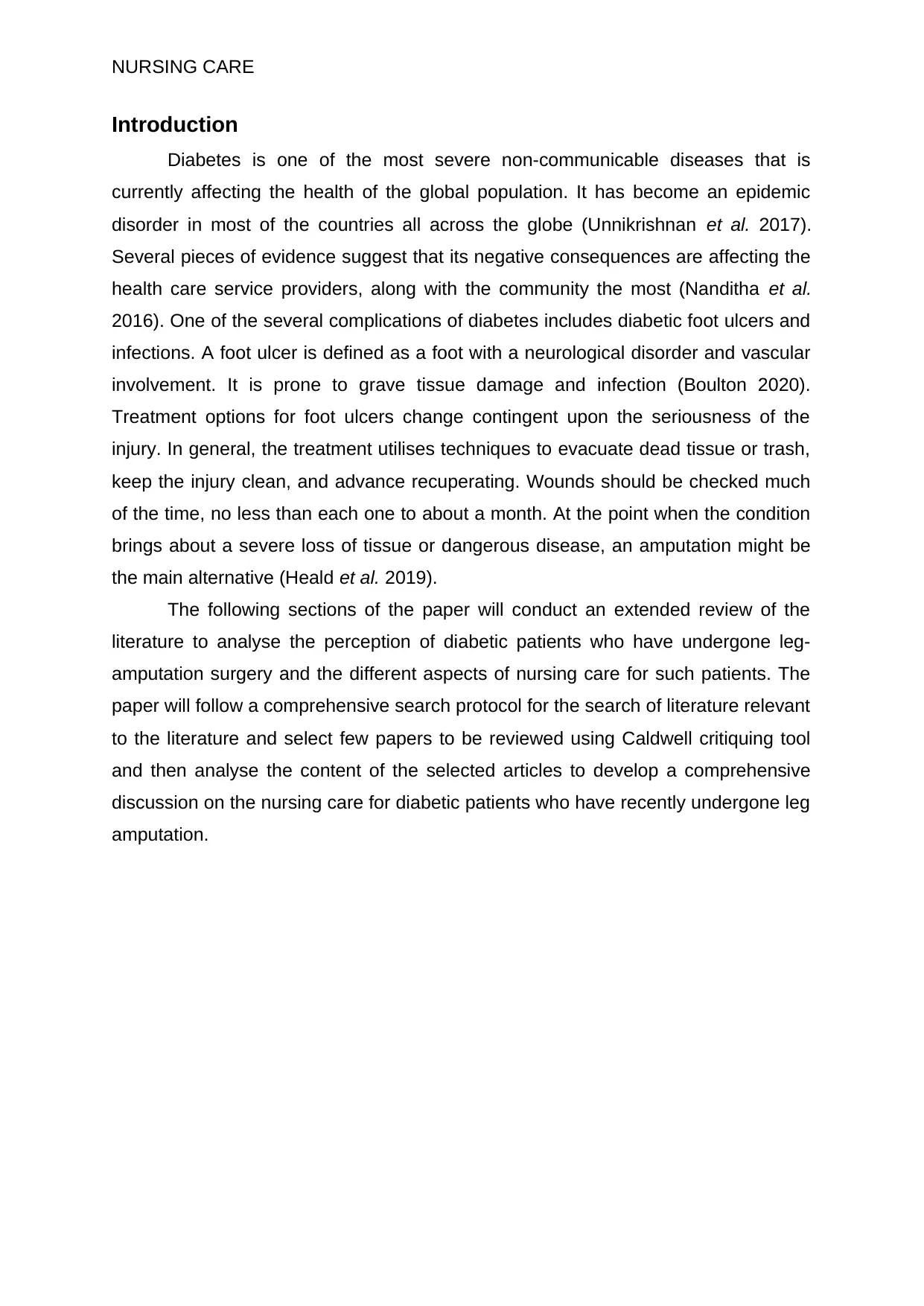
NURSING CARE
Introduction
Diabetes is one of the most severe non-communicable diseases that is
currently affecting the health of the global population. It has become an epidemic
disorder in most of the countries all across the globe (Unnikrishnan et al. 2017).
Several pieces of evidence suggest that its negative consequences are affecting the
health care service providers, along with the community the most (Nanditha et al.
2016). One of the several complications of diabetes includes diabetic foot ulcers and
infections. A foot ulcer is defined as a foot with a neurological disorder and vascular
involvement. It is prone to grave tissue damage and infection (Boulton 2020).
Treatment options for foot ulcers change contingent upon the seriousness of the
injury. In general, the treatment utilises techniques to evacuate dead tissue or trash,
keep the injury clean, and advance recuperating. Wounds should be checked much
of the time, no less than each one to about a month. At the point when the condition
brings about a severe loss of tissue or dangerous disease, an amputation might be
the main alternative (Heald et al. 2019).
The following sections of the paper will conduct an extended review of the
literature to analyse the perception of diabetic patients who have undergone leg-
amputation surgery and the different aspects of nursing care for such patients. The
paper will follow a comprehensive search protocol for the search of literature relevant
to the literature and select few papers to be reviewed using Caldwell critiquing tool
and then analyse the content of the selected articles to develop a comprehensive
discussion on the nursing care for diabetic patients who have recently undergone leg
amputation.
Introduction
Diabetes is one of the most severe non-communicable diseases that is
currently affecting the health of the global population. It has become an epidemic
disorder in most of the countries all across the globe (Unnikrishnan et al. 2017).
Several pieces of evidence suggest that its negative consequences are affecting the
health care service providers, along with the community the most (Nanditha et al.
2016). One of the several complications of diabetes includes diabetic foot ulcers and
infections. A foot ulcer is defined as a foot with a neurological disorder and vascular
involvement. It is prone to grave tissue damage and infection (Boulton 2020).
Treatment options for foot ulcers change contingent upon the seriousness of the
injury. In general, the treatment utilises techniques to evacuate dead tissue or trash,
keep the injury clean, and advance recuperating. Wounds should be checked much
of the time, no less than each one to about a month. At the point when the condition
brings about a severe loss of tissue or dangerous disease, an amputation might be
the main alternative (Heald et al. 2019).
The following sections of the paper will conduct an extended review of the
literature to analyse the perception of diabetic patients who have undergone leg-
amputation surgery and the different aspects of nursing care for such patients. The
paper will follow a comprehensive search protocol for the search of literature relevant
to the literature and select few papers to be reviewed using Caldwell critiquing tool
and then analyse the content of the selected articles to develop a comprehensive
discussion on the nursing care for diabetic patients who have recently undergone leg
amputation.
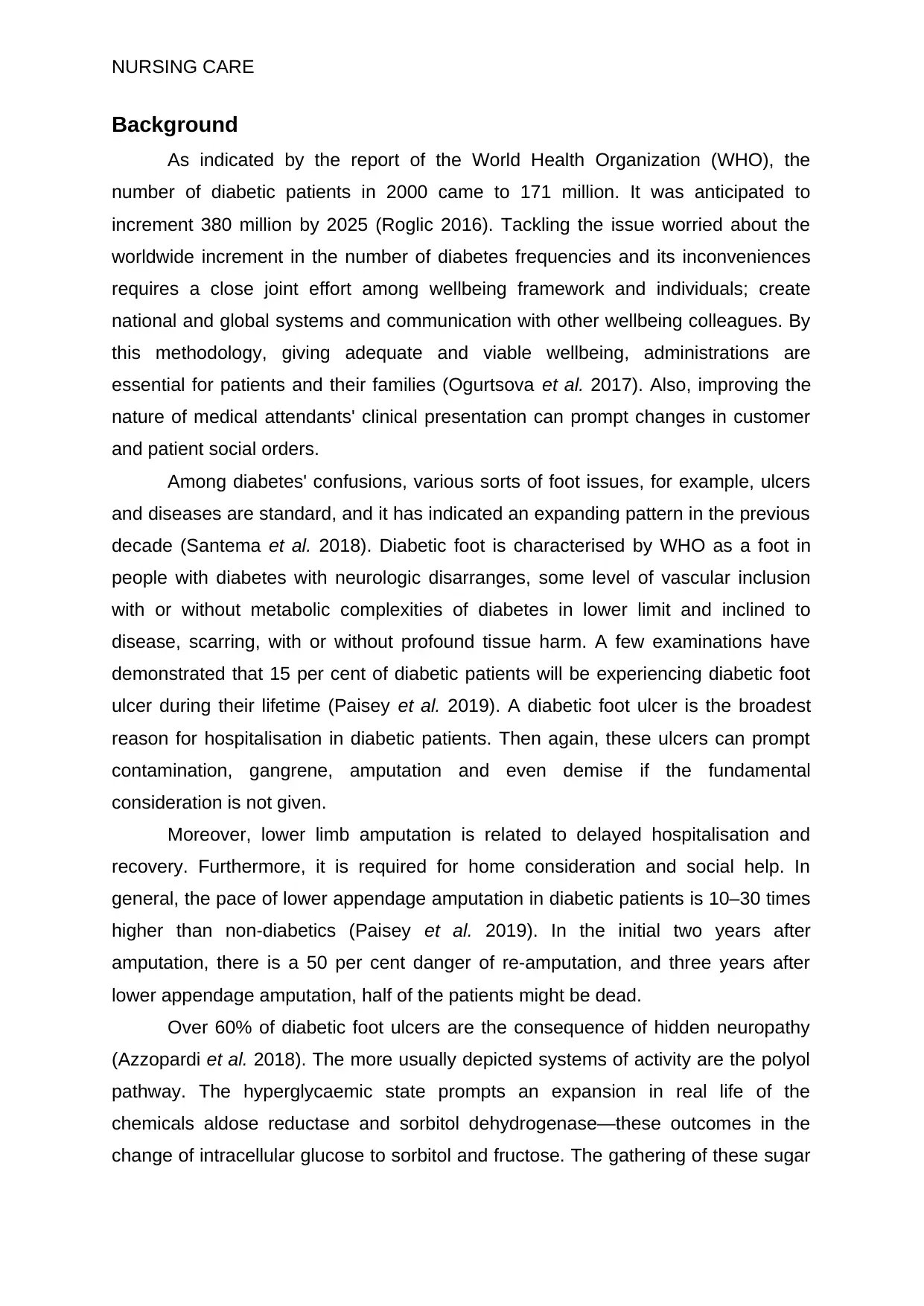
NURSING CARE
Background
As indicated by the report of the World Health Organization (WHO), the
number of diabetic patients in 2000 came to 171 million. It was anticipated to
increment 380 million by 2025 (Roglic 2016). Tackling the issue worried about the
worldwide increment in the number of diabetes frequencies and its inconveniences
requires a close joint effort among wellbeing framework and individuals; create
national and global systems and communication with other wellbeing colleagues. By
this methodology, giving adequate and viable wellbeing, administrations are
essential for patients and their families (Ogurtsova et al. 2017). Also, improving the
nature of medical attendants' clinical presentation can prompt changes in customer
and patient social orders.
Among diabetes' confusions, various sorts of foot issues, for example, ulcers
and diseases are standard, and it has indicated an expanding pattern in the previous
decade (Santema et al. 2018). Diabetic foot is characterised by WHO as a foot in
people with diabetes with neurologic disarranges, some level of vascular inclusion
with or without metabolic complexities of diabetes in lower limit and inclined to
disease, scarring, with or without profound tissue harm. A few examinations have
demonstrated that 15 per cent of diabetic patients will be experiencing diabetic foot
ulcer during their lifetime (Paisey et al. 2019). A diabetic foot ulcer is the broadest
reason for hospitalisation in diabetic patients. Then again, these ulcers can prompt
contamination, gangrene, amputation and even demise if the fundamental
consideration is not given.
Moreover, lower limb amputation is related to delayed hospitalisation and
recovery. Furthermore, it is required for home consideration and social help. In
general, the pace of lower appendage amputation in diabetic patients is 10–30 times
higher than non-diabetics (Paisey et al. 2019). In the initial two years after
amputation, there is a 50 per cent danger of re-amputation, and three years after
lower appendage amputation, half of the patients might be dead.
Over 60% of diabetic foot ulcers are the consequence of hidden neuropathy
(Azzopardi et al. 2018). The more usually depicted systems of activity are the polyol
pathway. The hyperglycaemic state prompts an expansion in real life of the
chemicals aldose reductase and sorbitol dehydrogenase—these outcomes in the
change of intracellular glucose to sorbitol and fructose. The gathering of these sugar
Background
As indicated by the report of the World Health Organization (WHO), the
number of diabetic patients in 2000 came to 171 million. It was anticipated to
increment 380 million by 2025 (Roglic 2016). Tackling the issue worried about the
worldwide increment in the number of diabetes frequencies and its inconveniences
requires a close joint effort among wellbeing framework and individuals; create
national and global systems and communication with other wellbeing colleagues. By
this methodology, giving adequate and viable wellbeing, administrations are
essential for patients and their families (Ogurtsova et al. 2017). Also, improving the
nature of medical attendants' clinical presentation can prompt changes in customer
and patient social orders.
Among diabetes' confusions, various sorts of foot issues, for example, ulcers
and diseases are standard, and it has indicated an expanding pattern in the previous
decade (Santema et al. 2018). Diabetic foot is characterised by WHO as a foot in
people with diabetes with neurologic disarranges, some level of vascular inclusion
with or without metabolic complexities of diabetes in lower limit and inclined to
disease, scarring, with or without profound tissue harm. A few examinations have
demonstrated that 15 per cent of diabetic patients will be experiencing diabetic foot
ulcer during their lifetime (Paisey et al. 2019). A diabetic foot ulcer is the broadest
reason for hospitalisation in diabetic patients. Then again, these ulcers can prompt
contamination, gangrene, amputation and even demise if the fundamental
consideration is not given.
Moreover, lower limb amputation is related to delayed hospitalisation and
recovery. Furthermore, it is required for home consideration and social help. In
general, the pace of lower appendage amputation in diabetic patients is 10–30 times
higher than non-diabetics (Paisey et al. 2019). In the initial two years after
amputation, there is a 50 per cent danger of re-amputation, and three years after
lower appendage amputation, half of the patients might be dead.
Over 60% of diabetic foot ulcers are the consequence of hidden neuropathy
(Azzopardi et al. 2018). The more usually depicted systems of activity are the polyol
pathway. The hyperglycaemic state prompts an expansion in real life of the
chemicals aldose reductase and sorbitol dehydrogenase—these outcomes in the
change of intracellular glucose to sorbitol and fructose. The gathering of these sugar
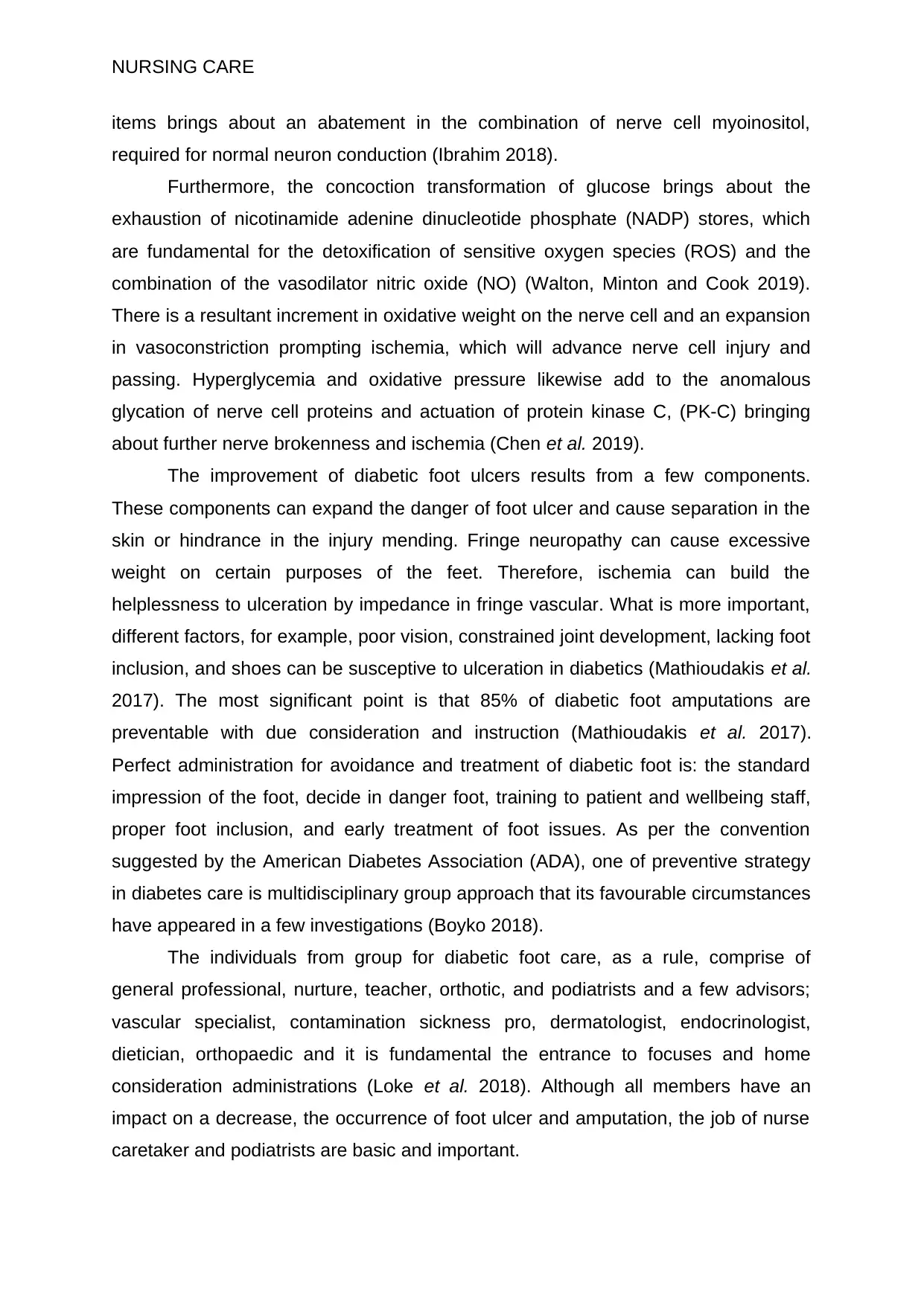
NURSING CARE
items brings about an abatement in the combination of nerve cell myoinositol,
required for normal neuron conduction (Ibrahim 2018).
Furthermore, the concoction transformation of glucose brings about the
exhaustion of nicotinamide adenine dinucleotide phosphate (NADP) stores, which
are fundamental for the detoxification of sensitive oxygen species (ROS) and the
combination of the vasodilator nitric oxide (NO) (Walton, Minton and Cook 2019).
There is a resultant increment in oxidative weight on the nerve cell and an expansion
in vasoconstriction prompting ischemia, which will advance nerve cell injury and
passing. Hyperglycemia and oxidative pressure likewise add to the anomalous
glycation of nerve cell proteins and actuation of protein kinase C, (PK-C) bringing
about further nerve brokenness and ischemia (Chen et al. 2019).
The improvement of diabetic foot ulcers results from a few components.
These components can expand the danger of foot ulcer and cause separation in the
skin or hindrance in the injury mending. Fringe neuropathy can cause excessive
weight on certain purposes of the feet. Therefore, ischemia can build the
helplessness to ulceration by impedance in fringe vascular. What is more important,
different factors, for example, poor vision, constrained joint development, lacking foot
inclusion, and shoes can be susceptive to ulceration in diabetics (Mathioudakis et al.
2017). The most significant point is that 85% of diabetic foot amputations are
preventable with due consideration and instruction (Mathioudakis et al. 2017).
Perfect administration for avoidance and treatment of diabetic foot is: the standard
impression of the foot, decide in danger foot, training to patient and wellbeing staff,
proper foot inclusion, and early treatment of foot issues. As per the convention
suggested by the American Diabetes Association (ADA), one of preventive strategy
in diabetes care is multidisciplinary group approach that its favourable circumstances
have appeared in a few investigations (Boyko 2018).
The individuals from group for diabetic foot care, as a rule, comprise of
general professional, nurture, teacher, orthotic, and podiatrists and a few advisors;
vascular specialist, contamination sickness pro, dermatologist, endocrinologist,
dietician, orthopaedic and it is fundamental the entrance to focuses and home
consideration administrations (Loke et al. 2018). Although all members have an
impact on a decrease, the occurrence of foot ulcer and amputation, the job of nurse
caretaker and podiatrists are basic and important.
items brings about an abatement in the combination of nerve cell myoinositol,
required for normal neuron conduction (Ibrahim 2018).
Furthermore, the concoction transformation of glucose brings about the
exhaustion of nicotinamide adenine dinucleotide phosphate (NADP) stores, which
are fundamental for the detoxification of sensitive oxygen species (ROS) and the
combination of the vasodilator nitric oxide (NO) (Walton, Minton and Cook 2019).
There is a resultant increment in oxidative weight on the nerve cell and an expansion
in vasoconstriction prompting ischemia, which will advance nerve cell injury and
passing. Hyperglycemia and oxidative pressure likewise add to the anomalous
glycation of nerve cell proteins and actuation of protein kinase C, (PK-C) bringing
about further nerve brokenness and ischemia (Chen et al. 2019).
The improvement of diabetic foot ulcers results from a few components.
These components can expand the danger of foot ulcer and cause separation in the
skin or hindrance in the injury mending. Fringe neuropathy can cause excessive
weight on certain purposes of the feet. Therefore, ischemia can build the
helplessness to ulceration by impedance in fringe vascular. What is more important,
different factors, for example, poor vision, constrained joint development, lacking foot
inclusion, and shoes can be susceptive to ulceration in diabetics (Mathioudakis et al.
2017). The most significant point is that 85% of diabetic foot amputations are
preventable with due consideration and instruction (Mathioudakis et al. 2017).
Perfect administration for avoidance and treatment of diabetic foot is: the standard
impression of the foot, decide in danger foot, training to patient and wellbeing staff,
proper foot inclusion, and early treatment of foot issues. As per the convention
suggested by the American Diabetes Association (ADA), one of preventive strategy
in diabetes care is multidisciplinary group approach that its favourable circumstances
have appeared in a few investigations (Boyko 2018).
The individuals from group for diabetic foot care, as a rule, comprise of
general professional, nurture, teacher, orthotic, and podiatrists and a few advisors;
vascular specialist, contamination sickness pro, dermatologist, endocrinologist,
dietician, orthopaedic and it is fundamental the entrance to focuses and home
consideration administrations (Loke et al. 2018). Although all members have an
impact on a decrease, the occurrence of foot ulcer and amputation, the job of nurse
caretaker and podiatrists are basic and important.
Paraphrase This Document
Need a fresh take? Get an instant paraphrase of this document with our AI Paraphraser
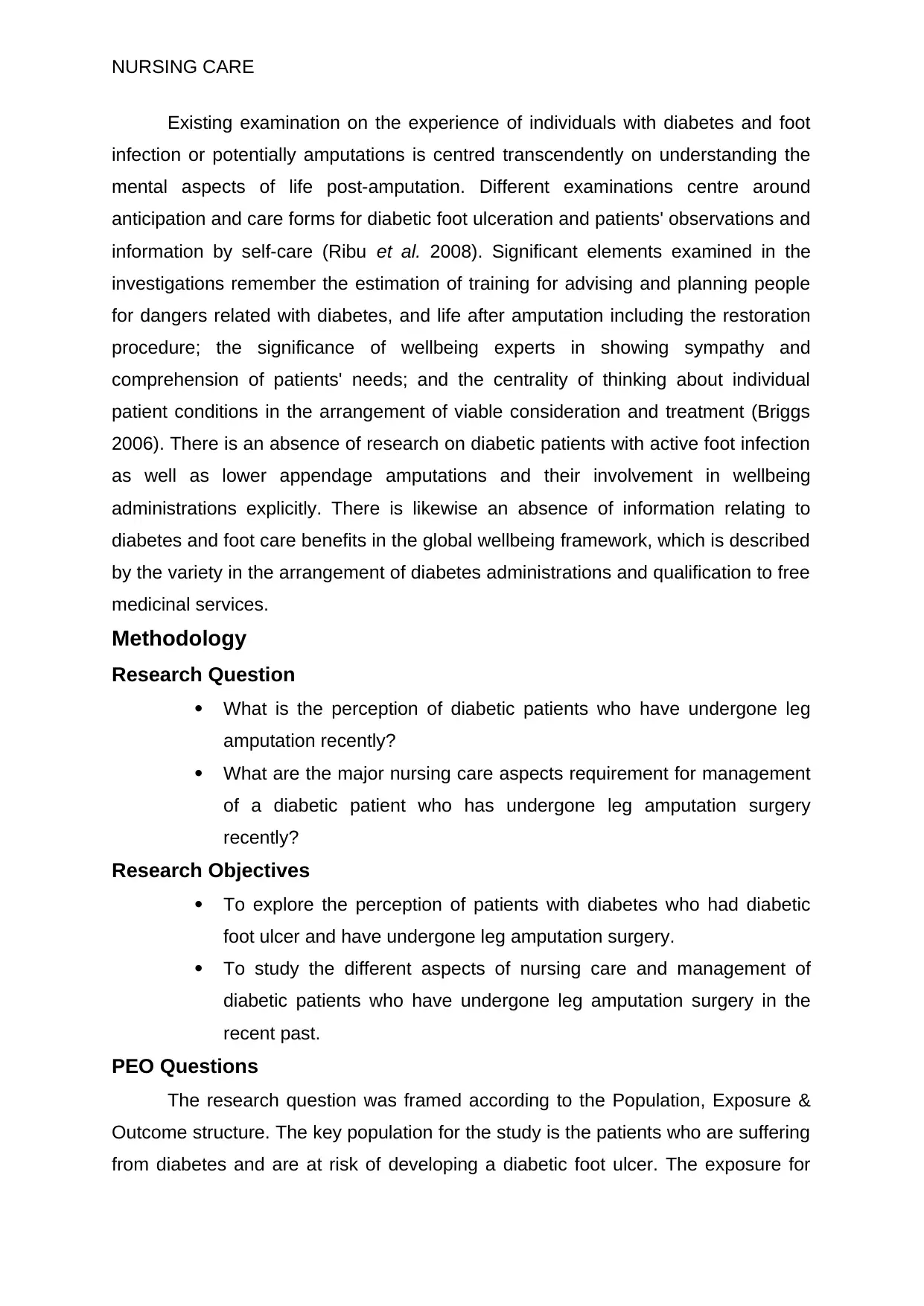
NURSING CARE
Existing examination on the experience of individuals with diabetes and foot
infection or potentially amputations is centred transcendently on understanding the
mental aspects of life post-amputation. Different examinations centre around
anticipation and care forms for diabetic foot ulceration and patients' observations and
information by self-care (Ribu et al. 2008). Significant elements examined in the
investigations remember the estimation of training for advising and planning people
for dangers related with diabetes, and life after amputation including the restoration
procedure; the significance of wellbeing experts in showing sympathy and
comprehension of patients' needs; and the centrality of thinking about individual
patient conditions in the arrangement of viable consideration and treatment (Briggs
2006). There is an absence of research on diabetic patients with active foot infection
as well as lower appendage amputations and their involvement in wellbeing
administrations explicitly. There is likewise an absence of information relating to
diabetes and foot care benefits in the global wellbeing framework, which is described
by the variety in the arrangement of diabetes administrations and qualification to free
medicinal services.
Methodology
Research Question
What is the perception of diabetic patients who have undergone leg
amputation recently?
What are the major nursing care aspects requirement for management
of a diabetic patient who has undergone leg amputation surgery
recently?
Research Objectives
To explore the perception of patients with diabetes who had diabetic
foot ulcer and have undergone leg amputation surgery.
To study the different aspects of nursing care and management of
diabetic patients who have undergone leg amputation surgery in the
recent past.
PEO Questions
The research question was framed according to the Population, Exposure &
Outcome structure. The key population for the study is the patients who are suffering
from diabetes and are at risk of developing a diabetic foot ulcer. The exposure for
Existing examination on the experience of individuals with diabetes and foot
infection or potentially amputations is centred transcendently on understanding the
mental aspects of life post-amputation. Different examinations centre around
anticipation and care forms for diabetic foot ulceration and patients' observations and
information by self-care (Ribu et al. 2008). Significant elements examined in the
investigations remember the estimation of training for advising and planning people
for dangers related with diabetes, and life after amputation including the restoration
procedure; the significance of wellbeing experts in showing sympathy and
comprehension of patients' needs; and the centrality of thinking about individual
patient conditions in the arrangement of viable consideration and treatment (Briggs
2006). There is an absence of research on diabetic patients with active foot infection
as well as lower appendage amputations and their involvement in wellbeing
administrations explicitly. There is likewise an absence of information relating to
diabetes and foot care benefits in the global wellbeing framework, which is described
by the variety in the arrangement of diabetes administrations and qualification to free
medicinal services.
Methodology
Research Question
What is the perception of diabetic patients who have undergone leg
amputation recently?
What are the major nursing care aspects requirement for management
of a diabetic patient who has undergone leg amputation surgery
recently?
Research Objectives
To explore the perception of patients with diabetes who had diabetic
foot ulcer and have undergone leg amputation surgery.
To study the different aspects of nursing care and management of
diabetic patients who have undergone leg amputation surgery in the
recent past.
PEO Questions
The research question was framed according to the Population, Exposure &
Outcome structure. The key population for the study is the patients who are suffering
from diabetes and are at risk of developing a diabetic foot ulcer. The exposure for
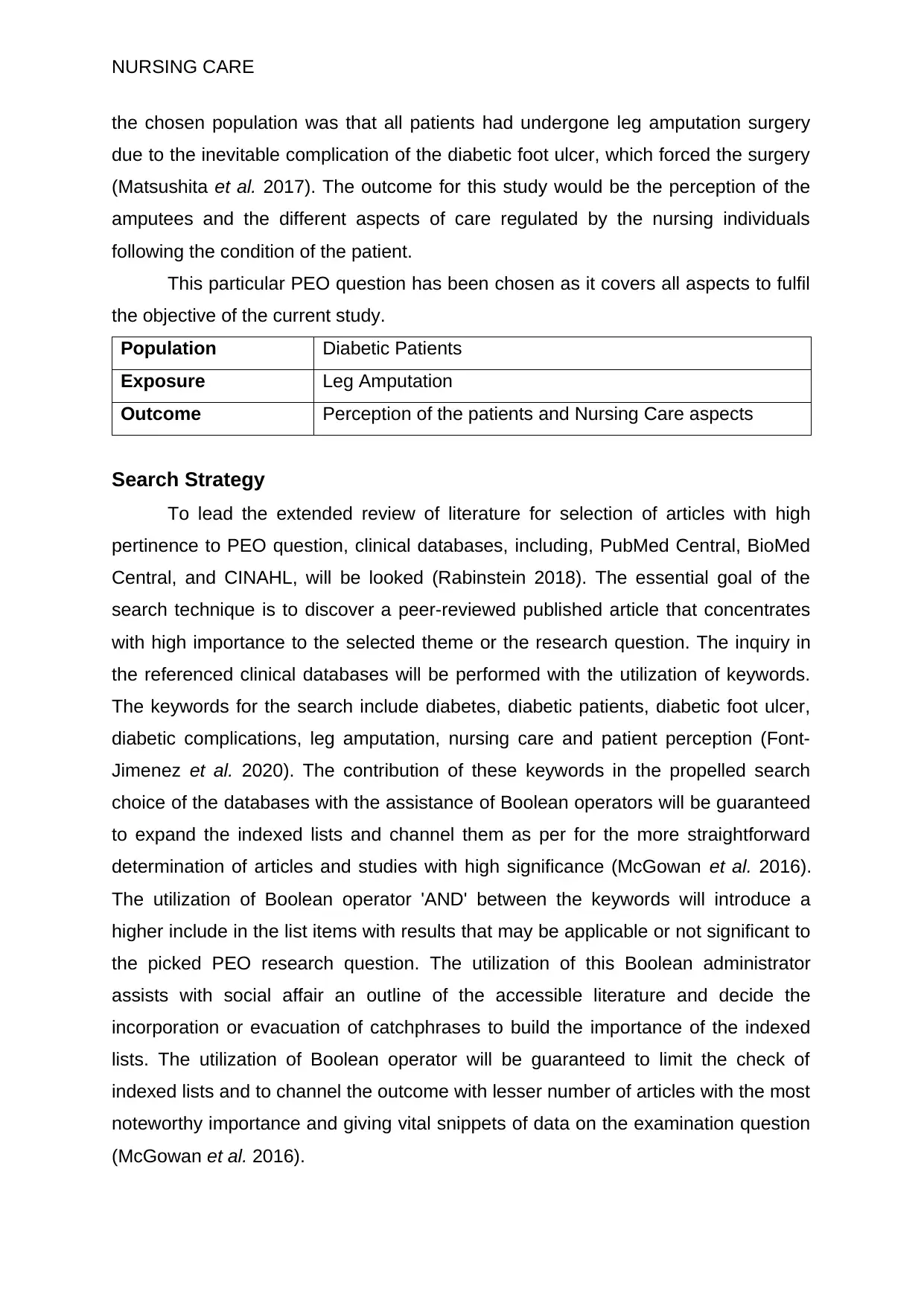
NURSING CARE
the chosen population was that all patients had undergone leg amputation surgery
due to the inevitable complication of the diabetic foot ulcer, which forced the surgery
(Matsushita et al. 2017). The outcome for this study would be the perception of the
amputees and the different aspects of care regulated by the nursing individuals
following the condition of the patient.
This particular PEO question has been chosen as it covers all aspects to fulfil
the objective of the current study.
Population Diabetic Patients
Exposure Leg Amputation
Outcome Perception of the patients and Nursing Care aspects
Search Strategy
To lead the extended review of literature for selection of articles with high
pertinence to PEO question, clinical databases, including, PubMed Central, BioMed
Central, and CINAHL, will be looked (Rabinstein 2018). The essential goal of the
search technique is to discover a peer-reviewed published article that concentrates
with high importance to the selected theme or the research question. The inquiry in
the referenced clinical databases will be performed with the utilization of keywords.
The keywords for the search include diabetes, diabetic patients, diabetic foot ulcer,
diabetic complications, leg amputation, nursing care and patient perception (Font-
Jimenez et al. 2020). The contribution of these keywords in the propelled search
choice of the databases with the assistance of Boolean operators will be guaranteed
to expand the indexed lists and channel them as per for the more straightforward
determination of articles and studies with high significance (McGowan et al. 2016).
The utilization of Boolean operator 'AND' between the keywords will introduce a
higher include in the list items with results that may be applicable or not significant to
the picked PEO research question. The utilization of this Boolean administrator
assists with social affair an outline of the accessible literature and decide the
incorporation or evacuation of catchphrases to build the importance of the indexed
lists. The utilization of Boolean operator will be guaranteed to limit the check of
indexed lists and to channel the outcome with lesser number of articles with the most
noteworthy importance and giving vital snippets of data on the examination question
(McGowan et al. 2016).
the chosen population was that all patients had undergone leg amputation surgery
due to the inevitable complication of the diabetic foot ulcer, which forced the surgery
(Matsushita et al. 2017). The outcome for this study would be the perception of the
amputees and the different aspects of care regulated by the nursing individuals
following the condition of the patient.
This particular PEO question has been chosen as it covers all aspects to fulfil
the objective of the current study.
Population Diabetic Patients
Exposure Leg Amputation
Outcome Perception of the patients and Nursing Care aspects
Search Strategy
To lead the extended review of literature for selection of articles with high
pertinence to PEO question, clinical databases, including, PubMed Central, BioMed
Central, and CINAHL, will be looked (Rabinstein 2018). The essential goal of the
search technique is to discover a peer-reviewed published article that concentrates
with high importance to the selected theme or the research question. The inquiry in
the referenced clinical databases will be performed with the utilization of keywords.
The keywords for the search include diabetes, diabetic patients, diabetic foot ulcer,
diabetic complications, leg amputation, nursing care and patient perception (Font-
Jimenez et al. 2020). The contribution of these keywords in the propelled search
choice of the databases with the assistance of Boolean operators will be guaranteed
to expand the indexed lists and channel them as per for the more straightforward
determination of articles and studies with high significance (McGowan et al. 2016).
The utilization of Boolean operator 'AND' between the keywords will introduce a
higher include in the list items with results that may be applicable or not significant to
the picked PEO research question. The utilization of this Boolean administrator
assists with social affair an outline of the accessible literature and decide the
incorporation or evacuation of catchphrases to build the importance of the indexed
lists. The utilization of Boolean operator will be guaranteed to limit the check of
indexed lists and to channel the outcome with lesser number of articles with the most
noteworthy importance and giving vital snippets of data on the examination question
(McGowan et al. 2016).
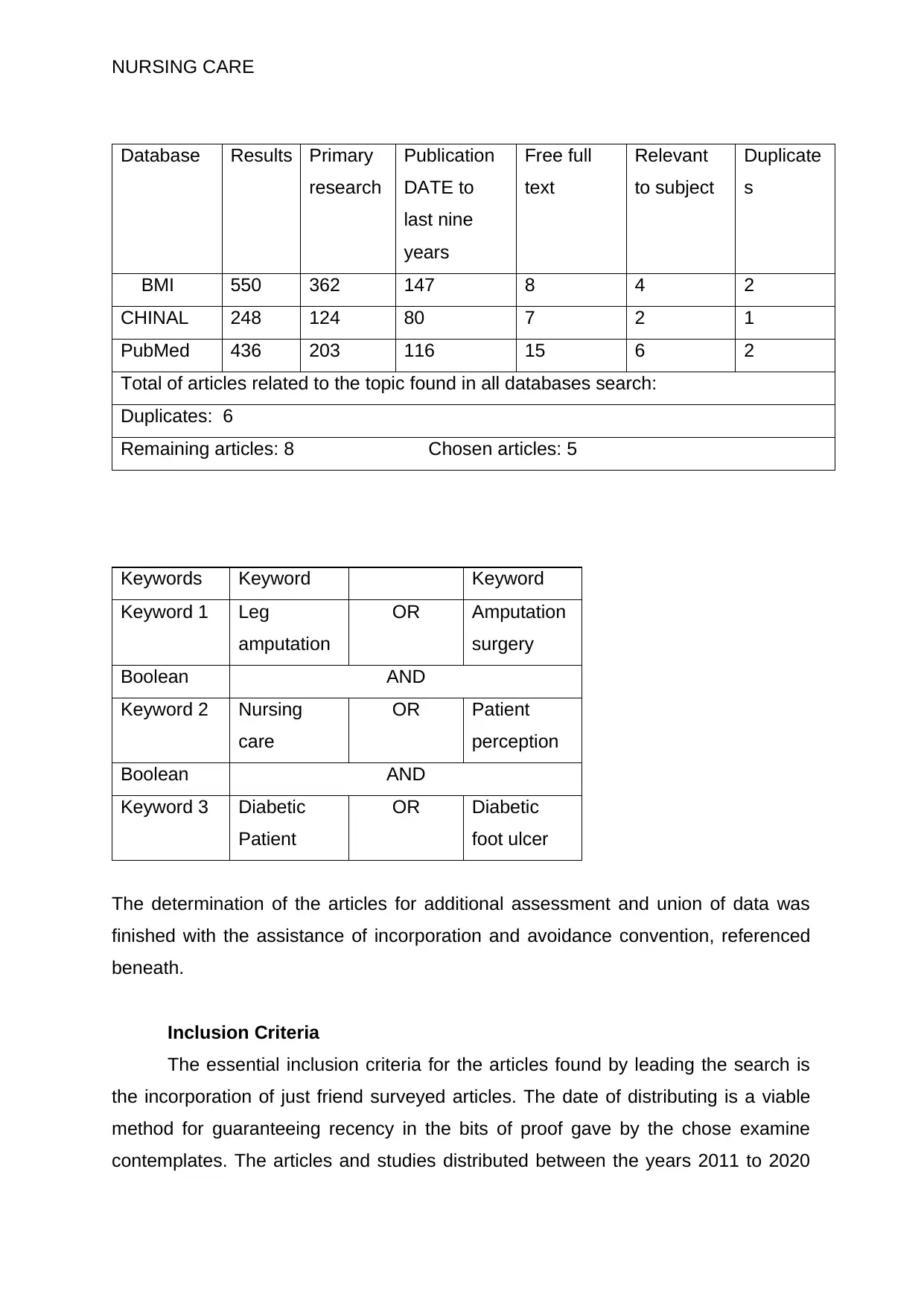
NURSING CARE
Database Results Primary
research
Publication
DATE to
last nine
years
Free full
text
Relevant
to subject
Duplicate
s
BMI 550 362 147 8 4 2
CHINAL 248 124 80 7 2 1
PubMed 436 203 116 15 6 2
Total of articles related to the topic found in all databases search:
Duplicates: 6
Remaining articles: 8 Chosen articles: 5
Keywords Keyword Keyword
Keyword 1 Leg
amputation
OR Amputation
surgery
Boolean AND
Keyword 2 Nursing
care
OR Patient
perception
Boolean AND
Keyword 3 Diabetic
Patient
OR Diabetic
foot ulcer
The determination of the articles for additional assessment and union of data was
finished with the assistance of incorporation and avoidance convention, referenced
beneath.
Inclusion Criteria
The essential inclusion criteria for the articles found by leading the search is
the incorporation of just friend surveyed articles. The date of distributing is a viable
method for guaranteeing recency in the bits of proof gave by the chose examine
contemplates. The articles and studies distributed between the years 2011 to 2020
Database Results Primary
research
Publication
DATE to
last nine
years
Free full
text
Relevant
to subject
Duplicate
s
BMI 550 362 147 8 4 2
CHINAL 248 124 80 7 2 1
PubMed 436 203 116 15 6 2
Total of articles related to the topic found in all databases search:
Duplicates: 6
Remaining articles: 8 Chosen articles: 5
Keywords Keyword Keyword
Keyword 1 Leg
amputation
OR Amputation
surgery
Boolean AND
Keyword 2 Nursing
care
OR Patient
perception
Boolean AND
Keyword 3 Diabetic
Patient
OR Diabetic
foot ulcer
The determination of the articles for additional assessment and union of data was
finished with the assistance of incorporation and avoidance convention, referenced
beneath.
Inclusion Criteria
The essential inclusion criteria for the articles found by leading the search is
the incorporation of just friend surveyed articles. The date of distributing is a viable
method for guaranteeing recency in the bits of proof gave by the chose examine
contemplates. The articles and studies distributed between the years 2011 to 2020
Secure Best Marks with AI Grader
Need help grading? Try our AI Grader for instant feedback on your assignments.
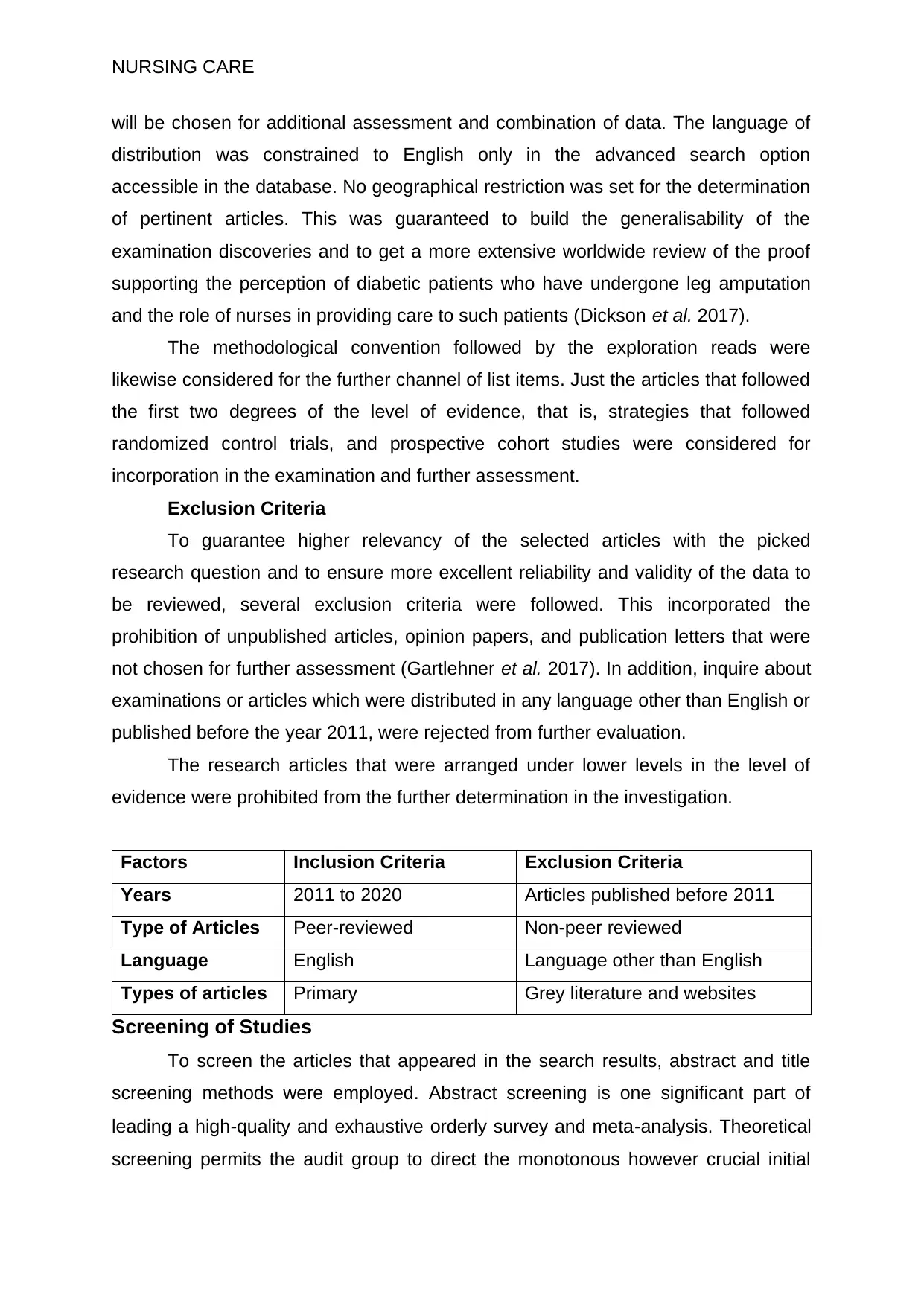
NURSING CARE
will be chosen for additional assessment and combination of data. The language of
distribution was constrained to English only in the advanced search option
accessible in the database. No geographical restriction was set for the determination
of pertinent articles. This was guaranteed to build the generalisability of the
examination discoveries and to get a more extensive worldwide review of the proof
supporting the perception of diabetic patients who have undergone leg amputation
and the role of nurses in providing care to such patients (Dickson et al. 2017).
The methodological convention followed by the exploration reads were
likewise considered for the further channel of list items. Just the articles that followed
the first two degrees of the level of evidence, that is, strategies that followed
randomized control trials, and prospective cohort studies were considered for
incorporation in the examination and further assessment.
Exclusion Criteria
To guarantee higher relevancy of the selected articles with the picked
research question and to ensure more excellent reliability and validity of the data to
be reviewed, several exclusion criteria were followed. This incorporated the
prohibition of unpublished articles, opinion papers, and publication letters that were
not chosen for further assessment (Gartlehner et al. 2017). In addition, inquire about
examinations or articles which were distributed in any language other than English or
published before the year 2011, were rejected from further evaluation.
The research articles that were arranged under lower levels in the level of
evidence were prohibited from the further determination in the investigation.
Factors Inclusion Criteria Exclusion Criteria
Years 2011 to 2020 Articles published before 2011
Type of Articles Peer-reviewed Non-peer reviewed
Language English Language other than English
Types of articles Primary Grey literature and websites
Screening of Studies
To screen the articles that appeared in the search results, abstract and title
screening methods were employed. Abstract screening is one significant part of
leading a high‐quality and exhaustive orderly survey and meta‐analysis. Theoretical
screening permits the audit group to direct the monotonous however crucial initial
will be chosen for additional assessment and combination of data. The language of
distribution was constrained to English only in the advanced search option
accessible in the database. No geographical restriction was set for the determination
of pertinent articles. This was guaranteed to build the generalisability of the
examination discoveries and to get a more extensive worldwide review of the proof
supporting the perception of diabetic patients who have undergone leg amputation
and the role of nurses in providing care to such patients (Dickson et al. 2017).
The methodological convention followed by the exploration reads were
likewise considered for the further channel of list items. Just the articles that followed
the first two degrees of the level of evidence, that is, strategies that followed
randomized control trials, and prospective cohort studies were considered for
incorporation in the examination and further assessment.
Exclusion Criteria
To guarantee higher relevancy of the selected articles with the picked
research question and to ensure more excellent reliability and validity of the data to
be reviewed, several exclusion criteria were followed. This incorporated the
prohibition of unpublished articles, opinion papers, and publication letters that were
not chosen for further assessment (Gartlehner et al. 2017). In addition, inquire about
examinations or articles which were distributed in any language other than English or
published before the year 2011, were rejected from further evaluation.
The research articles that were arranged under lower levels in the level of
evidence were prohibited from the further determination in the investigation.
Factors Inclusion Criteria Exclusion Criteria
Years 2011 to 2020 Articles published before 2011
Type of Articles Peer-reviewed Non-peer reviewed
Language English Language other than English
Types of articles Primary Grey literature and websites
Screening of Studies
To screen the articles that appeared in the search results, abstract and title
screening methods were employed. Abstract screening is one significant part of
leading a high‐quality and exhaustive orderly survey and meta‐analysis. Theoretical
screening permits the audit group to direct the monotonous however crucial initial
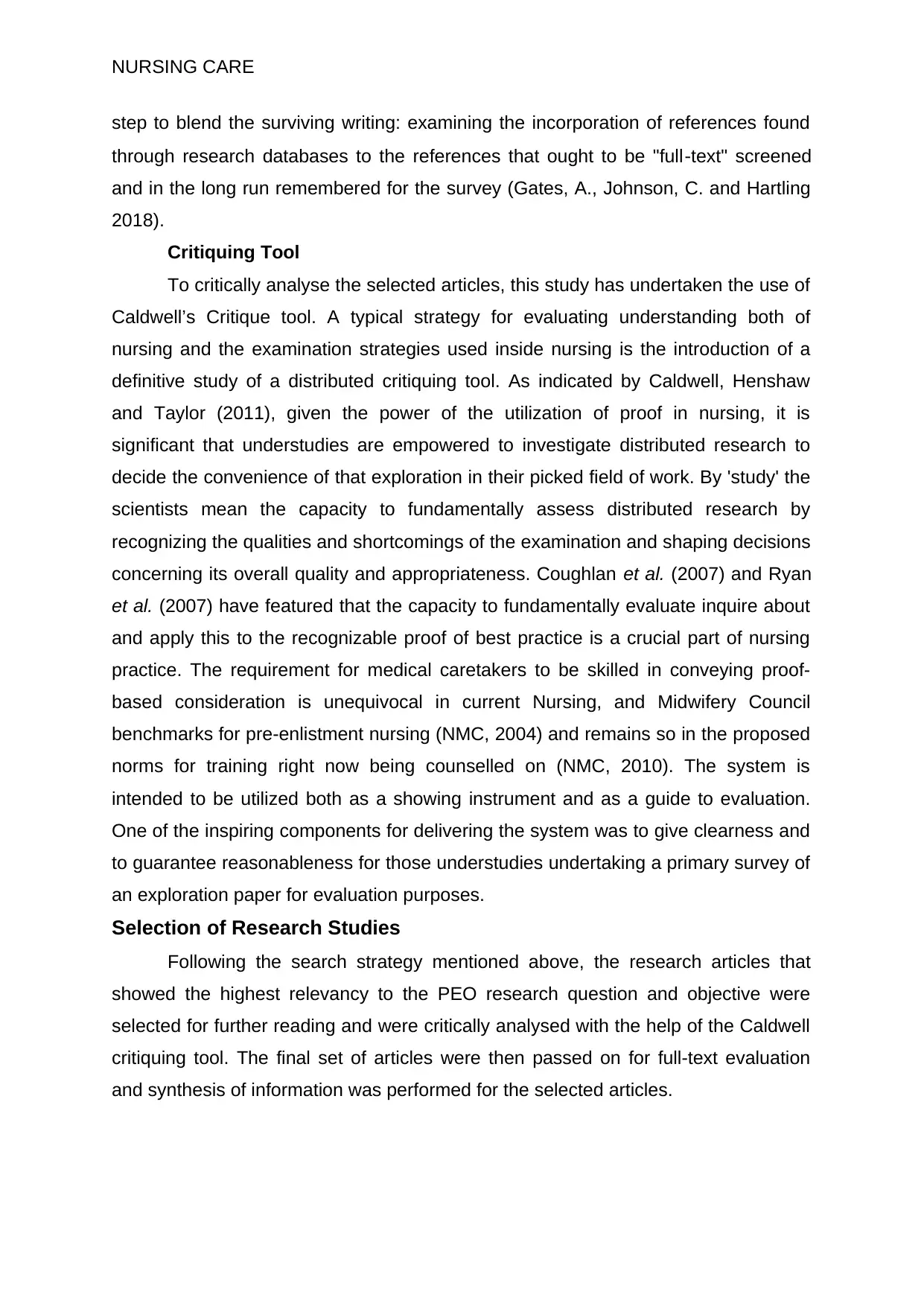
NURSING CARE
step to blend the surviving writing: examining the incorporation of references found
through research databases to the references that ought to be "full‐text" screened
and in the long run remembered for the survey (Gates, A., Johnson, C. and Hartling
2018).
Critiquing Tool
To critically analyse the selected articles, this study has undertaken the use of
Caldwell’s Critique tool. A typical strategy for evaluating understanding both of
nursing and the examination strategies used inside nursing is the introduction of a
definitive study of a distributed critiquing tool. As indicated by Caldwell, Henshaw
and Taylor (2011), given the power of the utilization of proof in nursing, it is
significant that understudies are empowered to investigate distributed research to
decide the convenience of that exploration in their picked field of work. By 'study' the
scientists mean the capacity to fundamentally assess distributed research by
recognizing the qualities and shortcomings of the examination and shaping decisions
concerning its overall quality and appropriateness. Coughlan et al. (2007) and Ryan
et al. (2007) have featured that the capacity to fundamentally evaluate inquire about
and apply this to the recognizable proof of best practice is a crucial part of nursing
practice. The requirement for medical caretakers to be skilled in conveying proof-
based consideration is unequivocal in current Nursing, and Midwifery Council
benchmarks for pre-enlistment nursing (NMC, 2004) and remains so in the proposed
norms for training right now being counselled on (NMC, 2010). The system is
intended to be utilized both as a showing instrument and as a guide to evaluation.
One of the inspiring components for delivering the system was to give clearness and
to guarantee reasonableness for those understudies undertaking a primary survey of
an exploration paper for evaluation purposes.
Selection of Research Studies
Following the search strategy mentioned above, the research articles that
showed the highest relevancy to the PEO research question and objective were
selected for further reading and were critically analysed with the help of the Caldwell
critiquing tool. The final set of articles were then passed on for full-text evaluation
and synthesis of information was performed for the selected articles.
step to blend the surviving writing: examining the incorporation of references found
through research databases to the references that ought to be "full‐text" screened
and in the long run remembered for the survey (Gates, A., Johnson, C. and Hartling
2018).
Critiquing Tool
To critically analyse the selected articles, this study has undertaken the use of
Caldwell’s Critique tool. A typical strategy for evaluating understanding both of
nursing and the examination strategies used inside nursing is the introduction of a
definitive study of a distributed critiquing tool. As indicated by Caldwell, Henshaw
and Taylor (2011), given the power of the utilization of proof in nursing, it is
significant that understudies are empowered to investigate distributed research to
decide the convenience of that exploration in their picked field of work. By 'study' the
scientists mean the capacity to fundamentally assess distributed research by
recognizing the qualities and shortcomings of the examination and shaping decisions
concerning its overall quality and appropriateness. Coughlan et al. (2007) and Ryan
et al. (2007) have featured that the capacity to fundamentally evaluate inquire about
and apply this to the recognizable proof of best practice is a crucial part of nursing
practice. The requirement for medical caretakers to be skilled in conveying proof-
based consideration is unequivocal in current Nursing, and Midwifery Council
benchmarks for pre-enlistment nursing (NMC, 2004) and remains so in the proposed
norms for training right now being counselled on (NMC, 2010). The system is
intended to be utilized both as a showing instrument and as a guide to evaluation.
One of the inspiring components for delivering the system was to give clearness and
to guarantee reasonableness for those understudies undertaking a primary survey of
an exploration paper for evaluation purposes.
Selection of Research Studies
Following the search strategy mentioned above, the research articles that
showed the highest relevancy to the PEO research question and objective were
selected for further reading and were critically analysed with the help of the Caldwell
critiquing tool. The final set of articles were then passed on for full-text evaluation
and synthesis of information was performed for the selected articles.
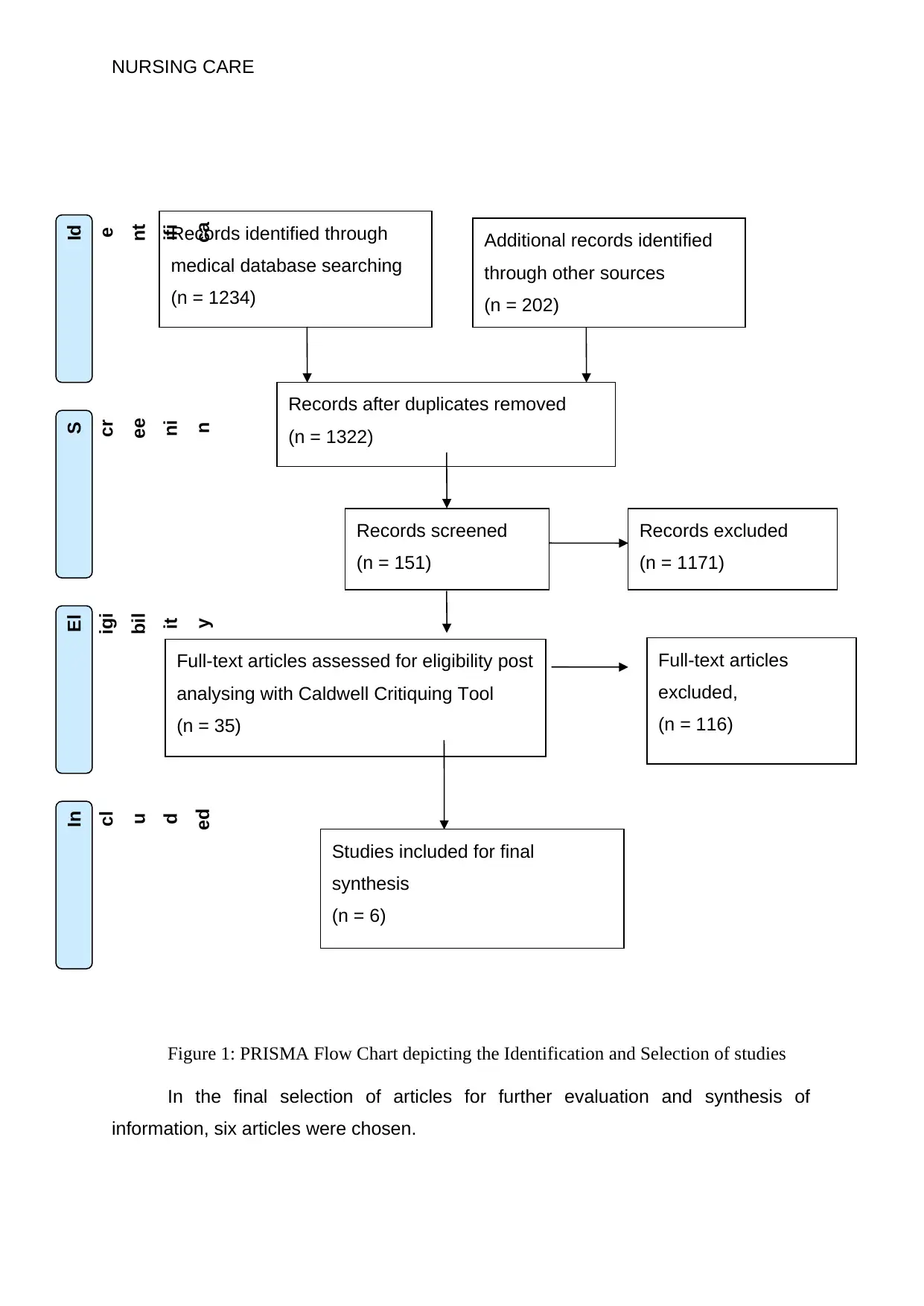
NURSING CARE
Figure 1: PRISMA Flow Chart depicting the Identification and Selection of studies
In the final selection of articles for further evaluation and synthesis of
information, six articles were chosen.
Records identified through
medical database searching
(n = 1234)
S
cr
ee
ni
n
g
In
cl
u
d
ed
El
igi
bil
it
y
Id
e
nt
ifi
ca
ti
Additional records identified
through other sources
(n = 202)
Records after duplicates removed
(n = 1322)
Records screened
(n = 151)
Records excluded
(n = 1171)
Full-text articles assessed for eligibility post
analysing with Caldwell Critiquing Tool
(n = 35)
Full-text articles
excluded,
(n = 116)
Studies included for final
synthesis
(n = 6)
Figure 1: PRISMA Flow Chart depicting the Identification and Selection of studies
In the final selection of articles for further evaluation and synthesis of
information, six articles were chosen.
Records identified through
medical database searching
(n = 1234)
S
cr
ee
ni
n
g
In
cl
u
d
ed
El
igi
bil
it
y
Id
e
nt
ifi
ca
ti
Additional records identified
through other sources
(n = 202)
Records after duplicates removed
(n = 1322)
Records screened
(n = 151)
Records excluded
(n = 1171)
Full-text articles assessed for eligibility post
analysing with Caldwell Critiquing Tool
(n = 35)
Full-text articles
excluded,
(n = 116)
Studies included for final
synthesis
(n = 6)
Paraphrase This Document
Need a fresh take? Get an instant paraphrase of this document with our AI Paraphraser

NURSING CARE
Summary of the Selected Articles
The first selected article is on a study conducted by Aalaa et al. (2012), which
aims to determine the role of nurses in diabetic foot care and prevention. The
researchers have conducted a review of the literature to achieve the objectives of the
study. The key highlights from the research findings include the role of nurses in
educating the patients, their role in rehabilitation and early screening of the patient’s
health condition to prevent further complications. The research findings are highly
compliant with the research objectives, increasing the overall validity of this study.
The next selected article is Barg et al. (2017), where the researchers have
employed qualitative study design to determine the perception of diabetic patients
with diabetic foot ulcer and who have undergone leg amputation due to it. The
researchers used an integrated analytic approach to evaluate the collected data from
the audio-recorded interviews to determine the research findings. The researchers
conclude that the care for such specified patients is highly complex, and the nurses
and other clinicians have a critical role to play in preventing recurrence and
associated mortality. The study design is comprehensive and adequate to achieve
the aims of the research study. However, the small sample size of the study can lead
to low generalizability of the research findings (McNeish and Stapleton 2016).
The third selected article is based on a study conducted by Delea et al.
(2015), to explore the patient’s attitude and their experience towards diabetic foot
disease and amputation. The researchers conducted one-to-one semi-structured
interviews with the sample selected with the help of the purposive sampling method.
The research findings conclude that rehabilitation is a significant concern for the
specified patient group. However, the small sample size, which includes only ten
male patients, lowers the generalisability of the research findings significantly and
raises the question of sampling bias (Etikan, Musa, S.A. and Alkassim).
The fourth article selected for further synthesis of information was from
Negara et al. (2019), with the primary objective of finding a relationship between the
quality of life and discharge planning by the clinicians and the nurses for the diabetic
patients who are suffering from diabetic foot ulcer and have undergone leg
amputation. The researchers interviewed 28 respondents. The research findings
conclude that a strong relationship exists between the discharge planning for
diabetic patients and their quality of life post-operation. The study design follows a
Summary of the Selected Articles
The first selected article is on a study conducted by Aalaa et al. (2012), which
aims to determine the role of nurses in diabetic foot care and prevention. The
researchers have conducted a review of the literature to achieve the objectives of the
study. The key highlights from the research findings include the role of nurses in
educating the patients, their role in rehabilitation and early screening of the patient’s
health condition to prevent further complications. The research findings are highly
compliant with the research objectives, increasing the overall validity of this study.
The next selected article is Barg et al. (2017), where the researchers have
employed qualitative study design to determine the perception of diabetic patients
with diabetic foot ulcer and who have undergone leg amputation due to it. The
researchers used an integrated analytic approach to evaluate the collected data from
the audio-recorded interviews to determine the research findings. The researchers
conclude that the care for such specified patients is highly complex, and the nurses
and other clinicians have a critical role to play in preventing recurrence and
associated mortality. The study design is comprehensive and adequate to achieve
the aims of the research study. However, the small sample size of the study can lead
to low generalizability of the research findings (McNeish and Stapleton 2016).
The third selected article is based on a study conducted by Delea et al.
(2015), to explore the patient’s attitude and their experience towards diabetic foot
disease and amputation. The researchers conducted one-to-one semi-structured
interviews with the sample selected with the help of the purposive sampling method.
The research findings conclude that rehabilitation is a significant concern for the
specified patient group. However, the small sample size, which includes only ten
male patients, lowers the generalisability of the research findings significantly and
raises the question of sampling bias (Etikan, Musa, S.A. and Alkassim).
The fourth article selected for further synthesis of information was from
Negara et al. (2019), with the primary objective of finding a relationship between the
quality of life and discharge planning by the clinicians and the nurses for the diabetic
patients who are suffering from diabetic foot ulcer and have undergone leg
amputation. The researchers interviewed 28 respondents. The research findings
conclude that a strong relationship exists between the discharge planning for
diabetic patients and their quality of life post-operation. The study design follows a
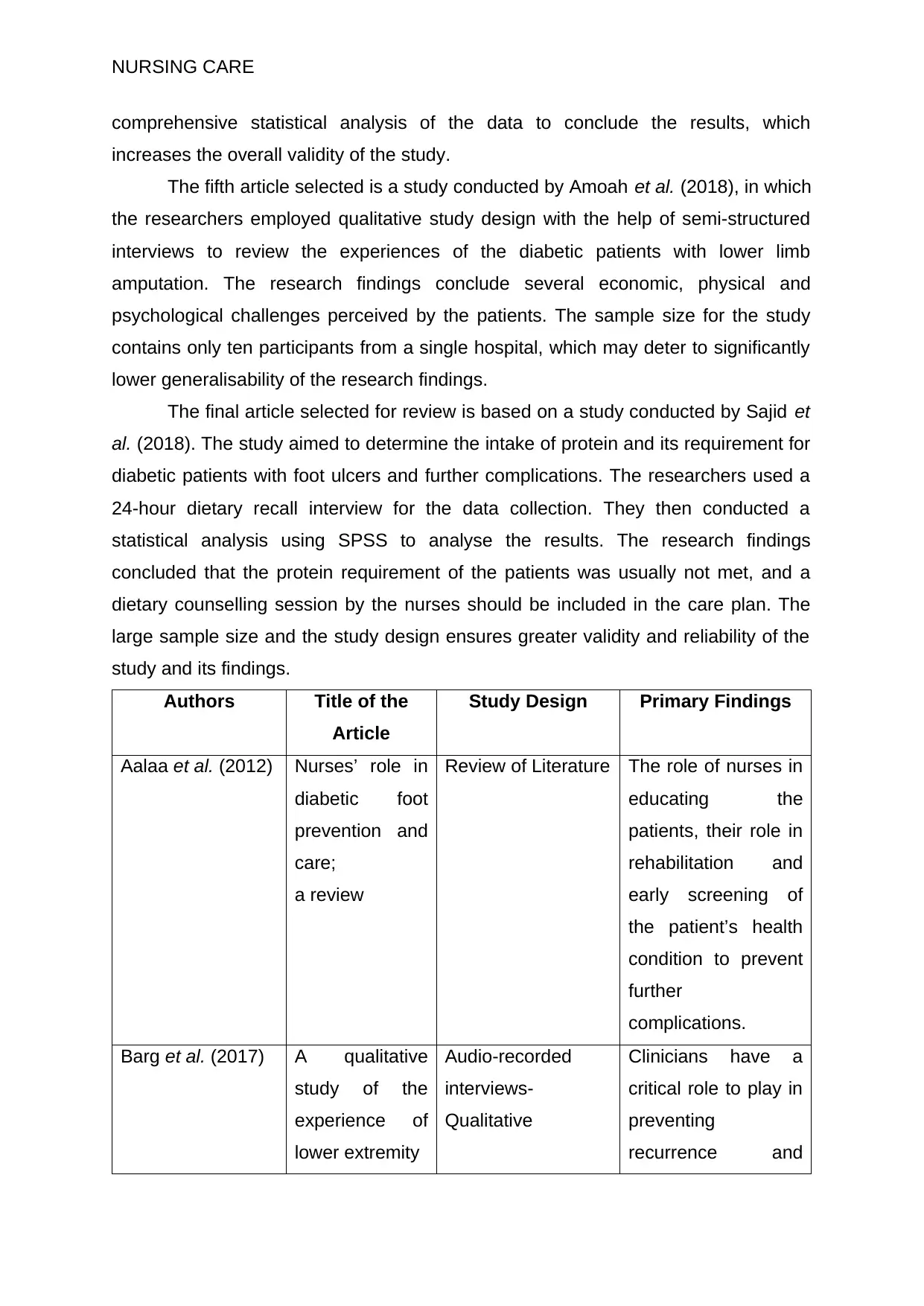
NURSING CARE
comprehensive statistical analysis of the data to conclude the results, which
increases the overall validity of the study.
The fifth article selected is a study conducted by Amoah et al. (2018), in which
the researchers employed qualitative study design with the help of semi-structured
interviews to review the experiences of the diabetic patients with lower limb
amputation. The research findings conclude several economic, physical and
psychological challenges perceived by the patients. The sample size for the study
contains only ten participants from a single hospital, which may deter to significantly
lower generalisability of the research findings.
The final article selected for review is based on a study conducted by Sajid et
al. (2018). The study aimed to determine the intake of protein and its requirement for
diabetic patients with foot ulcers and further complications. The researchers used a
24-hour dietary recall interview for the data collection. They then conducted a
statistical analysis using SPSS to analyse the results. The research findings
concluded that the protein requirement of the patients was usually not met, and a
dietary counselling session by the nurses should be included in the care plan. The
large sample size and the study design ensures greater validity and reliability of the
study and its findings.
Authors Title of the
Article
Study Design Primary Findings
Aalaa et al. (2012) Nurses’ role in
diabetic foot
prevention and
care;
a review
Review of Literature The role of nurses in
educating the
patients, their role in
rehabilitation and
early screening of
the patient’s health
condition to prevent
further
complications.
Barg et al. (2017) A qualitative
study of the
experience of
lower extremity
Audio-recorded
interviews-
Qualitative
Clinicians have a
critical role to play in
preventing
recurrence and
comprehensive statistical analysis of the data to conclude the results, which
increases the overall validity of the study.
The fifth article selected is a study conducted by Amoah et al. (2018), in which
the researchers employed qualitative study design with the help of semi-structured
interviews to review the experiences of the diabetic patients with lower limb
amputation. The research findings conclude several economic, physical and
psychological challenges perceived by the patients. The sample size for the study
contains only ten participants from a single hospital, which may deter to significantly
lower generalisability of the research findings.
The final article selected for review is based on a study conducted by Sajid et
al. (2018). The study aimed to determine the intake of protein and its requirement for
diabetic patients with foot ulcers and further complications. The researchers used a
24-hour dietary recall interview for the data collection. They then conducted a
statistical analysis using SPSS to analyse the results. The research findings
concluded that the protein requirement of the patients was usually not met, and a
dietary counselling session by the nurses should be included in the care plan. The
large sample size and the study design ensures greater validity and reliability of the
study and its findings.
Authors Title of the
Article
Study Design Primary Findings
Aalaa et al. (2012) Nurses’ role in
diabetic foot
prevention and
care;
a review
Review of Literature The role of nurses in
educating the
patients, their role in
rehabilitation and
early screening of
the patient’s health
condition to prevent
further
complications.
Barg et al. (2017) A qualitative
study of the
experience of
lower extremity
Audio-recorded
interviews-
Qualitative
Clinicians have a
critical role to play in
preventing
recurrence and
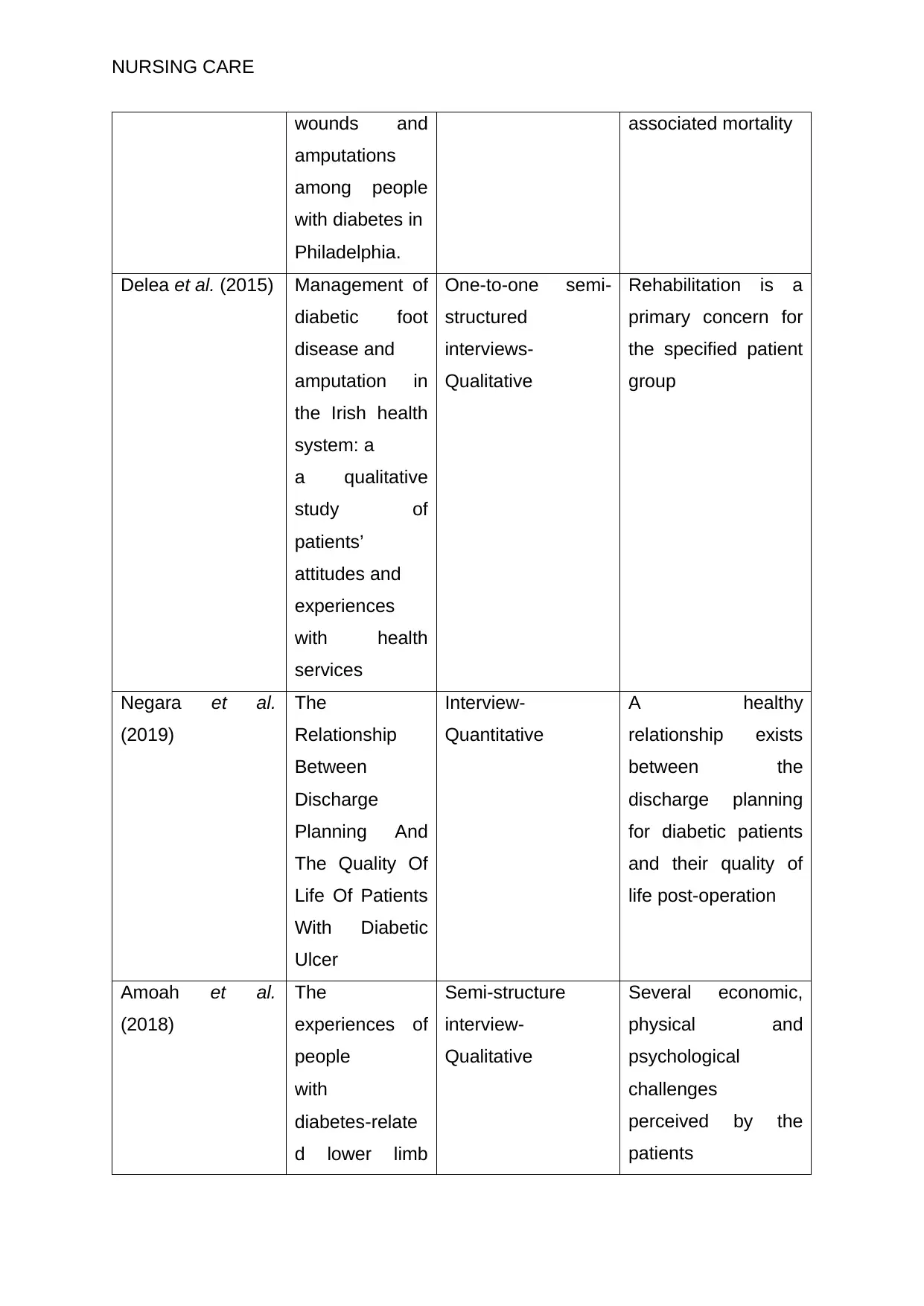
NURSING CARE
wounds and
amputations
among people
with diabetes in
Philadelphia.
associated mortality
Delea et al. (2015) Management of
diabetic foot
disease and
amputation in
the Irish health
system: a
a qualitative
study of
patients’
attitudes and
experiences
with health
services
One-to-one semi-
structured
interviews-
Qualitative
Rehabilitation is a
primary concern for
the specified patient
group
Negara et al.
(2019)
The
Relationship
Between
Discharge
Planning And
The Quality Of
Life Of Patients
With Diabetic
Ulcer
Interview-
Quantitative
A healthy
relationship exists
between the
discharge planning
for diabetic patients
and their quality of
life post-operation
Amoah et al.
(2018)
The
experiences of
people
with
diabetes-relate
d lower limb
Semi-structure
interview-
Qualitative
Several economic,
physical and
psychological
challenges
perceived by the
patients
wounds and
amputations
among people
with diabetes in
Philadelphia.
associated mortality
Delea et al. (2015) Management of
diabetic foot
disease and
amputation in
the Irish health
system: a
a qualitative
study of
patients’
attitudes and
experiences
with health
services
One-to-one semi-
structured
interviews-
Qualitative
Rehabilitation is a
primary concern for
the specified patient
group
Negara et al.
(2019)
The
Relationship
Between
Discharge
Planning And
The Quality Of
Life Of Patients
With Diabetic
Ulcer
Interview-
Quantitative
A healthy
relationship exists
between the
discharge planning
for diabetic patients
and their quality of
life post-operation
Amoah et al.
(2018)
The
experiences of
people
with
diabetes-relate
d lower limb
Semi-structure
interview-
Qualitative
Several economic,
physical and
psychological
challenges
perceived by the
patients
Secure Best Marks with AI Grader
Need help grading? Try our AI Grader for instant feedback on your assignments.
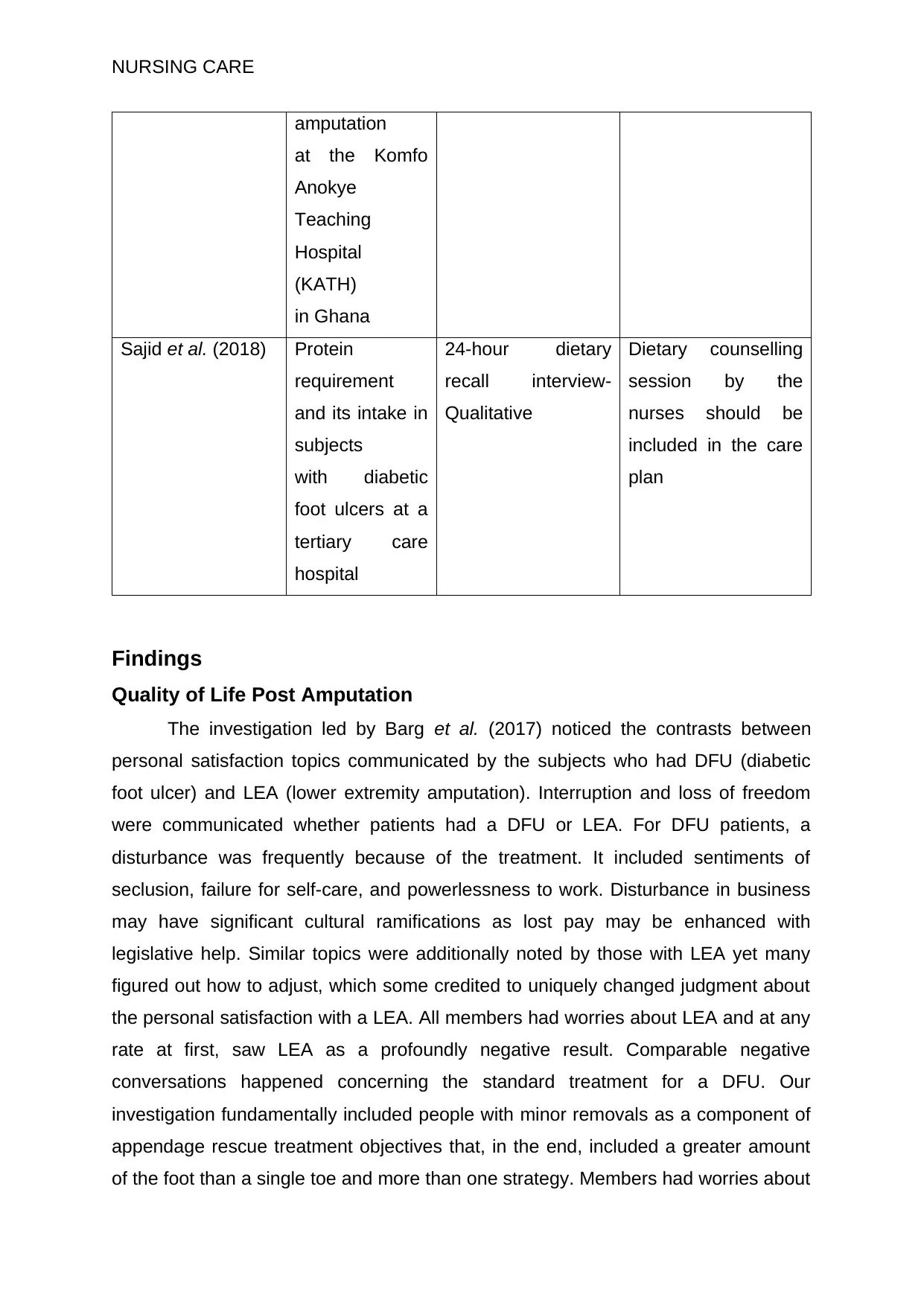
NURSING CARE
amputation
at the Komfo
Anokye
Teaching
Hospital
(KATH)
in Ghana
Sajid et al. (2018) Protein
requirement
and its intake in
subjects
with diabetic
foot ulcers at a
tertiary care
hospital
24-hour dietary
recall interview-
Qualitative
Dietary counselling
session by the
nurses should be
included in the care
plan
Findings
Quality of Life Post Amputation
The investigation led by Barg et al. (2017) noticed the contrasts between
personal satisfaction topics communicated by the subjects who had DFU (diabetic
foot ulcer) and LEA (lower extremity amputation). Interruption and loss of freedom
were communicated whether patients had a DFU or LEA. For DFU patients, a
disturbance was frequently because of the treatment. It included sentiments of
seclusion, failure for self-care, and powerlessness to work. Disturbance in business
may have significant cultural ramifications as lost pay may be enhanced with
legislative help. Similar topics were additionally noted by those with LEA yet many
figured out how to adjust, which some credited to uniquely changed judgment about
the personal satisfaction with a LEA. All members had worries about LEA and at any
rate at first, saw LEA as a profoundly negative result. Comparable negative
conversations happened concerning the standard treatment for a DFU. Our
investigation fundamentally included people with minor removals as a component of
appendage rescue treatment objectives that, in the end, included a greater amount
of the foot than a single toe and more than one strategy. Members had worries about
amputation
at the Komfo
Anokye
Teaching
Hospital
(KATH)
in Ghana
Sajid et al. (2018) Protein
requirement
and its intake in
subjects
with diabetic
foot ulcers at a
tertiary care
hospital
24-hour dietary
recall interview-
Qualitative
Dietary counselling
session by the
nurses should be
included in the care
plan
Findings
Quality of Life Post Amputation
The investigation led by Barg et al. (2017) noticed the contrasts between
personal satisfaction topics communicated by the subjects who had DFU (diabetic
foot ulcer) and LEA (lower extremity amputation). Interruption and loss of freedom
were communicated whether patients had a DFU or LEA. For DFU patients, a
disturbance was frequently because of the treatment. It included sentiments of
seclusion, failure for self-care, and powerlessness to work. Disturbance in business
may have significant cultural ramifications as lost pay may be enhanced with
legislative help. Similar topics were additionally noted by those with LEA yet many
figured out how to adjust, which some credited to uniquely changed judgment about
the personal satisfaction with a LEA. All members had worries about LEA and at any
rate at first, saw LEA as a profoundly negative result. Comparable negative
conversations happened concerning the standard treatment for a DFU. Our
investigation fundamentally included people with minor removals as a component of
appendage rescue treatment objectives that, in the end, included a greater amount
of the foot than a single toe and more than one strategy. Members had worries about
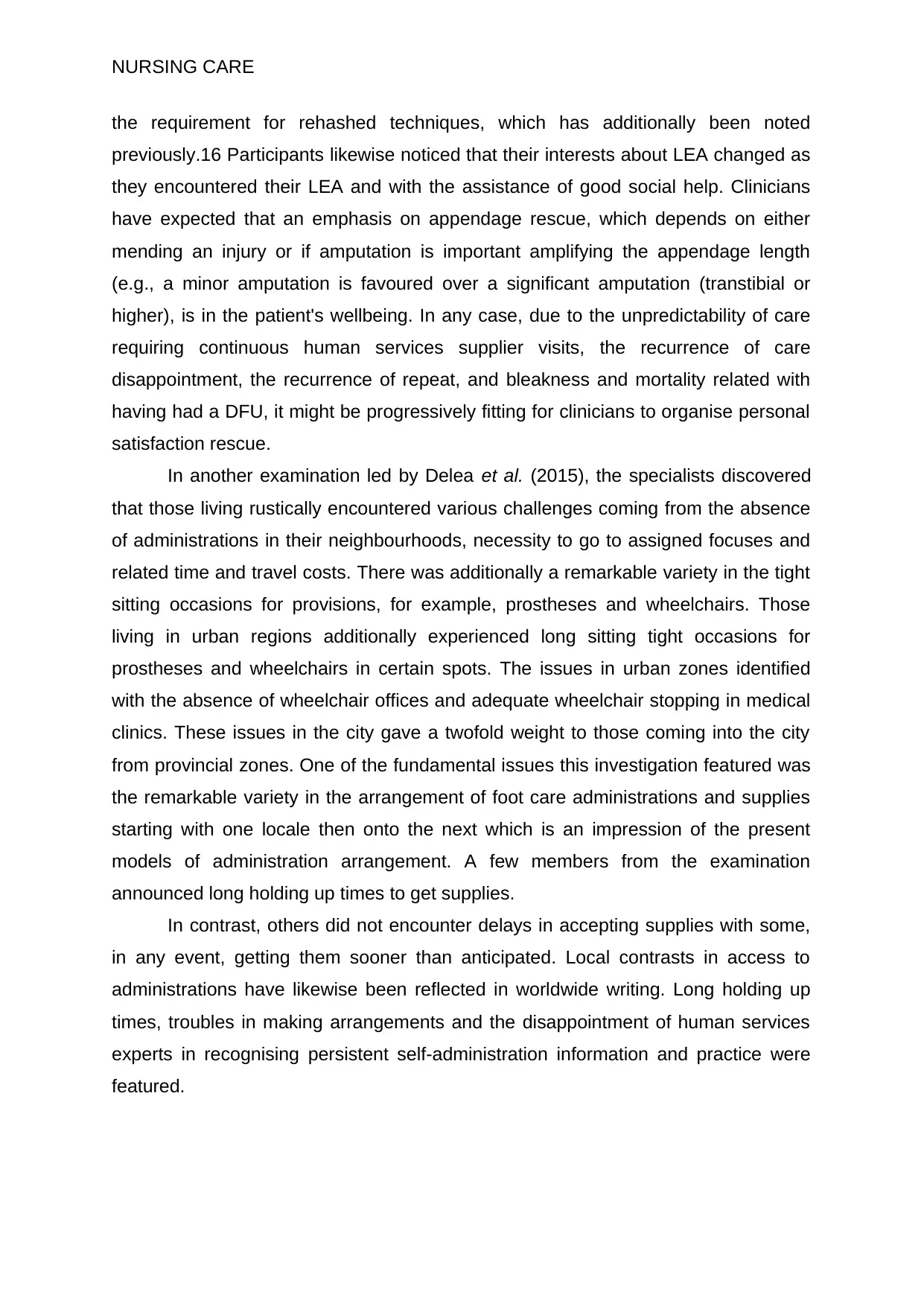
NURSING CARE
the requirement for rehashed techniques, which has additionally been noted
previously.16 Participants likewise noticed that their interests about LEA changed as
they encountered their LEA and with the assistance of good social help. Clinicians
have expected that an emphasis on appendage rescue, which depends on either
mending an injury or if amputation is important amplifying the appendage length
(e.g., a minor amputation is favoured over a significant amputation (transtibial or
higher), is in the patient's wellbeing. In any case, due to the unpredictability of care
requiring continuous human services supplier visits, the recurrence of care
disappointment, the recurrence of repeat, and bleakness and mortality related with
having had a DFU, it might be progressively fitting for clinicians to organise personal
satisfaction rescue.
In another examination led by Delea et al. (2015), the specialists discovered
that those living rustically encountered various challenges coming from the absence
of administrations in their neighbourhoods, necessity to go to assigned focuses and
related time and travel costs. There was additionally a remarkable variety in the tight
sitting occasions for provisions, for example, prostheses and wheelchairs. Those
living in urban regions additionally experienced long sitting tight occasions for
prostheses and wheelchairs in certain spots. The issues in urban zones identified
with the absence of wheelchair offices and adequate wheelchair stopping in medical
clinics. These issues in the city gave a twofold weight to those coming into the city
from provincial zones. One of the fundamental issues this investigation featured was
the remarkable variety in the arrangement of foot care administrations and supplies
starting with one locale then onto the next which is an impression of the present
models of administration arrangement. A few members from the examination
announced long holding up times to get supplies.
In contrast, others did not encounter delays in accepting supplies with some,
in any event, getting them sooner than anticipated. Local contrasts in access to
administrations have likewise been reflected in worldwide writing. Long holding up
times, troubles in making arrangements and the disappointment of human services
experts in recognising persistent self-administration information and practice were
featured.
the requirement for rehashed techniques, which has additionally been noted
previously.16 Participants likewise noticed that their interests about LEA changed as
they encountered their LEA and with the assistance of good social help. Clinicians
have expected that an emphasis on appendage rescue, which depends on either
mending an injury or if amputation is important amplifying the appendage length
(e.g., a minor amputation is favoured over a significant amputation (transtibial or
higher), is in the patient's wellbeing. In any case, due to the unpredictability of care
requiring continuous human services supplier visits, the recurrence of care
disappointment, the recurrence of repeat, and bleakness and mortality related with
having had a DFU, it might be progressively fitting for clinicians to organise personal
satisfaction rescue.
In another examination led by Delea et al. (2015), the specialists discovered
that those living rustically encountered various challenges coming from the absence
of administrations in their neighbourhoods, necessity to go to assigned focuses and
related time and travel costs. There was additionally a remarkable variety in the tight
sitting occasions for provisions, for example, prostheses and wheelchairs. Those
living in urban regions additionally experienced long sitting tight occasions for
prostheses and wheelchairs in certain spots. The issues in urban zones identified
with the absence of wheelchair offices and adequate wheelchair stopping in medical
clinics. These issues in the city gave a twofold weight to those coming into the city
from provincial zones. One of the fundamental issues this investigation featured was
the remarkable variety in the arrangement of foot care administrations and supplies
starting with one locale then onto the next which is an impression of the present
models of administration arrangement. A few members from the examination
announced long holding up times to get supplies.
In contrast, others did not encounter delays in accepting supplies with some,
in any event, getting them sooner than anticipated. Local contrasts in access to
administrations have likewise been reflected in worldwide writing. Long holding up
times, troubles in making arrangements and the disappointment of human services
experts in recognising persistent self-administration information and practice were
featured.
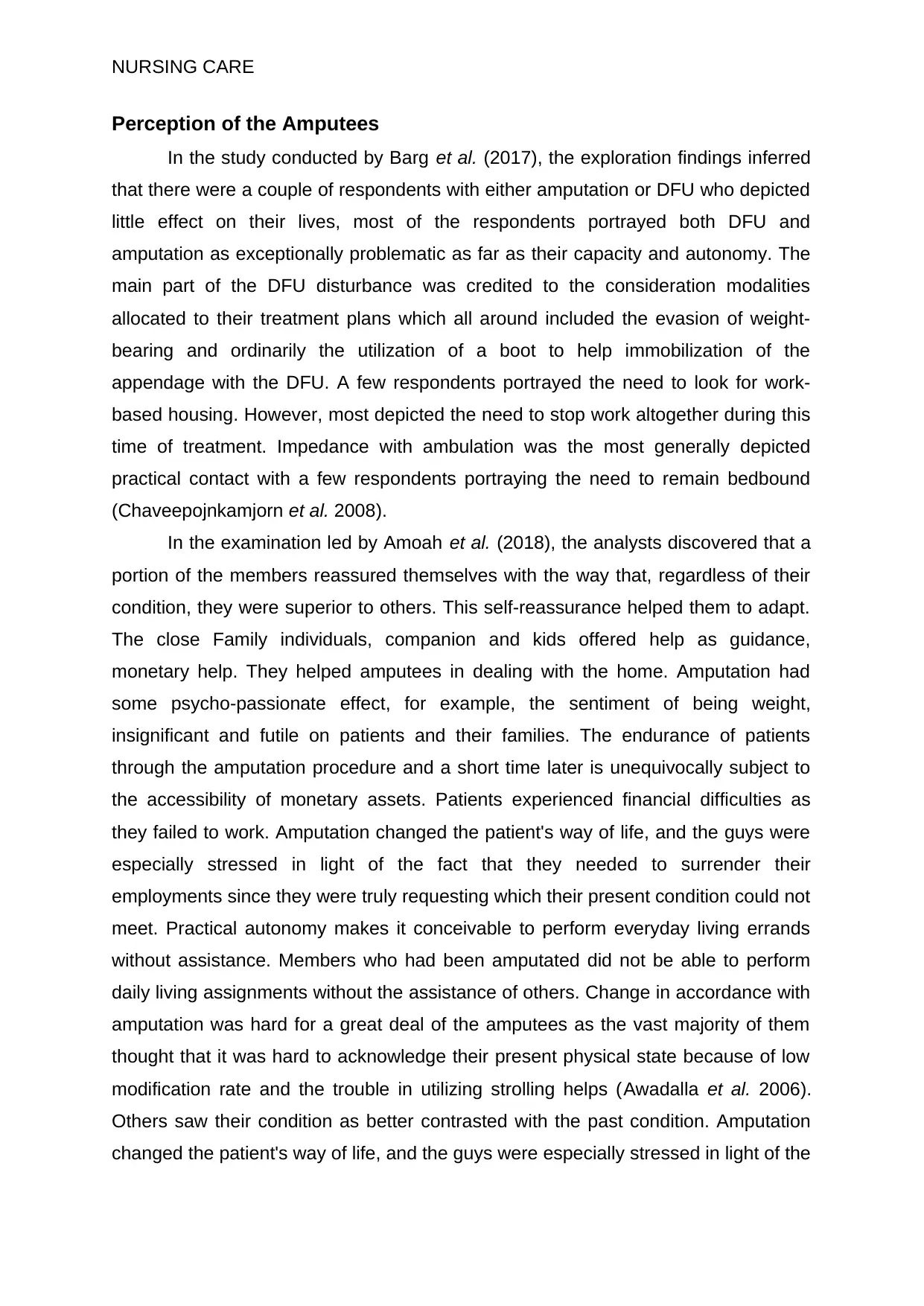
NURSING CARE
Perception of the Amputees
In the study conducted by Barg et al. (2017), the exploration findings inferred
that there were a couple of respondents with either amputation or DFU who depicted
little effect on their lives, most of the respondents portrayed both DFU and
amputation as exceptionally problematic as far as their capacity and autonomy. The
main part of the DFU disturbance was credited to the consideration modalities
allocated to their treatment plans which all around included the evasion of weight-
bearing and ordinarily the utilization of a boot to help immobilization of the
appendage with the DFU. A few respondents portrayed the need to look for work-
based housing. However, most depicted the need to stop work altogether during this
time of treatment. Impedance with ambulation was the most generally depicted
practical contact with a few respondents portraying the need to remain bedbound
(Chaveepojnkamjorn et al. 2008).
In the examination led by Amoah et al. (2018), the analysts discovered that a
portion of the members reassured themselves with the way that, regardless of their
condition, they were superior to others. This self-reassurance helped them to adapt.
The close Family individuals, companion and kids offered help as guidance,
monetary help. They helped amputees in dealing with the home. Amputation had
some psycho-passionate effect, for example, the sentiment of being weight,
insignificant and futile on patients and their families. The endurance of patients
through the amputation procedure and a short time later is unequivocally subject to
the accessibility of monetary assets. Patients experienced financial difficulties as
they failed to work. Amputation changed the patient's way of life, and the guys were
especially stressed in light of the fact that they needed to surrender their
employments since they were truly requesting which their present condition could not
meet. Practical autonomy makes it conceivable to perform everyday living errands
without assistance. Members who had been amputated did not be able to perform
daily living assignments without the assistance of others. Change in accordance with
amputation was hard for a great deal of the amputees as the vast majority of them
thought that it was hard to acknowledge their present physical state because of low
modification rate and the trouble in utilizing strolling helps (Awadalla et al. 2006).
Others saw their condition as better contrasted with the past condition. Amputation
changed the patient's way of life, and the guys were especially stressed in light of the
Perception of the Amputees
In the study conducted by Barg et al. (2017), the exploration findings inferred
that there were a couple of respondents with either amputation or DFU who depicted
little effect on their lives, most of the respondents portrayed both DFU and
amputation as exceptionally problematic as far as their capacity and autonomy. The
main part of the DFU disturbance was credited to the consideration modalities
allocated to their treatment plans which all around included the evasion of weight-
bearing and ordinarily the utilization of a boot to help immobilization of the
appendage with the DFU. A few respondents portrayed the need to look for work-
based housing. However, most depicted the need to stop work altogether during this
time of treatment. Impedance with ambulation was the most generally depicted
practical contact with a few respondents portraying the need to remain bedbound
(Chaveepojnkamjorn et al. 2008).
In the examination led by Amoah et al. (2018), the analysts discovered that a
portion of the members reassured themselves with the way that, regardless of their
condition, they were superior to others. This self-reassurance helped them to adapt.
The close Family individuals, companion and kids offered help as guidance,
monetary help. They helped amputees in dealing with the home. Amputation had
some psycho-passionate effect, for example, the sentiment of being weight,
insignificant and futile on patients and their families. The endurance of patients
through the amputation procedure and a short time later is unequivocally subject to
the accessibility of monetary assets. Patients experienced financial difficulties as
they failed to work. Amputation changed the patient's way of life, and the guys were
especially stressed in light of the fact that they needed to surrender their
employments since they were truly requesting which their present condition could not
meet. Practical autonomy makes it conceivable to perform everyday living errands
without assistance. Members who had been amputated did not be able to perform
daily living assignments without the assistance of others. Change in accordance with
amputation was hard for a great deal of the amputees as the vast majority of them
thought that it was hard to acknowledge their present physical state because of low
modification rate and the trouble in utilizing strolling helps (Awadalla et al. 2006).
Others saw their condition as better contrasted with the past condition. Amputation
changed the patient's way of life, and the guys were especially stressed in light of the
Paraphrase This Document
Need a fresh take? Get an instant paraphrase of this document with our AI Paraphraser
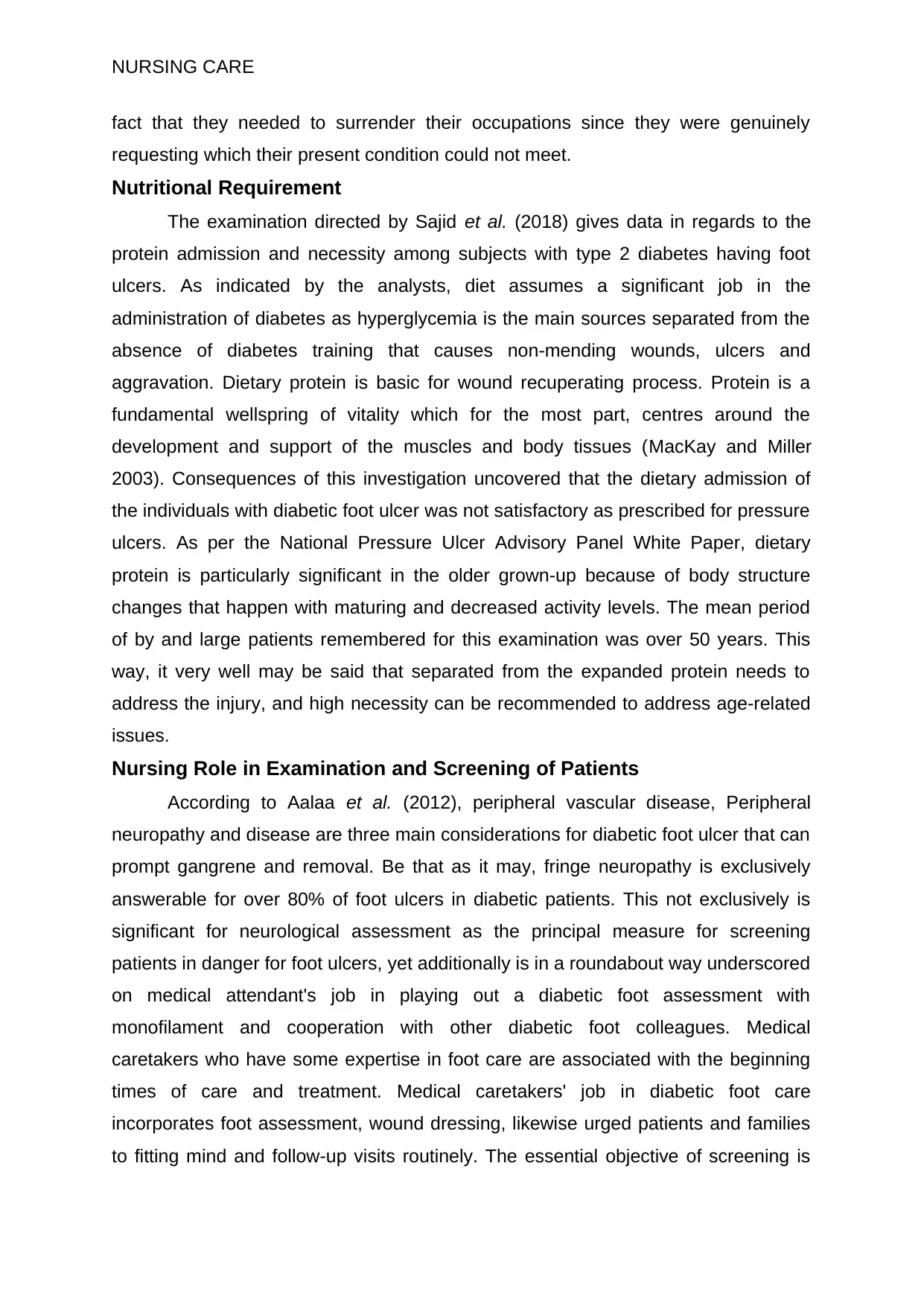
NURSING CARE
fact that they needed to surrender their occupations since they were genuinely
requesting which their present condition could not meet.
Nutritional Requirement
The examination directed by Sajid et al. (2018) gives data in regards to the
protein admission and necessity among subjects with type 2 diabetes having foot
ulcers. As indicated by the analysts, diet assumes a significant job in the
administration of diabetes as hyperglycemia is the main sources separated from the
absence of diabetes training that causes non-mending wounds, ulcers and
aggravation. Dietary protein is basic for wound recuperating process. Protein is a
fundamental wellspring of vitality which for the most part, centres around the
development and support of the muscles and body tissues (MacKay and Miller
2003). Consequences of this investigation uncovered that the dietary admission of
the individuals with diabetic foot ulcer was not satisfactory as prescribed for pressure
ulcers. As per the National Pressure Ulcer Advisory Panel White Paper, dietary
protein is particularly significant in the older grown-up because of body structure
changes that happen with maturing and decreased activity levels. The mean period
of by and large patients remembered for this examination was over 50 years. This
way, it very well may be said that separated from the expanded protein needs to
address the injury, and high necessity can be recommended to address age-related
issues.
Nursing Role in Examination and Screening of Patients
According to Aalaa et al. (2012), peripheral vascular disease, Peripheral
neuropathy and disease are three main considerations for diabetic foot ulcer that can
prompt gangrene and removal. Be that as it may, fringe neuropathy is exclusively
answerable for over 80% of foot ulcers in diabetic patients. This not exclusively is
significant for neurological assessment as the principal measure for screening
patients in danger for foot ulcers, yet additionally is in a roundabout way underscored
on medical attendant's job in playing out a diabetic foot assessment with
monofilament and cooperation with other diabetic foot colleagues. Medical
caretakers who have some expertise in foot care are associated with the beginning
times of care and treatment. Medical caretakers' job in diabetic foot care
incorporates foot assessment, wound dressing, likewise urged patients and families
to fitting mind and follow-up visits routinely. The essential objective of screening is
fact that they needed to surrender their occupations since they were genuinely
requesting which their present condition could not meet.
Nutritional Requirement
The examination directed by Sajid et al. (2018) gives data in regards to the
protein admission and necessity among subjects with type 2 diabetes having foot
ulcers. As indicated by the analysts, diet assumes a significant job in the
administration of diabetes as hyperglycemia is the main sources separated from the
absence of diabetes training that causes non-mending wounds, ulcers and
aggravation. Dietary protein is basic for wound recuperating process. Protein is a
fundamental wellspring of vitality which for the most part, centres around the
development and support of the muscles and body tissues (MacKay and Miller
2003). Consequences of this investigation uncovered that the dietary admission of
the individuals with diabetic foot ulcer was not satisfactory as prescribed for pressure
ulcers. As per the National Pressure Ulcer Advisory Panel White Paper, dietary
protein is particularly significant in the older grown-up because of body structure
changes that happen with maturing and decreased activity levels. The mean period
of by and large patients remembered for this examination was over 50 years. This
way, it very well may be said that separated from the expanded protein needs to
address the injury, and high necessity can be recommended to address age-related
issues.
Nursing Role in Examination and Screening of Patients
According to Aalaa et al. (2012), peripheral vascular disease, Peripheral
neuropathy and disease are three main considerations for diabetic foot ulcer that can
prompt gangrene and removal. Be that as it may, fringe neuropathy is exclusively
answerable for over 80% of foot ulcers in diabetic patients. This not exclusively is
significant for neurological assessment as the principal measure for screening
patients in danger for foot ulcers, yet additionally is in a roundabout way underscored
on medical attendant's job in playing out a diabetic foot assessment with
monofilament and cooperation with other diabetic foot colleagues. Medical
caretakers who have some expertise in foot care are associated with the beginning
times of care and treatment. Medical caretakers' job in diabetic foot care
incorporates foot assessment, wound dressing, likewise urged patients and families
to fitting mind and follow-up visits routinely. The essential objective of screening is
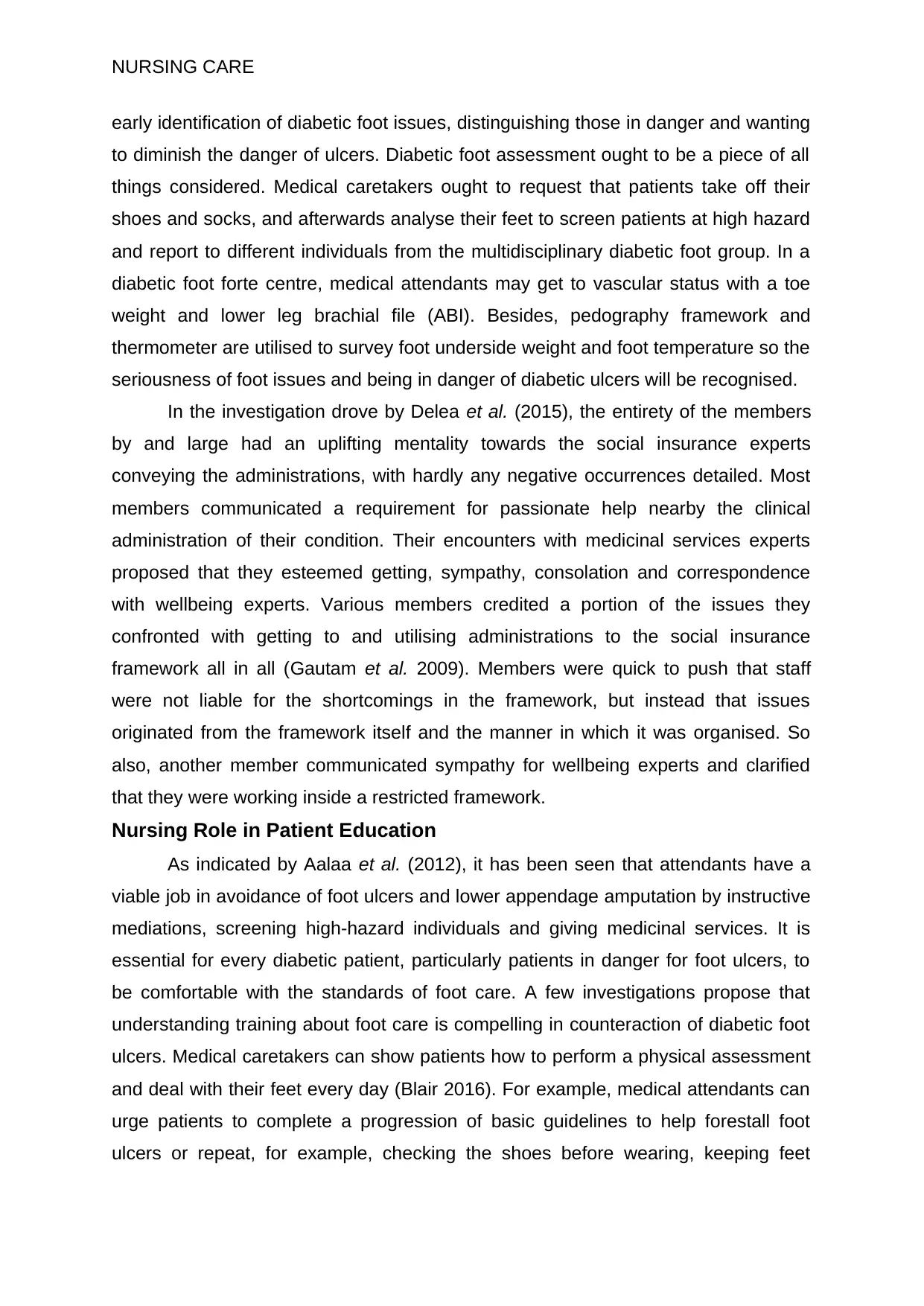
NURSING CARE
early identification of diabetic foot issues, distinguishing those in danger and wanting
to diminish the danger of ulcers. Diabetic foot assessment ought to be a piece of all
things considered. Medical caretakers ought to request that patients take off their
shoes and socks, and afterwards analyse their feet to screen patients at high hazard
and report to different individuals from the multidisciplinary diabetic foot group. In a
diabetic foot forte centre, medical attendants may get to vascular status with a toe
weight and lower leg brachial file (ABI). Besides, pedography framework and
thermometer are utilised to survey foot underside weight and foot temperature so the
seriousness of foot issues and being in danger of diabetic ulcers will be recognised.
In the investigation drove by Delea et al. (2015), the entirety of the members
by and large had an uplifting mentality towards the social insurance experts
conveying the administrations, with hardly any negative occurrences detailed. Most
members communicated a requirement for passionate help nearby the clinical
administration of their condition. Their encounters with medicinal services experts
proposed that they esteemed getting, sympathy, consolation and correspondence
with wellbeing experts. Various members credited a portion of the issues they
confronted with getting to and utilising administrations to the social insurance
framework all in all (Gautam et al. 2009). Members were quick to push that staff
were not liable for the shortcomings in the framework, but instead that issues
originated from the framework itself and the manner in which it was organised. So
also, another member communicated sympathy for wellbeing experts and clarified
that they were working inside a restricted framework.
Nursing Role in Patient Education
As indicated by Aalaa et al. (2012), it has been seen that attendants have a
viable job in avoidance of foot ulcers and lower appendage amputation by instructive
mediations, screening high-hazard individuals and giving medicinal services. It is
essential for every diabetic patient, particularly patients in danger for foot ulcers, to
be comfortable with the standards of foot care. A few investigations propose that
understanding training about foot care is compelling in counteraction of diabetic foot
ulcers. Medical caretakers can show patients how to perform a physical assessment
and deal with their feet every day (Blair 2016). For example, medical attendants can
urge patients to complete a progression of basic guidelines to help forestall foot
ulcers or repeat, for example, checking the shoes before wearing, keeping feet
early identification of diabetic foot issues, distinguishing those in danger and wanting
to diminish the danger of ulcers. Diabetic foot assessment ought to be a piece of all
things considered. Medical caretakers ought to request that patients take off their
shoes and socks, and afterwards analyse their feet to screen patients at high hazard
and report to different individuals from the multidisciplinary diabetic foot group. In a
diabetic foot forte centre, medical attendants may get to vascular status with a toe
weight and lower leg brachial file (ABI). Besides, pedography framework and
thermometer are utilised to survey foot underside weight and foot temperature so the
seriousness of foot issues and being in danger of diabetic ulcers will be recognised.
In the investigation drove by Delea et al. (2015), the entirety of the members
by and large had an uplifting mentality towards the social insurance experts
conveying the administrations, with hardly any negative occurrences detailed. Most
members communicated a requirement for passionate help nearby the clinical
administration of their condition. Their encounters with medicinal services experts
proposed that they esteemed getting, sympathy, consolation and correspondence
with wellbeing experts. Various members credited a portion of the issues they
confronted with getting to and utilising administrations to the social insurance
framework all in all (Gautam et al. 2009). Members were quick to push that staff
were not liable for the shortcomings in the framework, but instead that issues
originated from the framework itself and the manner in which it was organised. So
also, another member communicated sympathy for wellbeing experts and clarified
that they were working inside a restricted framework.
Nursing Role in Patient Education
As indicated by Aalaa et al. (2012), it has been seen that attendants have a
viable job in avoidance of foot ulcers and lower appendage amputation by instructive
mediations, screening high-hazard individuals and giving medicinal services. It is
essential for every diabetic patient, particularly patients in danger for foot ulcers, to
be comfortable with the standards of foot care. A few investigations propose that
understanding training about foot care is compelling in counteraction of diabetic foot
ulcers. Medical caretakers can show patients how to perform a physical assessment
and deal with their feet every day (Blair 2016). For example, medical attendants can
urge patients to complete a progression of basic guidelines to help forestall foot
ulcers or repeat, for example, checking the shoes before wearing, keeping feet

NURSING CARE
spotless and proceeding with the care of the skin and nails (Pandarakutty and Raj
2017). Preparing about picking the correct shoes is fundamental too. Diabetic foot
care instruction programs have been proposed thinking about the result of
proceeding with instructive projects.
Nonetheless, the attendant teachers can assess persistent prerequisites and
plan a specific instructive program for every one of the patients and their families.
Attendants can encourage active cooperation of patients and relatives in care, and
they can likewise show patients the significance of regular visits to the centre, blood
tests at determining interims and the essential guideline of diabetes care and
anticipation of its inconvenience (Powell, Engberg and Siminerio 2018). Besides,
since hyperglycemia is a modifiable hazard factor in diabetic neuropathy, fitting
glucose control is foremost to lessening neuropathy and improving patients'
satisfaction (Grisold, Callaghan and Feldman 2017). Subsequently, patients with
poor control of blood glucose ought to be given unique consideration for practicable
instructions. This underscores the significance of attendants' job to build up a far-
reaching instructive program. Other than learning the appropriate way of life, patients
ought to be prepared by the seriousness of diabetic foot issues. Thinking about the
above focuses, training of human services supplier is a pivotal issue. More often
than not, they come up short on the information on compelling medications.
Alongside persistent instruction, diabetic foot colleagues and attendants as a key
individual from them must be prepared. Its fundamental objective is to build staff
attention to the diabetic foot ulcer hazards and improve their abilities in assessment
and treatment of the diabetic foot (Dewanjee et al. 2018).
On the other hand, as indicated by the examination led by Delea et al. (2015),
participants' degree of training and data around their ailment changed broadly. Some
revealed an absence of information and comprehension about diabetes when
originally analysed. Nonetheless, numerous members clarified that, regardless of
accepting data about foot self-care and manners by which they could decrease the
evil impacts of diabetes, they decided not to adhere to specialists' guidelines thus
assumed liability for the exacerbating of their condition (Hadden et al. 2019). The
analysts proposed that members thought that it was hard to acknowledge their
finding and would in general dismissal precaution counsel. A few members clarified
that they were unconscious that they had foot sickness and now and again, diabetes
until unequivocal side effects of foot ulceration were clear. They likewise clarified that
spotless and proceeding with the care of the skin and nails (Pandarakutty and Raj
2017). Preparing about picking the correct shoes is fundamental too. Diabetic foot
care instruction programs have been proposed thinking about the result of
proceeding with instructive projects.
Nonetheless, the attendant teachers can assess persistent prerequisites and
plan a specific instructive program for every one of the patients and their families.
Attendants can encourage active cooperation of patients and relatives in care, and
they can likewise show patients the significance of regular visits to the centre, blood
tests at determining interims and the essential guideline of diabetes care and
anticipation of its inconvenience (Powell, Engberg and Siminerio 2018). Besides,
since hyperglycemia is a modifiable hazard factor in diabetic neuropathy, fitting
glucose control is foremost to lessening neuropathy and improving patients'
satisfaction (Grisold, Callaghan and Feldman 2017). Subsequently, patients with
poor control of blood glucose ought to be given unique consideration for practicable
instructions. This underscores the significance of attendants' job to build up a far-
reaching instructive program. Other than learning the appropriate way of life, patients
ought to be prepared by the seriousness of diabetic foot issues. Thinking about the
above focuses, training of human services supplier is a pivotal issue. More often
than not, they come up short on the information on compelling medications.
Alongside persistent instruction, diabetic foot colleagues and attendants as a key
individual from them must be prepared. Its fundamental objective is to build staff
attention to the diabetic foot ulcer hazards and improve their abilities in assessment
and treatment of the diabetic foot (Dewanjee et al. 2018).
On the other hand, as indicated by the examination led by Delea et al. (2015),
participants' degree of training and data around their ailment changed broadly. Some
revealed an absence of information and comprehension about diabetes when
originally analysed. Nonetheless, numerous members clarified that, regardless of
accepting data about foot self-care and manners by which they could decrease the
evil impacts of diabetes, they decided not to adhere to specialists' guidelines thus
assumed liability for the exacerbating of their condition (Hadden et al. 2019). The
analysts proposed that members thought that it was hard to acknowledge their
finding and would in general dismissal precaution counsel. A few members clarified
that they were unconscious that they had foot sickness and now and again, diabetes
until unequivocal side effects of foot ulceration were clear. They likewise clarified that
Secure Best Marks with AI Grader
Need help grading? Try our AI Grader for instant feedback on your assignments.
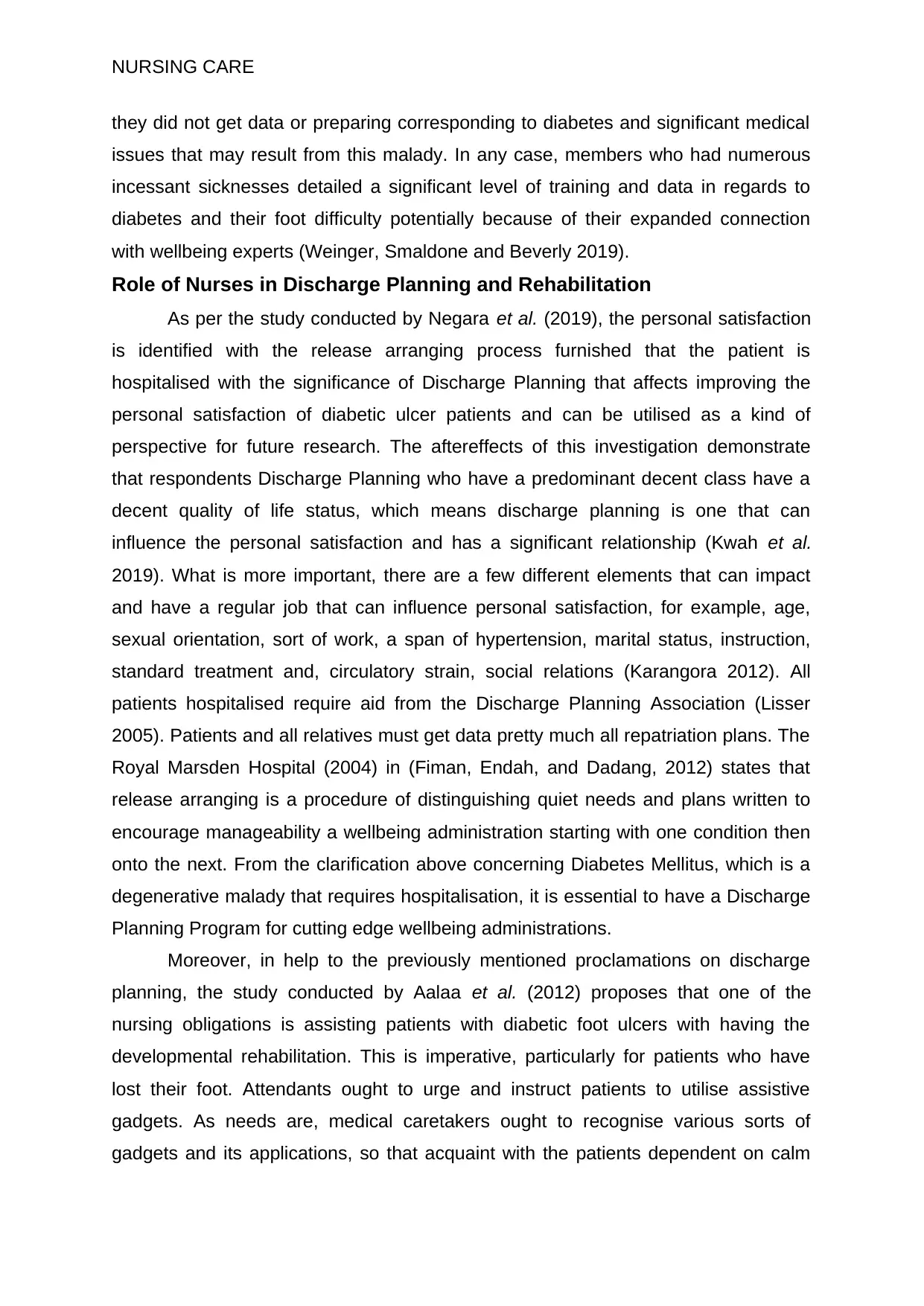
NURSING CARE
they did not get data or preparing corresponding to diabetes and significant medical
issues that may result from this malady. In any case, members who had numerous
incessant sicknesses detailed a significant level of training and data in regards to
diabetes and their foot difficulty potentially because of their expanded connection
with wellbeing experts (Weinger, Smaldone and Beverly 2019).
Role of Nurses in Discharge Planning and Rehabilitation
As per the study conducted by Negara et al. (2019), the personal satisfaction
is identified with the release arranging process furnished that the patient is
hospitalised with the significance of Discharge Planning that affects improving the
personal satisfaction of diabetic ulcer patients and can be utilised as a kind of
perspective for future research. The aftereffects of this investigation demonstrate
that respondents Discharge Planning who have a predominant decent class have a
decent quality of life status, which means discharge planning is one that can
influence the personal satisfaction and has a significant relationship (Kwah et al.
2019). What is more important, there are a few different elements that can impact
and have a regular job that can influence personal satisfaction, for example, age,
sexual orientation, sort of work, a span of hypertension, marital status, instruction,
standard treatment and, circulatory strain, social relations (Karangora 2012). All
patients hospitalised require aid from the Discharge Planning Association (Lisser
2005). Patients and all relatives must get data pretty much all repatriation plans. The
Royal Marsden Hospital (2004) in (Fiman, Endah, and Dadang, 2012) states that
release arranging is a procedure of distinguishing quiet needs and plans written to
encourage manageability a wellbeing administration starting with one condition then
onto the next. From the clarification above concerning Diabetes Mellitus, which is a
degenerative malady that requires hospitalisation, it is essential to have a Discharge
Planning Program for cutting edge wellbeing administrations.
Moreover, in help to the previously mentioned proclamations on discharge
planning, the study conducted by Aalaa et al. (2012) proposes that one of the
nursing obligations is assisting patients with diabetic foot ulcers with having the
developmental rehabilitation. This is imperative, particularly for patients who have
lost their foot. Attendants ought to urge and instruct patients to utilise assistive
gadgets. As needs are, medical caretakers ought to recognise various sorts of
gadgets and its applications, so that acquaint with the patients dependent on calm
they did not get data or preparing corresponding to diabetes and significant medical
issues that may result from this malady. In any case, members who had numerous
incessant sicknesses detailed a significant level of training and data in regards to
diabetes and their foot difficulty potentially because of their expanded connection
with wellbeing experts (Weinger, Smaldone and Beverly 2019).
Role of Nurses in Discharge Planning and Rehabilitation
As per the study conducted by Negara et al. (2019), the personal satisfaction
is identified with the release arranging process furnished that the patient is
hospitalised with the significance of Discharge Planning that affects improving the
personal satisfaction of diabetic ulcer patients and can be utilised as a kind of
perspective for future research. The aftereffects of this investigation demonstrate
that respondents Discharge Planning who have a predominant decent class have a
decent quality of life status, which means discharge planning is one that can
influence the personal satisfaction and has a significant relationship (Kwah et al.
2019). What is more important, there are a few different elements that can impact
and have a regular job that can influence personal satisfaction, for example, age,
sexual orientation, sort of work, a span of hypertension, marital status, instruction,
standard treatment and, circulatory strain, social relations (Karangora 2012). All
patients hospitalised require aid from the Discharge Planning Association (Lisser
2005). Patients and all relatives must get data pretty much all repatriation plans. The
Royal Marsden Hospital (2004) in (Fiman, Endah, and Dadang, 2012) states that
release arranging is a procedure of distinguishing quiet needs and plans written to
encourage manageability a wellbeing administration starting with one condition then
onto the next. From the clarification above concerning Diabetes Mellitus, which is a
degenerative malady that requires hospitalisation, it is essential to have a Discharge
Planning Program for cutting edge wellbeing administrations.
Moreover, in help to the previously mentioned proclamations on discharge
planning, the study conducted by Aalaa et al. (2012) proposes that one of the
nursing obligations is assisting patients with diabetic foot ulcers with having the
developmental rehabilitation. This is imperative, particularly for patients who have
lost their foot. Attendants ought to urge and instruct patients to utilise assistive
gadgets. As needs are, medical caretakers ought to recognise various sorts of
gadgets and its applications, so that acquaint with the patients dependent on calm
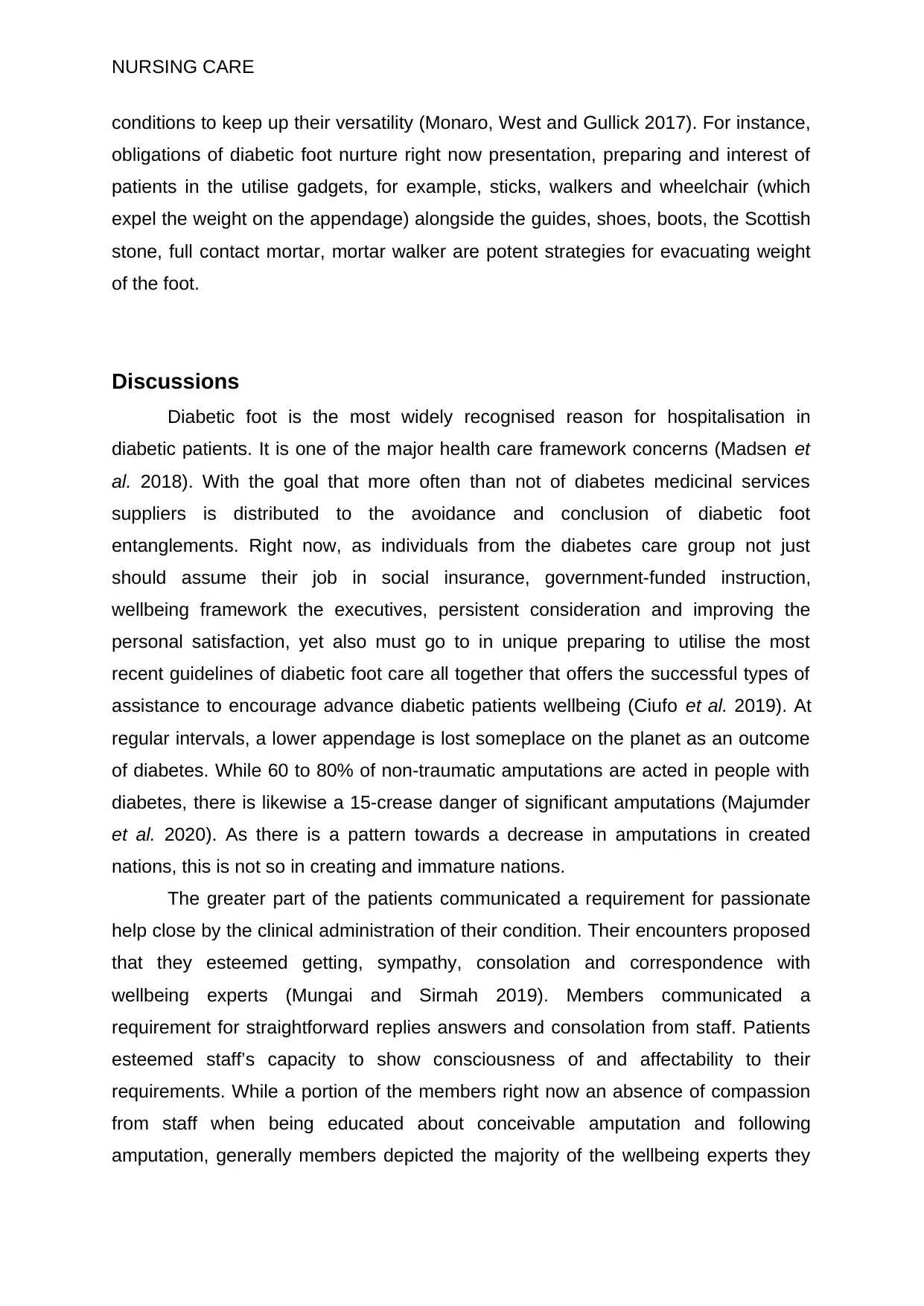
NURSING CARE
conditions to keep up their versatility (Monaro, West and Gullick 2017). For instance,
obligations of diabetic foot nurture right now presentation, preparing and interest of
patients in the utilise gadgets, for example, sticks, walkers and wheelchair (which
expel the weight on the appendage) alongside the guides, shoes, boots, the Scottish
stone, full contact mortar, mortar walker are potent strategies for evacuating weight
of the foot.
Discussions
Diabetic foot is the most widely recognised reason for hospitalisation in
diabetic patients. It is one of the major health care framework concerns (Madsen et
al. 2018). With the goal that more often than not of diabetes medicinal services
suppliers is distributed to the avoidance and conclusion of diabetic foot
entanglements. Right now, as individuals from the diabetes care group not just
should assume their job in social insurance, government-funded instruction,
wellbeing framework the executives, persistent consideration and improving the
personal satisfaction, yet also must go to in unique preparing to utilise the most
recent guidelines of diabetic foot care all together that offers the successful types of
assistance to encourage advance diabetic patients wellbeing (Ciufo et al. 2019). At
regular intervals, a lower appendage is lost someplace on the planet as an outcome
of diabetes. While 60 to 80% of non-traumatic amputations are acted in people with
diabetes, there is likewise a 15-crease danger of significant amputations (Majumder
et al. 2020). As there is a pattern towards a decrease in amputations in created
nations, this is not so in creating and immature nations.
The greater part of the patients communicated a requirement for passionate
help close by the clinical administration of their condition. Their encounters proposed
that they esteemed getting, sympathy, consolation and correspondence with
wellbeing experts (Mungai and Sirmah 2019). Members communicated a
requirement for straightforward replies answers and consolation from staff. Patients
esteemed staff’s capacity to show consciousness of and affectability to their
requirements. While a portion of the members right now an absence of compassion
from staff when being educated about conceivable amputation and following
amputation, generally members depicted the majority of the wellbeing experts they
conditions to keep up their versatility (Monaro, West and Gullick 2017). For instance,
obligations of diabetic foot nurture right now presentation, preparing and interest of
patients in the utilise gadgets, for example, sticks, walkers and wheelchair (which
expel the weight on the appendage) alongside the guides, shoes, boots, the Scottish
stone, full contact mortar, mortar walker are potent strategies for evacuating weight
of the foot.
Discussions
Diabetic foot is the most widely recognised reason for hospitalisation in
diabetic patients. It is one of the major health care framework concerns (Madsen et
al. 2018). With the goal that more often than not of diabetes medicinal services
suppliers is distributed to the avoidance and conclusion of diabetic foot
entanglements. Right now, as individuals from the diabetes care group not just
should assume their job in social insurance, government-funded instruction,
wellbeing framework the executives, persistent consideration and improving the
personal satisfaction, yet also must go to in unique preparing to utilise the most
recent guidelines of diabetic foot care all together that offers the successful types of
assistance to encourage advance diabetic patients wellbeing (Ciufo et al. 2019). At
regular intervals, a lower appendage is lost someplace on the planet as an outcome
of diabetes. While 60 to 80% of non-traumatic amputations are acted in people with
diabetes, there is likewise a 15-crease danger of significant amputations (Majumder
et al. 2020). As there is a pattern towards a decrease in amputations in created
nations, this is not so in creating and immature nations.
The greater part of the patients communicated a requirement for passionate
help close by the clinical administration of their condition. Their encounters proposed
that they esteemed getting, sympathy, consolation and correspondence with
wellbeing experts (Mungai and Sirmah 2019). Members communicated a
requirement for straightforward replies answers and consolation from staff. Patients
esteemed staff’s capacity to show consciousness of and affectability to their
requirements. While a portion of the members right now an absence of compassion
from staff when being educated about conceivable amputation and following
amputation, generally members depicted the majority of the wellbeing experts they
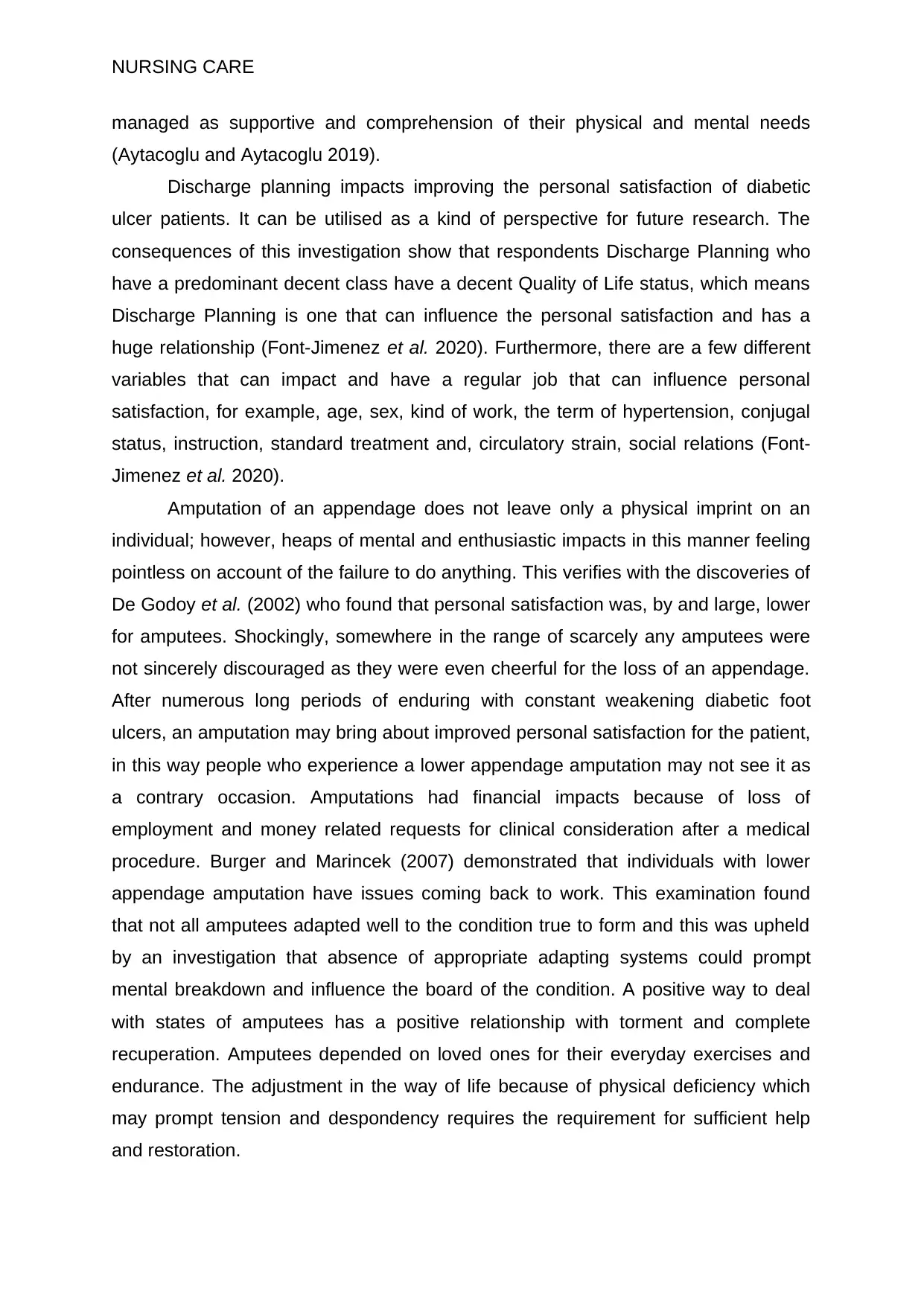
NURSING CARE
managed as supportive and comprehension of their physical and mental needs
(Aytacoglu and Aytacoglu 2019).
Discharge planning impacts improving the personal satisfaction of diabetic
ulcer patients. It can be utilised as a kind of perspective for future research. The
consequences of this investigation show that respondents Discharge Planning who
have a predominant decent class have a decent Quality of Life status, which means
Discharge Planning is one that can influence the personal satisfaction and has a
huge relationship (Font-Jimenez et al. 2020). Furthermore, there are a few different
variables that can impact and have a regular job that can influence personal
satisfaction, for example, age, sex, kind of work, the term of hypertension, conjugal
status, instruction, standard treatment and, circulatory strain, social relations (Font-
Jimenez et al. 2020).
Amputation of an appendage does not leave only a physical imprint on an
individual; however, heaps of mental and enthusiastic impacts in this manner feeling
pointless on account of the failure to do anything. This verifies with the discoveries of
De Godoy et al. (2002) who found that personal satisfaction was, by and large, lower
for amputees. Shockingly, somewhere in the range of scarcely any amputees were
not sincerely discouraged as they were even cheerful for the loss of an appendage.
After numerous long periods of enduring with constant weakening diabetic foot
ulcers, an amputation may bring about improved personal satisfaction for the patient,
in this way people who experience a lower appendage amputation may not see it as
a contrary occasion. Amputations had financial impacts because of loss of
employment and money related requests for clinical consideration after a medical
procedure. Burger and Marincek (2007) demonstrated that individuals with lower
appendage amputation have issues coming back to work. This examination found
that not all amputees adapted well to the condition true to form and this was upheld
by an investigation that absence of appropriate adapting systems could prompt
mental breakdown and influence the board of the condition. A positive way to deal
with states of amputees has a positive relationship with torment and complete
recuperation. Amputees depended on loved ones for their everyday exercises and
endurance. The adjustment in the way of life because of physical deficiency which
may prompt tension and despondency requires the requirement for sufficient help
and restoration.
managed as supportive and comprehension of their physical and mental needs
(Aytacoglu and Aytacoglu 2019).
Discharge planning impacts improving the personal satisfaction of diabetic
ulcer patients. It can be utilised as a kind of perspective for future research. The
consequences of this investigation show that respondents Discharge Planning who
have a predominant decent class have a decent Quality of Life status, which means
Discharge Planning is one that can influence the personal satisfaction and has a
huge relationship (Font-Jimenez et al. 2020). Furthermore, there are a few different
variables that can impact and have a regular job that can influence personal
satisfaction, for example, age, sex, kind of work, the term of hypertension, conjugal
status, instruction, standard treatment and, circulatory strain, social relations (Font-
Jimenez et al. 2020).
Amputation of an appendage does not leave only a physical imprint on an
individual; however, heaps of mental and enthusiastic impacts in this manner feeling
pointless on account of the failure to do anything. This verifies with the discoveries of
De Godoy et al. (2002) who found that personal satisfaction was, by and large, lower
for amputees. Shockingly, somewhere in the range of scarcely any amputees were
not sincerely discouraged as they were even cheerful for the loss of an appendage.
After numerous long periods of enduring with constant weakening diabetic foot
ulcers, an amputation may bring about improved personal satisfaction for the patient,
in this way people who experience a lower appendage amputation may not see it as
a contrary occasion. Amputations had financial impacts because of loss of
employment and money related requests for clinical consideration after a medical
procedure. Burger and Marincek (2007) demonstrated that individuals with lower
appendage amputation have issues coming back to work. This examination found
that not all amputees adapted well to the condition true to form and this was upheld
by an investigation that absence of appropriate adapting systems could prompt
mental breakdown and influence the board of the condition. A positive way to deal
with states of amputees has a positive relationship with torment and complete
recuperation. Amputees depended on loved ones for their everyday exercises and
endurance. The adjustment in the way of life because of physical deficiency which
may prompt tension and despondency requires the requirement for sufficient help
and restoration.
Paraphrase This Document
Need a fresh take? Get an instant paraphrase of this document with our AI Paraphraser
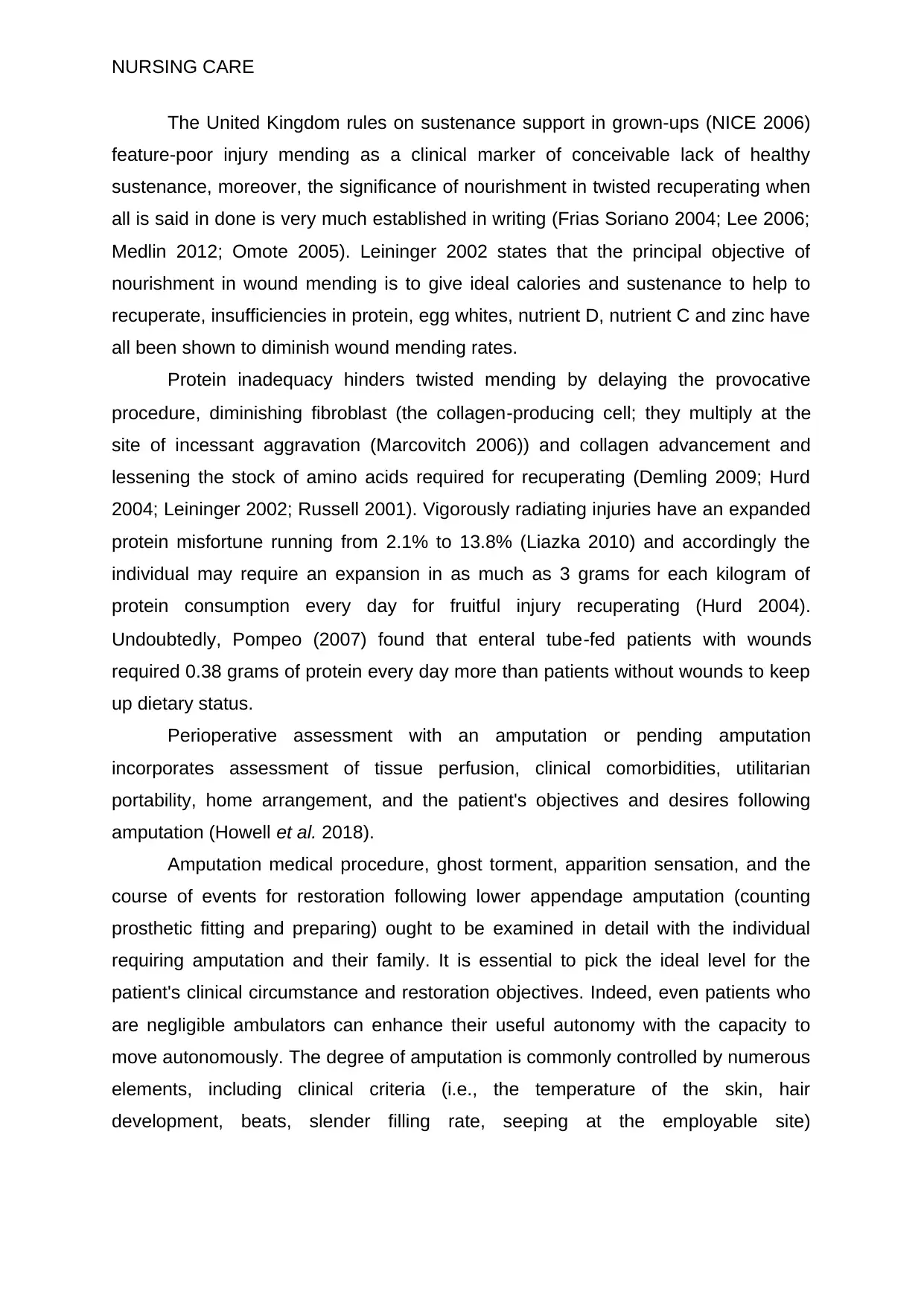
NURSING CARE
The United Kingdom rules on sustenance support in grown-ups (NICE 2006)
feature-poor injury mending as a clinical marker of conceivable lack of healthy
sustenance, moreover, the significance of nourishment in twisted recuperating when
all is said in done is very much established in writing (Frias Soriano 2004; Lee 2006;
Medlin 2012; Omote 2005). Leininger 2002 states that the principal objective of
nourishment in wound mending is to give ideal calories and sustenance to help to
recuperate, insufficiencies in protein, egg whites, nutrient D, nutrient C and zinc have
all been shown to diminish wound mending rates.
Protein inadequacy hinders twisted mending by delaying the provocative
procedure, diminishing fibroblast (the collagen‐producing cell; they multiply at the
site of incessant aggravation (Marcovitch 2006)) and collagen advancement and
lessening the stock of amino acids required for recuperating (Demling 2009; Hurd
2004; Leininger 2002; Russell 2001). Vigorously radiating injuries have an expanded
protein misfortune running from 2.1% to 13.8% (Liazka 2010) and accordingly the
individual may require an expansion in as much as 3 grams for each kilogram of
protein consumption every day for fruitful injury recuperating (Hurd 2004).
Undoubtedly, Pompeo (2007) found that enteral tube‐fed patients with wounds
required 0.38 grams of protein every day more than patients without wounds to keep
up dietary status.
Perioperative assessment with an amputation or pending amputation
incorporates assessment of tissue perfusion, clinical comorbidities, utilitarian
portability, home arrangement, and the patient's objectives and desires following
amputation (Howell et al. 2018).
Amputation medical procedure, ghost torment, apparition sensation, and the
course of events for restoration following lower appendage amputation (counting
prosthetic fitting and preparing) ought to be examined in detail with the individual
requiring amputation and their family. It is essential to pick the ideal level for the
patient's clinical circumstance and restoration objectives. Indeed, even patients who
are negligible ambulators can enhance their useful autonomy with the capacity to
move autonomously. The degree of amputation is commonly controlled by numerous
elements, including clinical criteria (i.e., the temperature of the skin, hair
development, beats, slender filling rate, seeping at the employable site)
The United Kingdom rules on sustenance support in grown-ups (NICE 2006)
feature-poor injury mending as a clinical marker of conceivable lack of healthy
sustenance, moreover, the significance of nourishment in twisted recuperating when
all is said in done is very much established in writing (Frias Soriano 2004; Lee 2006;
Medlin 2012; Omote 2005). Leininger 2002 states that the principal objective of
nourishment in wound mending is to give ideal calories and sustenance to help to
recuperate, insufficiencies in protein, egg whites, nutrient D, nutrient C and zinc have
all been shown to diminish wound mending rates.
Protein inadequacy hinders twisted mending by delaying the provocative
procedure, diminishing fibroblast (the collagen‐producing cell; they multiply at the
site of incessant aggravation (Marcovitch 2006)) and collagen advancement and
lessening the stock of amino acids required for recuperating (Demling 2009; Hurd
2004; Leininger 2002; Russell 2001). Vigorously radiating injuries have an expanded
protein misfortune running from 2.1% to 13.8% (Liazka 2010) and accordingly the
individual may require an expansion in as much as 3 grams for each kilogram of
protein consumption every day for fruitful injury recuperating (Hurd 2004).
Undoubtedly, Pompeo (2007) found that enteral tube‐fed patients with wounds
required 0.38 grams of protein every day more than patients without wounds to keep
up dietary status.
Perioperative assessment with an amputation or pending amputation
incorporates assessment of tissue perfusion, clinical comorbidities, utilitarian
portability, home arrangement, and the patient's objectives and desires following
amputation (Howell et al. 2018).
Amputation medical procedure, ghost torment, apparition sensation, and the
course of events for restoration following lower appendage amputation (counting
prosthetic fitting and preparing) ought to be examined in detail with the individual
requiring amputation and their family. It is essential to pick the ideal level for the
patient's clinical circumstance and restoration objectives. Indeed, even patients who
are negligible ambulators can enhance their useful autonomy with the capacity to
move autonomously. The degree of amputation is commonly controlled by numerous
elements, including clinical criteria (i.e., the temperature of the skin, hair
development, beats, slender filling rate, seeping at the employable site)
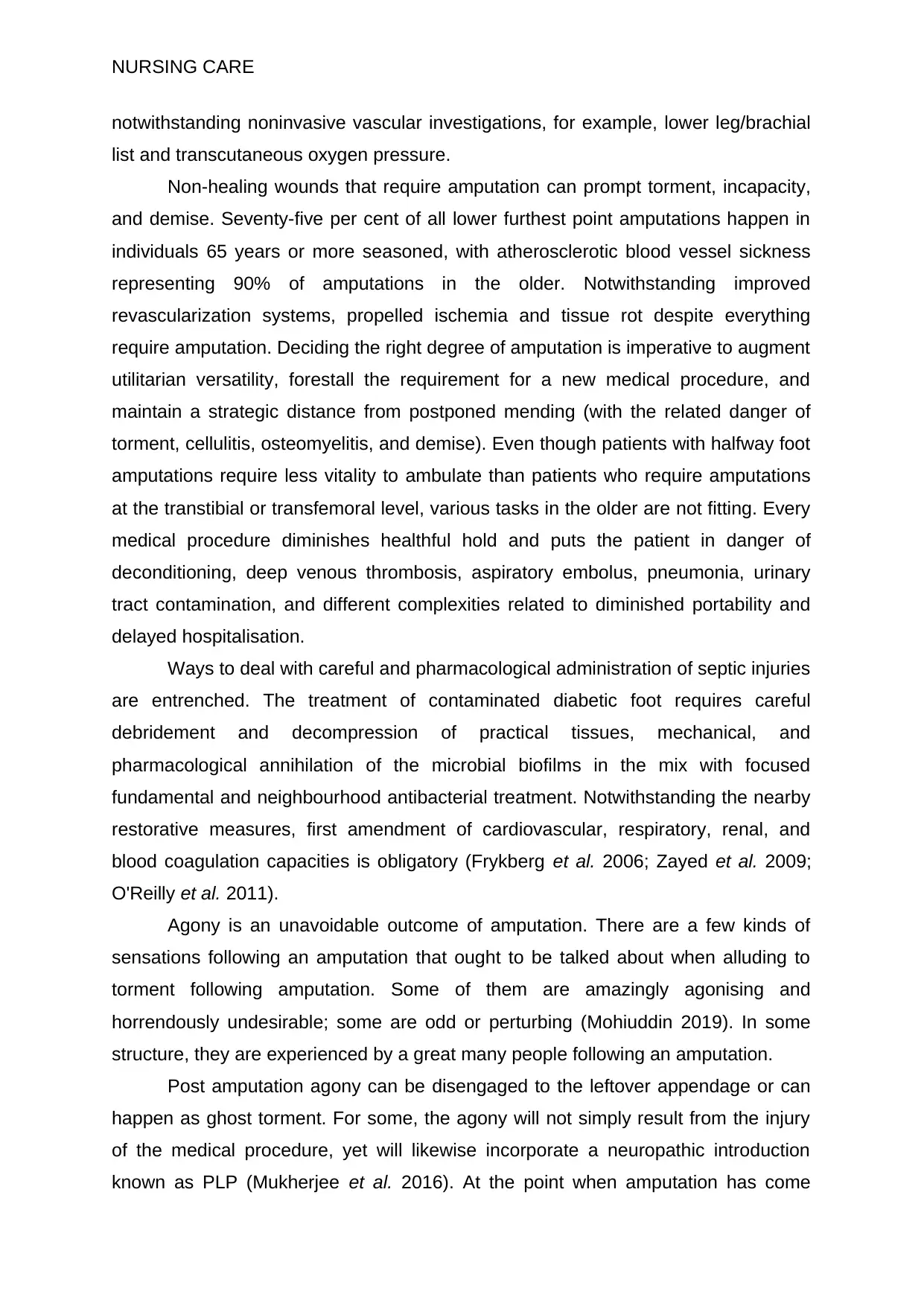
NURSING CARE
notwithstanding noninvasive vascular investigations, for example, lower leg/brachial
list and transcutaneous oxygen pressure.
Non-healing wounds that require amputation can prompt torment, incapacity,
and demise. Seventy-five per cent of all lower furthest point amputations happen in
individuals 65 years or more seasoned, with atherosclerotic blood vessel sickness
representing 90% of amputations in the older. Notwithstanding improved
revascularization systems, propelled ischemia and tissue rot despite everything
require amputation. Deciding the right degree of amputation is imperative to augment
utilitarian versatility, forestall the requirement for a new medical procedure, and
maintain a strategic distance from postponed mending (with the related danger of
torment, cellulitis, osteomyelitis, and demise). Even though patients with halfway foot
amputations require less vitality to ambulate than patients who require amputations
at the transtibial or transfemoral level, various tasks in the older are not fitting. Every
medical procedure diminishes healthful hold and puts the patient in danger of
deconditioning, deep venous thrombosis, aspiratory embolus, pneumonia, urinary
tract contamination, and different complexities related to diminished portability and
delayed hospitalisation.
Ways to deal with careful and pharmacological administration of septic injuries
are entrenched. The treatment of contaminated diabetic foot requires careful
debridement and decompression of practical tissues, mechanical, and
pharmacological annihilation of the microbial biofilms in the mix with focused
fundamental and neighbourhood antibacterial treatment. Notwithstanding the nearby
restorative measures, first amendment of cardiovascular, respiratory, renal, and
blood coagulation capacities is obligatory (Frykberg et al. 2006; Zayed et al. 2009;
O'Reilly et al. 2011).
Agony is an unavoidable outcome of amputation. There are a few kinds of
sensations following an amputation that ought to be talked about when alluding to
torment following amputation. Some of them are amazingly agonising and
horrendously undesirable; some are odd or perturbing (Mohiuddin 2019). In some
structure, they are experienced by a great many people following an amputation.
Post amputation agony can be disengaged to the leftover appendage or can
happen as ghost torment. For some, the agony will not simply result from the injury
of the medical procedure, yet will likewise incorporate a neuropathic introduction
known as PLP (Mukherjee et al. 2016). At the point when amputation has come
notwithstanding noninvasive vascular investigations, for example, lower leg/brachial
list and transcutaneous oxygen pressure.
Non-healing wounds that require amputation can prompt torment, incapacity,
and demise. Seventy-five per cent of all lower furthest point amputations happen in
individuals 65 years or more seasoned, with atherosclerotic blood vessel sickness
representing 90% of amputations in the older. Notwithstanding improved
revascularization systems, propelled ischemia and tissue rot despite everything
require amputation. Deciding the right degree of amputation is imperative to augment
utilitarian versatility, forestall the requirement for a new medical procedure, and
maintain a strategic distance from postponed mending (with the related danger of
torment, cellulitis, osteomyelitis, and demise). Even though patients with halfway foot
amputations require less vitality to ambulate than patients who require amputations
at the transtibial or transfemoral level, various tasks in the older are not fitting. Every
medical procedure diminishes healthful hold and puts the patient in danger of
deconditioning, deep venous thrombosis, aspiratory embolus, pneumonia, urinary
tract contamination, and different complexities related to diminished portability and
delayed hospitalisation.
Ways to deal with careful and pharmacological administration of septic injuries
are entrenched. The treatment of contaminated diabetic foot requires careful
debridement and decompression of practical tissues, mechanical, and
pharmacological annihilation of the microbial biofilms in the mix with focused
fundamental and neighbourhood antibacterial treatment. Notwithstanding the nearby
restorative measures, first amendment of cardiovascular, respiratory, renal, and
blood coagulation capacities is obligatory (Frykberg et al. 2006; Zayed et al. 2009;
O'Reilly et al. 2011).
Agony is an unavoidable outcome of amputation. There are a few kinds of
sensations following an amputation that ought to be talked about when alluding to
torment following amputation. Some of them are amazingly agonising and
horrendously undesirable; some are odd or perturbing (Mohiuddin 2019). In some
structure, they are experienced by a great many people following an amputation.
Post amputation agony can be disengaged to the leftover appendage or can
happen as ghost torment. For some, the agony will not simply result from the injury
of the medical procedure, yet will likewise incorporate a neuropathic introduction
known as PLP (Mukherjee et al. 2016). At the point when amputation has come

NURSING CARE
about because of a horrible episode, for example, in a catastrophe setting, this can
be entangled by existing together injury to a similar appendage or different pieces of
the body. For the physiotherapists associated with the early and post-intense phases
of restoration, the test is deciding the nociceptive and neuropathic causes which
require consideration so as to deal with the patient, thus empower successful
recovery to happen (Haque and Tan, 2017). After amputation, it is not phenomenal
for patients to encounter torment, muscle shortcoming or insecurity in structures not
straightforwardly connected with the amputation (Lernevall et al. 2017).
The impacts of bed rest and diminished versatility are likewise all around
archived. Deconditioning brings about lessened bulk, sarcomere shortening
diminished muscle quality and changes in cartilaginous structures (Yeoman, A. and
Harland, 2017; Bemben et al. 2017). It is, accordingly, significant, that amputee
patients embrace functional recovery and customised practice programs from as
ahead of schedule as day one post-medical procedure (Lernevall et al. 2017). Knee
flexion contractures and hip flexion contractures are normal inconveniences post
amputation and can affect altogether on prosthetic recovery (Ghazali et al. 2018).
Strengths and Limitations
The study provides an extended review of literature on the research topic of
post-amputation nursing care for diabetic patients, intending to review the perception
of the patients who have suffered from diabetic foot ulcer and have undergone leg
amputation recently. Very few studies conducted in the past have reviewed the
different aspects of nursing care and due to this fact, the comprehensive overview of
the nursing roles, perception of the amputees and the care aspects post-operation
provided in this paper marks as its major strength (Schreiber, 2017). The paper
deals integrate the knowledge on the perception of the patients with the nursing care
roles and responsibilities to determine the better versions of the latter and provide
remarks on the necessary changes to be induced in the nursing care to help adjust
the demands of the patient. The following of structured protocol and standard
inclusion criteria is another strength of this study (Eide et al. 2019). However, there
are a few limitations associated with this study, as well. Even though the stringent
range of publication date of the studies may aid in reviewing the latest publications
relevant to the research question, it leads to missing of several important and highly
relevant studies that were conducted in the past and appeared in the search results
about because of a horrible episode, for example, in a catastrophe setting, this can
be entangled by existing together injury to a similar appendage or different pieces of
the body. For the physiotherapists associated with the early and post-intense phases
of restoration, the test is deciding the nociceptive and neuropathic causes which
require consideration so as to deal with the patient, thus empower successful
recovery to happen (Haque and Tan, 2017). After amputation, it is not phenomenal
for patients to encounter torment, muscle shortcoming or insecurity in structures not
straightforwardly connected with the amputation (Lernevall et al. 2017).
The impacts of bed rest and diminished versatility are likewise all around
archived. Deconditioning brings about lessened bulk, sarcomere shortening
diminished muscle quality and changes in cartilaginous structures (Yeoman, A. and
Harland, 2017; Bemben et al. 2017). It is, accordingly, significant, that amputee
patients embrace functional recovery and customised practice programs from as
ahead of schedule as day one post-medical procedure (Lernevall et al. 2017). Knee
flexion contractures and hip flexion contractures are normal inconveniences post
amputation and can affect altogether on prosthetic recovery (Ghazali et al. 2018).
Strengths and Limitations
The study provides an extended review of literature on the research topic of
post-amputation nursing care for diabetic patients, intending to review the perception
of the patients who have suffered from diabetic foot ulcer and have undergone leg
amputation recently. Very few studies conducted in the past have reviewed the
different aspects of nursing care and due to this fact, the comprehensive overview of
the nursing roles, perception of the amputees and the care aspects post-operation
provided in this paper marks as its major strength (Schreiber, 2017). The paper
deals integrate the knowledge on the perception of the patients with the nursing care
roles and responsibilities to determine the better versions of the latter and provide
remarks on the necessary changes to be induced in the nursing care to help adjust
the demands of the patient. The following of structured protocol and standard
inclusion criteria is another strength of this study (Eide et al. 2019). However, there
are a few limitations associated with this study, as well. Even though the stringent
range of publication date of the studies may aid in reviewing the latest publications
relevant to the research question, it leads to missing of several important and highly
relevant studies that were conducted in the past and appeared in the search results
Secure Best Marks with AI Grader
Need help grading? Try our AI Grader for instant feedback on your assignments.
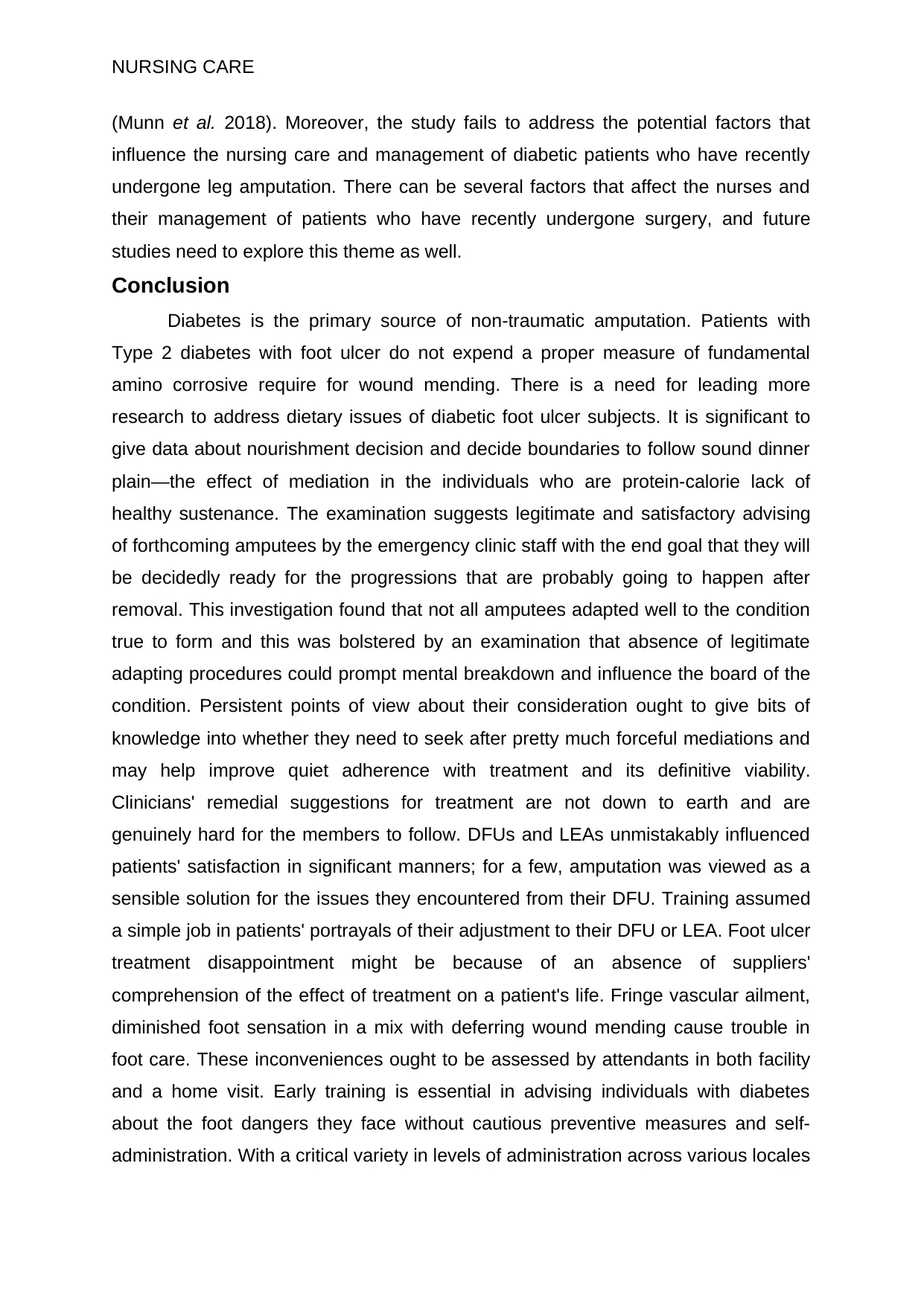
NURSING CARE
(Munn et al. 2018). Moreover, the study fails to address the potential factors that
influence the nursing care and management of diabetic patients who have recently
undergone leg amputation. There can be several factors that affect the nurses and
their management of patients who have recently undergone surgery, and future
studies need to explore this theme as well.
Conclusion
Diabetes is the primary source of non-traumatic amputation. Patients with
Type 2 diabetes with foot ulcer do not expend a proper measure of fundamental
amino corrosive require for wound mending. There is a need for leading more
research to address dietary issues of diabetic foot ulcer subjects. It is significant to
give data about nourishment decision and decide boundaries to follow sound dinner
plain—the effect of mediation in the individuals who are protein-calorie lack of
healthy sustenance. The examination suggests legitimate and satisfactory advising
of forthcoming amputees by the emergency clinic staff with the end goal that they will
be decidedly ready for the progressions that are probably going to happen after
removal. This investigation found that not all amputees adapted well to the condition
true to form and this was bolstered by an examination that absence of legitimate
adapting procedures could prompt mental breakdown and influence the board of the
condition. Persistent points of view about their consideration ought to give bits of
knowledge into whether they need to seek after pretty much forceful mediations and
may help improve quiet adherence with treatment and its definitive viability.
Clinicians' remedial suggestions for treatment are not down to earth and are
genuinely hard for the members to follow. DFUs and LEAs unmistakably influenced
patients' satisfaction in significant manners; for a few, amputation was viewed as a
sensible solution for the issues they encountered from their DFU. Training assumed
a simple job in patients' portrayals of their adjustment to their DFU or LEA. Foot ulcer
treatment disappointment might be because of an absence of suppliers'
comprehension of the effect of treatment on a patient's life. Fringe vascular ailment,
diminished foot sensation in a mix with deferring wound mending cause trouble in
foot care. These inconveniences ought to be assessed by attendants in both facility
and a home visit. Early training is essential in advising individuals with diabetes
about the foot dangers they face without cautious preventive measures and self-
administration. With a critical variety in levels of administration across various locales
(Munn et al. 2018). Moreover, the study fails to address the potential factors that
influence the nursing care and management of diabetic patients who have recently
undergone leg amputation. There can be several factors that affect the nurses and
their management of patients who have recently undergone surgery, and future
studies need to explore this theme as well.
Conclusion
Diabetes is the primary source of non-traumatic amputation. Patients with
Type 2 diabetes with foot ulcer do not expend a proper measure of fundamental
amino corrosive require for wound mending. There is a need for leading more
research to address dietary issues of diabetic foot ulcer subjects. It is significant to
give data about nourishment decision and decide boundaries to follow sound dinner
plain—the effect of mediation in the individuals who are protein-calorie lack of
healthy sustenance. The examination suggests legitimate and satisfactory advising
of forthcoming amputees by the emergency clinic staff with the end goal that they will
be decidedly ready for the progressions that are probably going to happen after
removal. This investigation found that not all amputees adapted well to the condition
true to form and this was bolstered by an examination that absence of legitimate
adapting procedures could prompt mental breakdown and influence the board of the
condition. Persistent points of view about their consideration ought to give bits of
knowledge into whether they need to seek after pretty much forceful mediations and
may help improve quiet adherence with treatment and its definitive viability.
Clinicians' remedial suggestions for treatment are not down to earth and are
genuinely hard for the members to follow. DFUs and LEAs unmistakably influenced
patients' satisfaction in significant manners; for a few, amputation was viewed as a
sensible solution for the issues they encountered from their DFU. Training assumed
a simple job in patients' portrayals of their adjustment to their DFU or LEA. Foot ulcer
treatment disappointment might be because of an absence of suppliers'
comprehension of the effect of treatment on a patient's life. Fringe vascular ailment,
diminished foot sensation in a mix with deferring wound mending cause trouble in
foot care. These inconveniences ought to be assessed by attendants in both facility
and a home visit. Early training is essential in advising individuals with diabetes
about the foot dangers they face without cautious preventive measures and self-
administration. With a critical variety in levels of administration across various locales
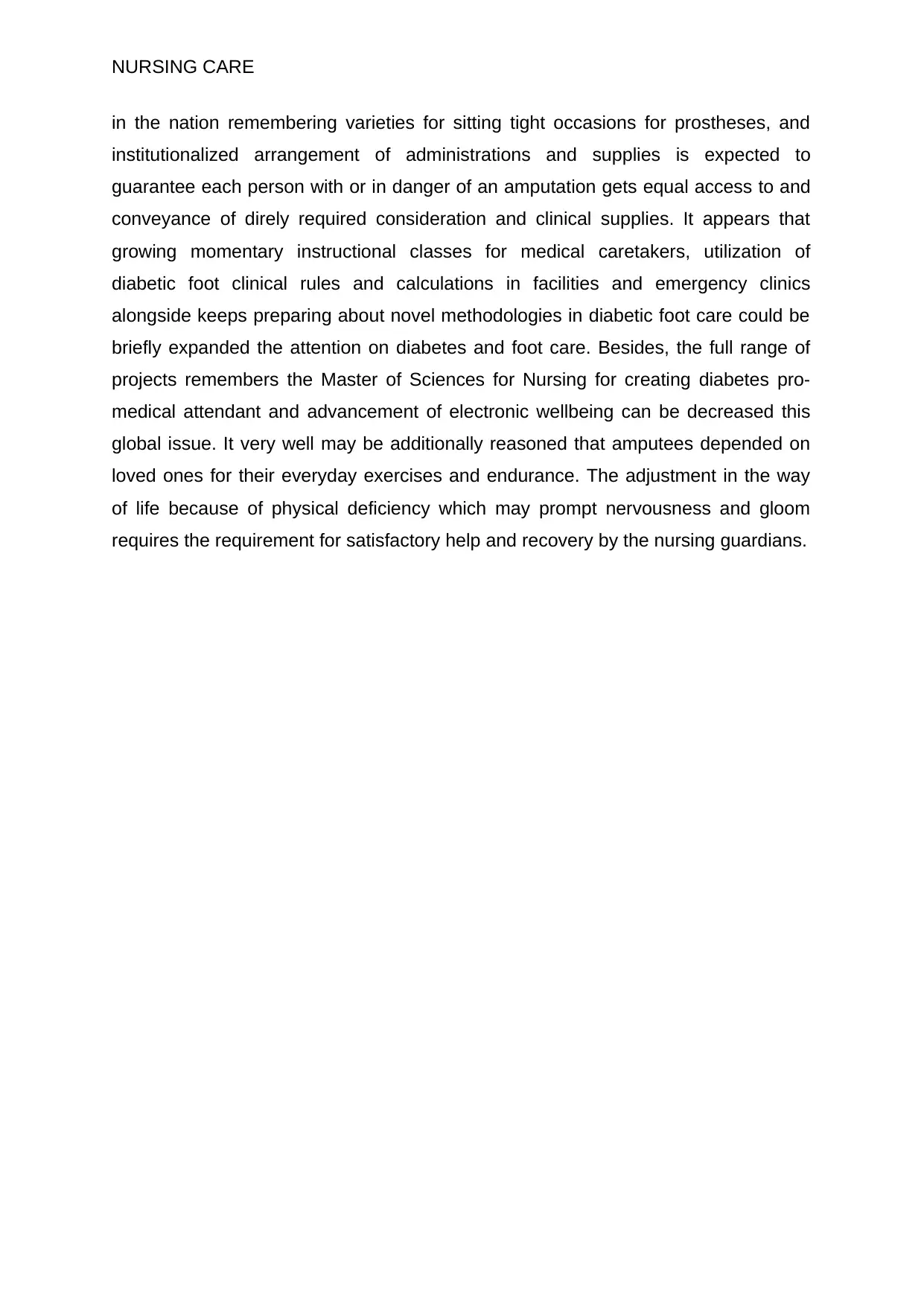
NURSING CARE
in the nation remembering varieties for sitting tight occasions for prostheses, and
institutionalized arrangement of administrations and supplies is expected to
guarantee each person with or in danger of an amputation gets equal access to and
conveyance of direly required consideration and clinical supplies. It appears that
growing momentary instructional classes for medical caretakers, utilization of
diabetic foot clinical rules and calculations in facilities and emergency clinics
alongside keeps preparing about novel methodologies in diabetic foot care could be
briefly expanded the attention on diabetes and foot care. Besides, the full range of
projects remembers the Master of Sciences for Nursing for creating diabetes pro-
medical attendant and advancement of electronic wellbeing can be decreased this
global issue. It very well may be additionally reasoned that amputees depended on
loved ones for their everyday exercises and endurance. The adjustment in the way
of life because of physical deficiency which may prompt nervousness and gloom
requires the requirement for satisfactory help and recovery by the nursing guardians.
in the nation remembering varieties for sitting tight occasions for prostheses, and
institutionalized arrangement of administrations and supplies is expected to
guarantee each person with or in danger of an amputation gets equal access to and
conveyance of direly required consideration and clinical supplies. It appears that
growing momentary instructional classes for medical caretakers, utilization of
diabetic foot clinical rules and calculations in facilities and emergency clinics
alongside keeps preparing about novel methodologies in diabetic foot care could be
briefly expanded the attention on diabetes and foot care. Besides, the full range of
projects remembers the Master of Sciences for Nursing for creating diabetes pro-
medical attendant and advancement of electronic wellbeing can be decreased this
global issue. It very well may be additionally reasoned that amputees depended on
loved ones for their everyday exercises and endurance. The adjustment in the way
of life because of physical deficiency which may prompt nervousness and gloom
requires the requirement for satisfactory help and recovery by the nursing guardians.
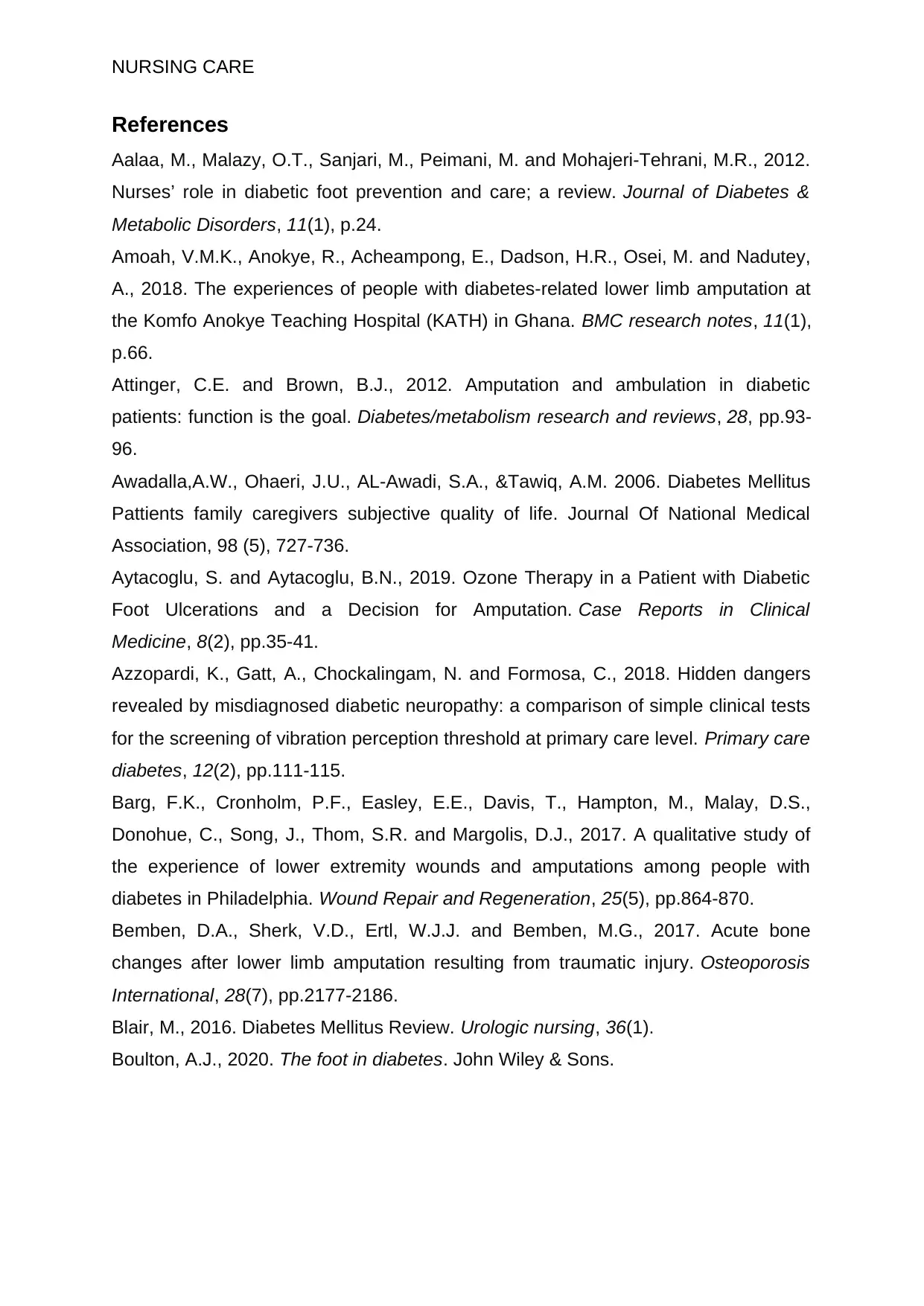
NURSING CARE
References
Aalaa, M., Malazy, O.T., Sanjari, M., Peimani, M. and Mohajeri-Tehrani, M.R., 2012.
Nurses’ role in diabetic foot prevention and care; a review. Journal of Diabetes &
Metabolic Disorders, 11(1), p.24.
Amoah, V.M.K., Anokye, R., Acheampong, E., Dadson, H.R., Osei, M. and Nadutey,
A., 2018. The experiences of people with diabetes-related lower limb amputation at
the Komfo Anokye Teaching Hospital (KATH) in Ghana. BMC research notes, 11(1),
p.66.
Attinger, C.E. and Brown, B.J., 2012. Amputation and ambulation in diabetic
patients: function is the goal. Diabetes/metabolism research and reviews, 28, pp.93-
96.
Awadalla,A.W., Ohaeri, J.U., AL-Awadi, S.A., &Tawiq, A.M. 2006. Diabetes Mellitus
Pattients family caregivers subjective quality of life. Journal Of National Medical
Association, 98 (5), 727-736.
Aytacoglu, S. and Aytacoglu, B.N., 2019. Ozone Therapy in a Patient with Diabetic
Foot Ulcerations and a Decision for Amputation. Case Reports in Clinical
Medicine, 8(2), pp.35-41.
Azzopardi, K., Gatt, A., Chockalingam, N. and Formosa, C., 2018. Hidden dangers
revealed by misdiagnosed diabetic neuropathy: a comparison of simple clinical tests
for the screening of vibration perception threshold at primary care level. Primary care
diabetes, 12(2), pp.111-115.
Barg, F.K., Cronholm, P.F., Easley, E.E., Davis, T., Hampton, M., Malay, D.S.,
Donohue, C., Song, J., Thom, S.R. and Margolis, D.J., 2017. A qualitative study of
the experience of lower extremity wounds and amputations among people with
diabetes in Philadelphia. Wound Repair and Regeneration, 25(5), pp.864-870.
Bemben, D.A., Sherk, V.D., Ertl, W.J.J. and Bemben, M.G., 2017. Acute bone
changes after lower limb amputation resulting from traumatic injury. Osteoporosis
International, 28(7), pp.2177-2186.
Blair, M., 2016. Diabetes Mellitus Review. Urologic nursing, 36(1).
Boulton, A.J., 2020. The foot in diabetes. John Wiley & Sons.
References
Aalaa, M., Malazy, O.T., Sanjari, M., Peimani, M. and Mohajeri-Tehrani, M.R., 2012.
Nurses’ role in diabetic foot prevention and care; a review. Journal of Diabetes &
Metabolic Disorders, 11(1), p.24.
Amoah, V.M.K., Anokye, R., Acheampong, E., Dadson, H.R., Osei, M. and Nadutey,
A., 2018. The experiences of people with diabetes-related lower limb amputation at
the Komfo Anokye Teaching Hospital (KATH) in Ghana. BMC research notes, 11(1),
p.66.
Attinger, C.E. and Brown, B.J., 2012. Amputation and ambulation in diabetic
patients: function is the goal. Diabetes/metabolism research and reviews, 28, pp.93-
96.
Awadalla,A.W., Ohaeri, J.U., AL-Awadi, S.A., &Tawiq, A.M. 2006. Diabetes Mellitus
Pattients family caregivers subjective quality of life. Journal Of National Medical
Association, 98 (5), 727-736.
Aytacoglu, S. and Aytacoglu, B.N., 2019. Ozone Therapy in a Patient with Diabetic
Foot Ulcerations and a Decision for Amputation. Case Reports in Clinical
Medicine, 8(2), pp.35-41.
Azzopardi, K., Gatt, A., Chockalingam, N. and Formosa, C., 2018. Hidden dangers
revealed by misdiagnosed diabetic neuropathy: a comparison of simple clinical tests
for the screening of vibration perception threshold at primary care level. Primary care
diabetes, 12(2), pp.111-115.
Barg, F.K., Cronholm, P.F., Easley, E.E., Davis, T., Hampton, M., Malay, D.S.,
Donohue, C., Song, J., Thom, S.R. and Margolis, D.J., 2017. A qualitative study of
the experience of lower extremity wounds and amputations among people with
diabetes in Philadelphia. Wound Repair and Regeneration, 25(5), pp.864-870.
Bemben, D.A., Sherk, V.D., Ertl, W.J.J. and Bemben, M.G., 2017. Acute bone
changes after lower limb amputation resulting from traumatic injury. Osteoporosis
International, 28(7), pp.2177-2186.
Blair, M., 2016. Diabetes Mellitus Review. Urologic nursing, 36(1).
Boulton, A.J., 2020. The foot in diabetes. John Wiley & Sons.
Paraphrase This Document
Need a fresh take? Get an instant paraphrase of this document with our AI Paraphraser
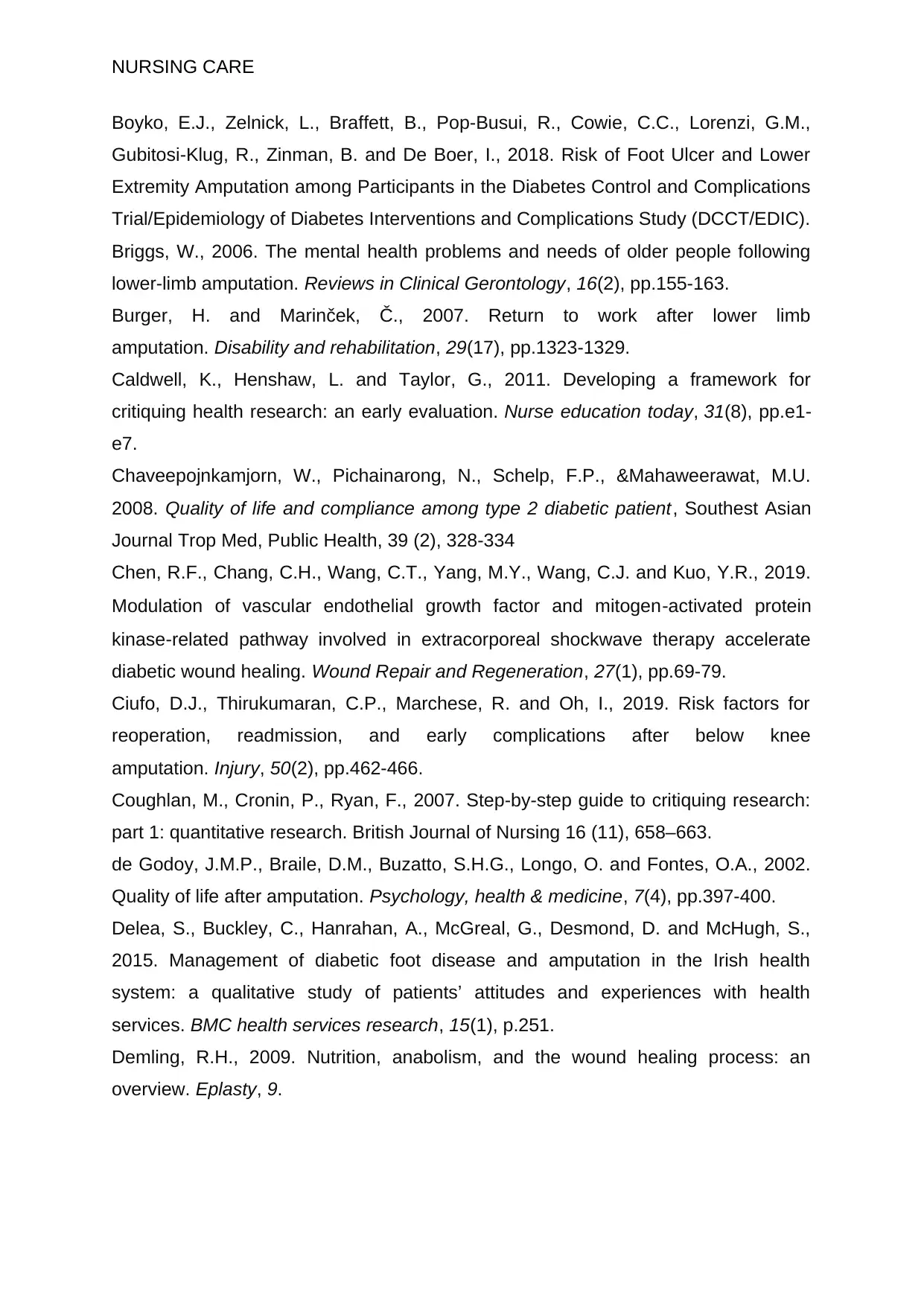
NURSING CARE
Boyko, E.J., Zelnick, L., Braffett, B., Pop-Busui, R., Cowie, C.C., Lorenzi, G.M.,
Gubitosi-Klug, R., Zinman, B. and De Boer, I., 2018. Risk of Foot Ulcer and Lower
Extremity Amputation among Participants in the Diabetes Control and Complications
Trial/Epidemiology of Diabetes Interventions and Complications Study (DCCT/EDIC).
Briggs, W., 2006. The mental health problems and needs of older people following
lower-limb amputation. Reviews in Clinical Gerontology, 16(2), pp.155-163.
Burger, H. and Marinček, Č., 2007. Return to work after lower limb
amputation. Disability and rehabilitation, 29(17), pp.1323-1329.
Caldwell, K., Henshaw, L. and Taylor, G., 2011. Developing a framework for
critiquing health research: an early evaluation. Nurse education today, 31(8), pp.e1-
e7.
Chaveepojnkamjorn, W., Pichainarong, N., Schelp, F.P., &Mahaweerawat, M.U.
2008. Quality of life and compliance among type 2 diabetic patient, Southest Asian
Journal Trop Med, Public Health, 39 (2), 328-334
Chen, R.F., Chang, C.H., Wang, C.T., Yang, M.Y., Wang, C.J. and Kuo, Y.R., 2019.
Modulation of vascular endothelial growth factor and mitogen‐activated protein
kinase‐related pathway involved in extracorporeal shockwave therapy accelerate
diabetic wound healing. Wound Repair and Regeneration, 27(1), pp.69-79.
Ciufo, D.J., Thirukumaran, C.P., Marchese, R. and Oh, I., 2019. Risk factors for
reoperation, readmission, and early complications after below knee
amputation. Injury, 50(2), pp.462-466.
Coughlan, M., Cronin, P., Ryan, F., 2007. Step-by-step guide to critiquing research:
part 1: quantitative research. British Journal of Nursing 16 (11), 658–663.
de Godoy, J.M.P., Braile, D.M., Buzatto, S.H.G., Longo, O. and Fontes, O.A., 2002.
Quality of life after amputation. Psychology, health & medicine, 7(4), pp.397-400.
Delea, S., Buckley, C., Hanrahan, A., McGreal, G., Desmond, D. and McHugh, S.,
2015. Management of diabetic foot disease and amputation in the Irish health
system: a qualitative study of patients’ attitudes and experiences with health
services. BMC health services research, 15(1), p.251.
Demling, R.H., 2009. Nutrition, anabolism, and the wound healing process: an
overview. Eplasty, 9.
Boyko, E.J., Zelnick, L., Braffett, B., Pop-Busui, R., Cowie, C.C., Lorenzi, G.M.,
Gubitosi-Klug, R., Zinman, B. and De Boer, I., 2018. Risk of Foot Ulcer and Lower
Extremity Amputation among Participants in the Diabetes Control and Complications
Trial/Epidemiology of Diabetes Interventions and Complications Study (DCCT/EDIC).
Briggs, W., 2006. The mental health problems and needs of older people following
lower-limb amputation. Reviews in Clinical Gerontology, 16(2), pp.155-163.
Burger, H. and Marinček, Č., 2007. Return to work after lower limb
amputation. Disability and rehabilitation, 29(17), pp.1323-1329.
Caldwell, K., Henshaw, L. and Taylor, G., 2011. Developing a framework for
critiquing health research: an early evaluation. Nurse education today, 31(8), pp.e1-
e7.
Chaveepojnkamjorn, W., Pichainarong, N., Schelp, F.P., &Mahaweerawat, M.U.
2008. Quality of life and compliance among type 2 diabetic patient, Southest Asian
Journal Trop Med, Public Health, 39 (2), 328-334
Chen, R.F., Chang, C.H., Wang, C.T., Yang, M.Y., Wang, C.J. and Kuo, Y.R., 2019.
Modulation of vascular endothelial growth factor and mitogen‐activated protein
kinase‐related pathway involved in extracorporeal shockwave therapy accelerate
diabetic wound healing. Wound Repair and Regeneration, 27(1), pp.69-79.
Ciufo, D.J., Thirukumaran, C.P., Marchese, R. and Oh, I., 2019. Risk factors for
reoperation, readmission, and early complications after below knee
amputation. Injury, 50(2), pp.462-466.
Coughlan, M., Cronin, P., Ryan, F., 2007. Step-by-step guide to critiquing research:
part 1: quantitative research. British Journal of Nursing 16 (11), 658–663.
de Godoy, J.M.P., Braile, D.M., Buzatto, S.H.G., Longo, O. and Fontes, O.A., 2002.
Quality of life after amputation. Psychology, health & medicine, 7(4), pp.397-400.
Delea, S., Buckley, C., Hanrahan, A., McGreal, G., Desmond, D. and McHugh, S.,
2015. Management of diabetic foot disease and amputation in the Irish health
system: a qualitative study of patients’ attitudes and experiences with health
services. BMC health services research, 15(1), p.251.
Demling, R.H., 2009. Nutrition, anabolism, and the wound healing process: an
overview. Eplasty, 9.
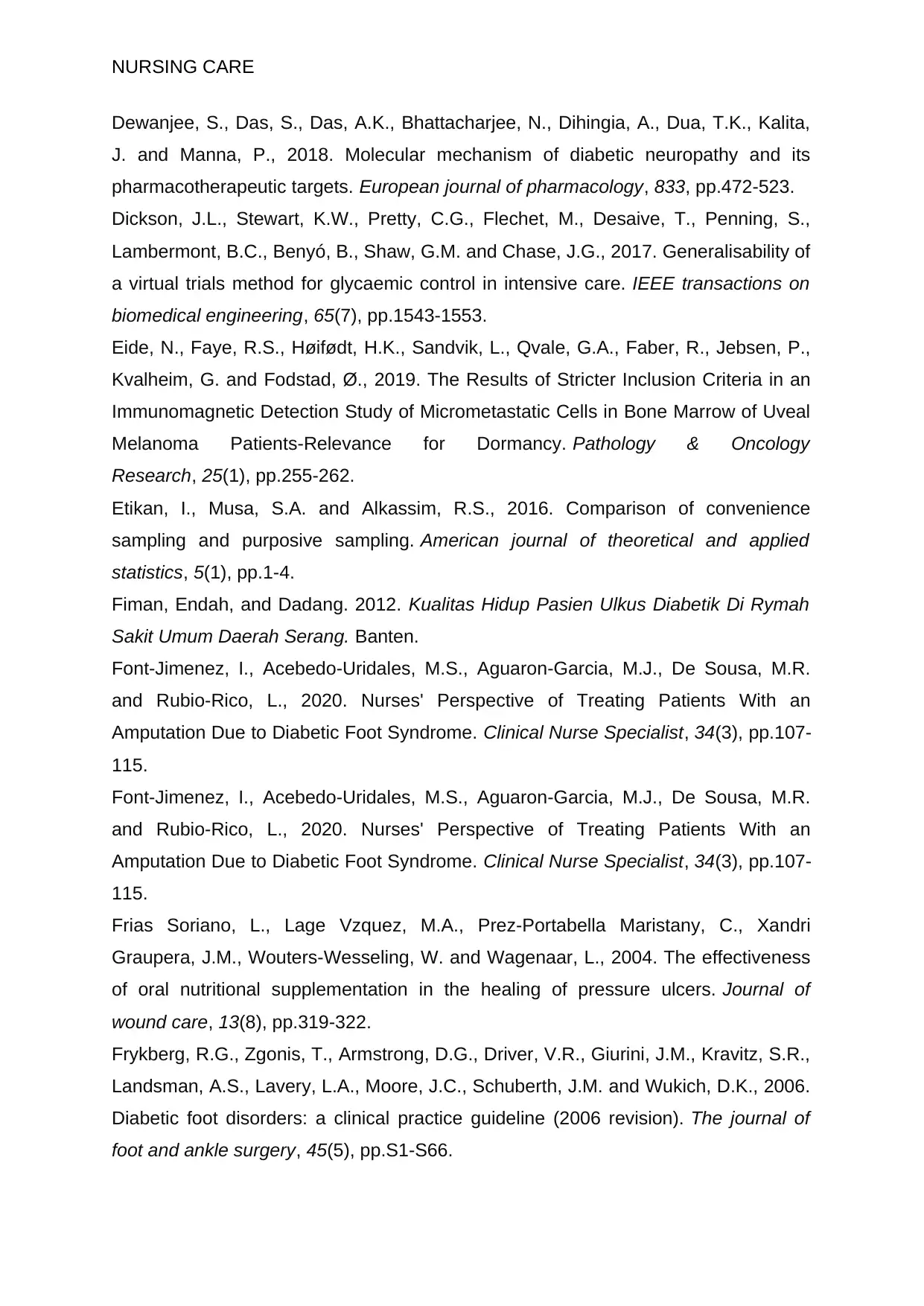
NURSING CARE
Dewanjee, S., Das, S., Das, A.K., Bhattacharjee, N., Dihingia, A., Dua, T.K., Kalita,
J. and Manna, P., 2018. Molecular mechanism of diabetic neuropathy and its
pharmacotherapeutic targets. European journal of pharmacology, 833, pp.472-523.
Dickson, J.L., Stewart, K.W., Pretty, C.G., Flechet, M., Desaive, T., Penning, S.,
Lambermont, B.C., Benyó, B., Shaw, G.M. and Chase, J.G., 2017. Generalisability of
a virtual trials method for glycaemic control in intensive care. IEEE transactions on
biomedical engineering, 65(7), pp.1543-1553.
Eide, N., Faye, R.S., Høifødt, H.K., Sandvik, L., Qvale, G.A., Faber, R., Jebsen, P.,
Kvalheim, G. and Fodstad, Ø., 2019. The Results of Stricter Inclusion Criteria in an
Immunomagnetic Detection Study of Micrometastatic Cells in Bone Marrow of Uveal
Melanoma Patients-Relevance for Dormancy. Pathology & Oncology
Research, 25(1), pp.255-262.
Etikan, I., Musa, S.A. and Alkassim, R.S., 2016. Comparison of convenience
sampling and purposive sampling. American journal of theoretical and applied
statistics, 5(1), pp.1-4.
Fiman, Endah, and Dadang. 2012. Kualitas Hidup Pasien Ulkus Diabetik Di Rymah
Sakit Umum Daerah Serang. Banten.
Font-Jimenez, I., Acebedo-Uridales, M.S., Aguaron-Garcia, M.J., De Sousa, M.R.
and Rubio-Rico, L., 2020. Nurses' Perspective of Treating Patients With an
Amputation Due to Diabetic Foot Syndrome. Clinical Nurse Specialist, 34(3), pp.107-
115.
Font-Jimenez, I., Acebedo-Uridales, M.S., Aguaron-Garcia, M.J., De Sousa, M.R.
and Rubio-Rico, L., 2020. Nurses' Perspective of Treating Patients With an
Amputation Due to Diabetic Foot Syndrome. Clinical Nurse Specialist, 34(3), pp.107-
115.
Frias Soriano, L., Lage Vzquez, M.A., Prez-Portabella Maristany, C., Xandri
Graupera, J.M., Wouters-Wesseling, W. and Wagenaar, L., 2004. The effectiveness
of oral nutritional supplementation in the healing of pressure ulcers. Journal of
wound care, 13(8), pp.319-322.
Frykberg, R.G., Zgonis, T., Armstrong, D.G., Driver, V.R., Giurini, J.M., Kravitz, S.R.,
Landsman, A.S., Lavery, L.A., Moore, J.C., Schuberth, J.M. and Wukich, D.K., 2006.
Diabetic foot disorders: a clinical practice guideline (2006 revision). The journal of
foot and ankle surgery, 45(5), pp.S1-S66.
Dewanjee, S., Das, S., Das, A.K., Bhattacharjee, N., Dihingia, A., Dua, T.K., Kalita,
J. and Manna, P., 2018. Molecular mechanism of diabetic neuropathy and its
pharmacotherapeutic targets. European journal of pharmacology, 833, pp.472-523.
Dickson, J.L., Stewart, K.W., Pretty, C.G., Flechet, M., Desaive, T., Penning, S.,
Lambermont, B.C., Benyó, B., Shaw, G.M. and Chase, J.G., 2017. Generalisability of
a virtual trials method for glycaemic control in intensive care. IEEE transactions on
biomedical engineering, 65(7), pp.1543-1553.
Eide, N., Faye, R.S., Høifødt, H.K., Sandvik, L., Qvale, G.A., Faber, R., Jebsen, P.,
Kvalheim, G. and Fodstad, Ø., 2019. The Results of Stricter Inclusion Criteria in an
Immunomagnetic Detection Study of Micrometastatic Cells in Bone Marrow of Uveal
Melanoma Patients-Relevance for Dormancy. Pathology & Oncology
Research, 25(1), pp.255-262.
Etikan, I., Musa, S.A. and Alkassim, R.S., 2016. Comparison of convenience
sampling and purposive sampling. American journal of theoretical and applied
statistics, 5(1), pp.1-4.
Fiman, Endah, and Dadang. 2012. Kualitas Hidup Pasien Ulkus Diabetik Di Rymah
Sakit Umum Daerah Serang. Banten.
Font-Jimenez, I., Acebedo-Uridales, M.S., Aguaron-Garcia, M.J., De Sousa, M.R.
and Rubio-Rico, L., 2020. Nurses' Perspective of Treating Patients With an
Amputation Due to Diabetic Foot Syndrome. Clinical Nurse Specialist, 34(3), pp.107-
115.
Font-Jimenez, I., Acebedo-Uridales, M.S., Aguaron-Garcia, M.J., De Sousa, M.R.
and Rubio-Rico, L., 2020. Nurses' Perspective of Treating Patients With an
Amputation Due to Diabetic Foot Syndrome. Clinical Nurse Specialist, 34(3), pp.107-
115.
Frias Soriano, L., Lage Vzquez, M.A., Prez-Portabella Maristany, C., Xandri
Graupera, J.M., Wouters-Wesseling, W. and Wagenaar, L., 2004. The effectiveness
of oral nutritional supplementation in the healing of pressure ulcers. Journal of
wound care, 13(8), pp.319-322.
Frykberg, R.G., Zgonis, T., Armstrong, D.G., Driver, V.R., Giurini, J.M., Kravitz, S.R.,
Landsman, A.S., Lavery, L.A., Moore, J.C., Schuberth, J.M. and Wukich, D.K., 2006.
Diabetic foot disorders: a clinical practice guideline (2006 revision). The journal of
foot and ankle surgery, 45(5), pp.S1-S66.
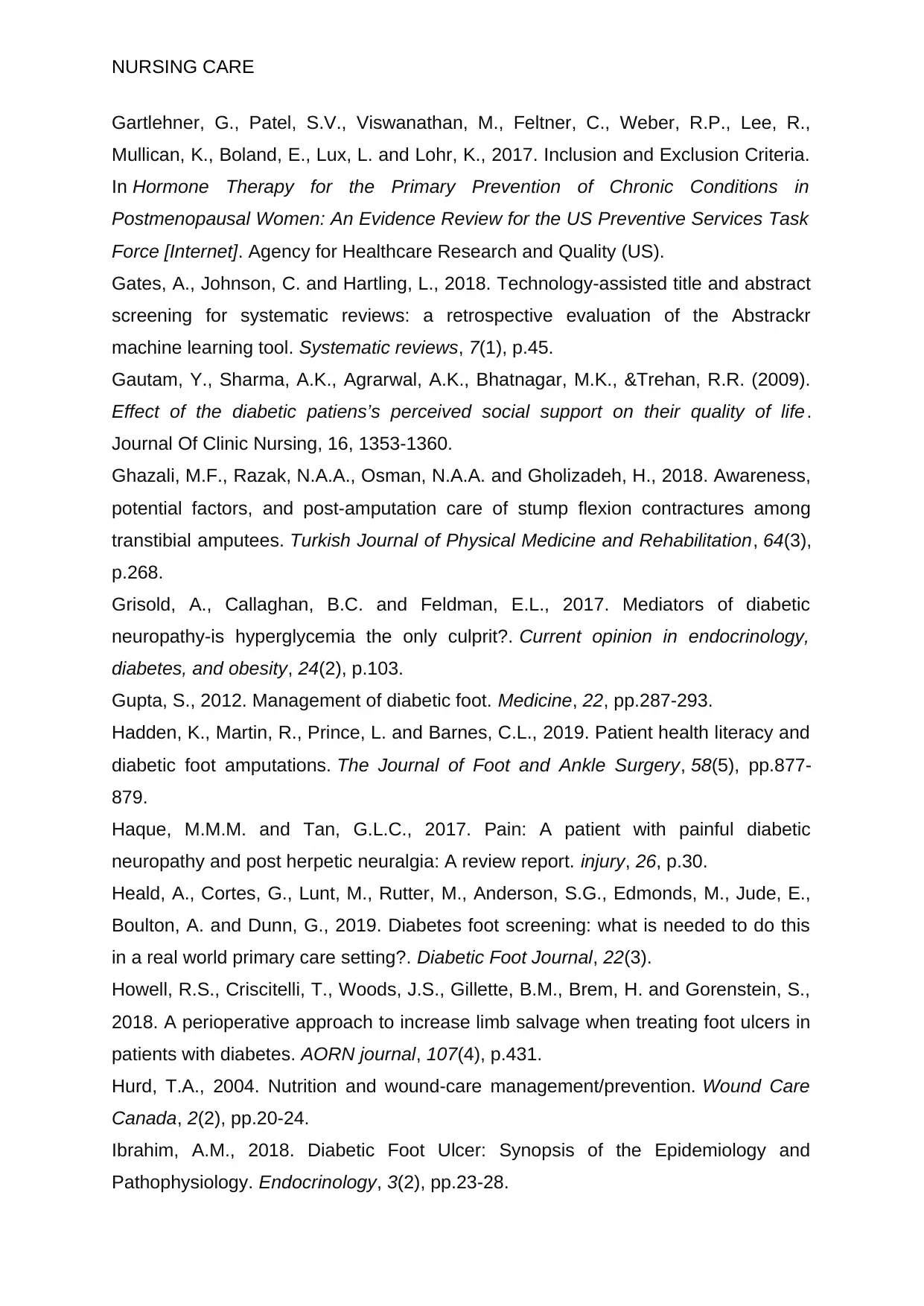
NURSING CARE
Gartlehner, G., Patel, S.V., Viswanathan, M., Feltner, C., Weber, R.P., Lee, R.,
Mullican, K., Boland, E., Lux, L. and Lohr, K., 2017. Inclusion and Exclusion Criteria.
In Hormone Therapy for the Primary Prevention of Chronic Conditions in
Postmenopausal Women: An Evidence Review for the US Preventive Services Task
Force [Internet]. Agency for Healthcare Research and Quality (US).
Gates, A., Johnson, C. and Hartling, L., 2018. Technology-assisted title and abstract
screening for systematic reviews: a retrospective evaluation of the Abstrackr
machine learning tool. Systematic reviews, 7(1), p.45.
Gautam, Y., Sharma, A.K., Agrarwal, A.K., Bhatnagar, M.K., &Trehan, R.R. (2009).
Effect of the diabetic patiens’s perceived social support on their quality of life.
Journal Of Clinic Nursing, 16, 1353-1360.
Ghazali, M.F., Razak, N.A.A., Osman, N.A.A. and Gholizadeh, H., 2018. Awareness,
potential factors, and post-amputation care of stump flexion contractures among
transtibial amputees. Turkish Journal of Physical Medicine and Rehabilitation, 64(3),
p.268.
Grisold, A., Callaghan, B.C. and Feldman, E.L., 2017. Mediators of diabetic
neuropathy-is hyperglycemia the only culprit?. Current opinion in endocrinology,
diabetes, and obesity, 24(2), p.103.
Gupta, S., 2012. Management of diabetic foot. Medicine, 22, pp.287-293.
Hadden, K., Martin, R., Prince, L. and Barnes, C.L., 2019. Patient health literacy and
diabetic foot amputations. The Journal of Foot and Ankle Surgery, 58(5), pp.877-
879.
Haque, M.M.M. and Tan, G.L.C., 2017. Pain: A patient with painful diabetic
neuropathy and post herpetic neuralgia: A review report. injury, 26, p.30.
Heald, A., Cortes, G., Lunt, M., Rutter, M., Anderson, S.G., Edmonds, M., Jude, E.,
Boulton, A. and Dunn, G., 2019. Diabetes foot screening: what is needed to do this
in a real world primary care setting?. Diabetic Foot Journal, 22(3).
Howell, R.S., Criscitelli, T., Woods, J.S., Gillette, B.M., Brem, H. and Gorenstein, S.,
2018. A perioperative approach to increase limb salvage when treating foot ulcers in
patients with diabetes. AORN journal, 107(4), p.431.
Hurd, T.A., 2004. Nutrition and wound-care management/prevention. Wound Care
Canada, 2(2), pp.20-24.
Ibrahim, A.M., 2018. Diabetic Foot Ulcer: Synopsis of the Epidemiology and
Pathophysiology. Endocrinology, 3(2), pp.23-28.
Gartlehner, G., Patel, S.V., Viswanathan, M., Feltner, C., Weber, R.P., Lee, R.,
Mullican, K., Boland, E., Lux, L. and Lohr, K., 2017. Inclusion and Exclusion Criteria.
In Hormone Therapy for the Primary Prevention of Chronic Conditions in
Postmenopausal Women: An Evidence Review for the US Preventive Services Task
Force [Internet]. Agency for Healthcare Research and Quality (US).
Gates, A., Johnson, C. and Hartling, L., 2018. Technology-assisted title and abstract
screening for systematic reviews: a retrospective evaluation of the Abstrackr
machine learning tool. Systematic reviews, 7(1), p.45.
Gautam, Y., Sharma, A.K., Agrarwal, A.K., Bhatnagar, M.K., &Trehan, R.R. (2009).
Effect of the diabetic patiens’s perceived social support on their quality of life.
Journal Of Clinic Nursing, 16, 1353-1360.
Ghazali, M.F., Razak, N.A.A., Osman, N.A.A. and Gholizadeh, H., 2018. Awareness,
potential factors, and post-amputation care of stump flexion contractures among
transtibial amputees. Turkish Journal of Physical Medicine and Rehabilitation, 64(3),
p.268.
Grisold, A., Callaghan, B.C. and Feldman, E.L., 2017. Mediators of diabetic
neuropathy-is hyperglycemia the only culprit?. Current opinion in endocrinology,
diabetes, and obesity, 24(2), p.103.
Gupta, S., 2012. Management of diabetic foot. Medicine, 22, pp.287-293.
Hadden, K., Martin, R., Prince, L. and Barnes, C.L., 2019. Patient health literacy and
diabetic foot amputations. The Journal of Foot and Ankle Surgery, 58(5), pp.877-
879.
Haque, M.M.M. and Tan, G.L.C., 2017. Pain: A patient with painful diabetic
neuropathy and post herpetic neuralgia: A review report. injury, 26, p.30.
Heald, A., Cortes, G., Lunt, M., Rutter, M., Anderson, S.G., Edmonds, M., Jude, E.,
Boulton, A. and Dunn, G., 2019. Diabetes foot screening: what is needed to do this
in a real world primary care setting?. Diabetic Foot Journal, 22(3).
Howell, R.S., Criscitelli, T., Woods, J.S., Gillette, B.M., Brem, H. and Gorenstein, S.,
2018. A perioperative approach to increase limb salvage when treating foot ulcers in
patients with diabetes. AORN journal, 107(4), p.431.
Hurd, T.A., 2004. Nutrition and wound-care management/prevention. Wound Care
Canada, 2(2), pp.20-24.
Ibrahim, A.M., 2018. Diabetic Foot Ulcer: Synopsis of the Epidemiology and
Pathophysiology. Endocrinology, 3(2), pp.23-28.
Secure Best Marks with AI Grader
Need help grading? Try our AI Grader for instant feedback on your assignments.
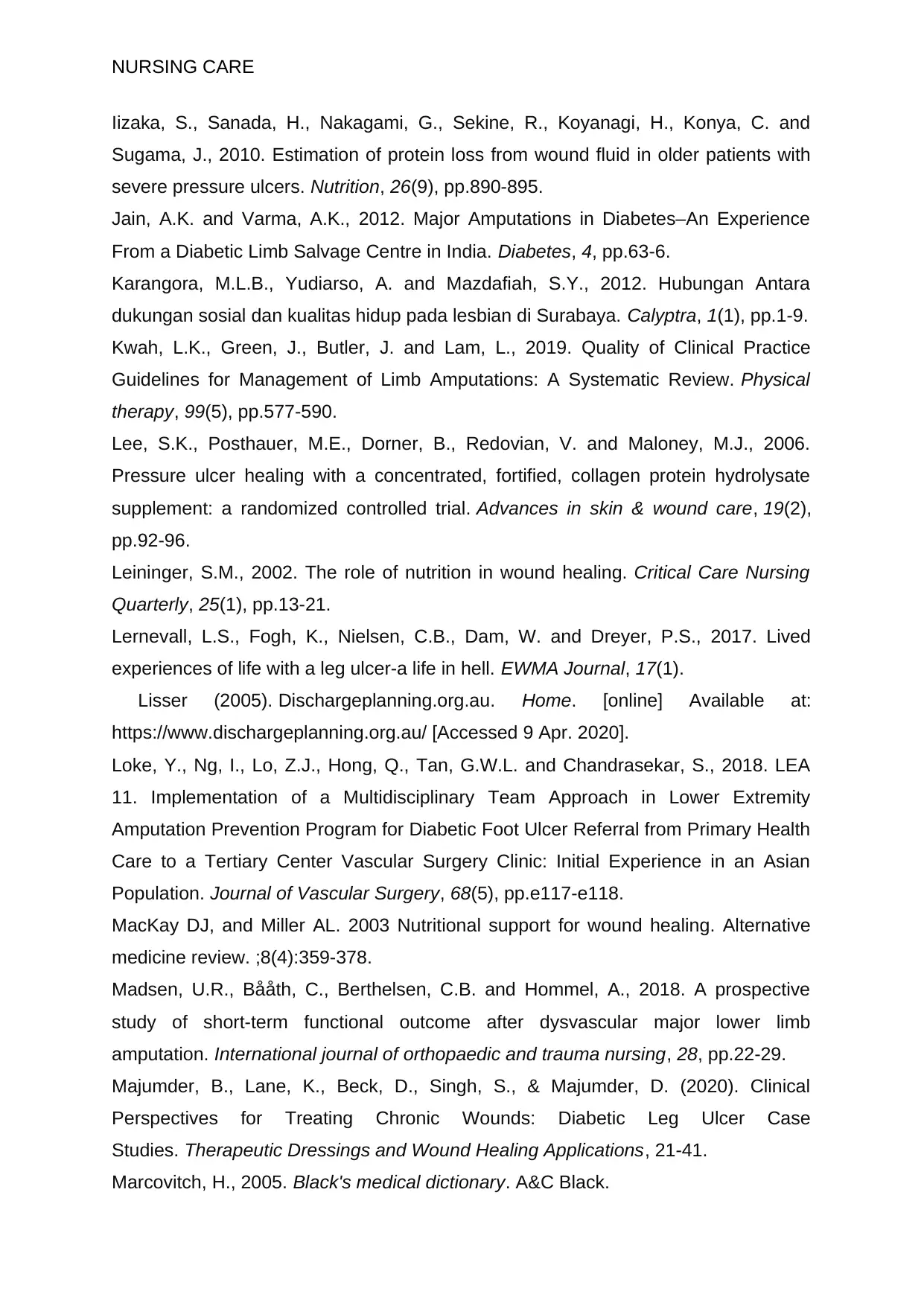
NURSING CARE
Iizaka, S., Sanada, H., Nakagami, G., Sekine, R., Koyanagi, H., Konya, C. and
Sugama, J., 2010. Estimation of protein loss from wound fluid in older patients with
severe pressure ulcers. Nutrition, 26(9), pp.890-895.
Jain, A.K. and Varma, A.K., 2012. Major Amputations in Diabetes–An Experience
From a Diabetic Limb Salvage Centre in India. Diabetes, 4, pp.63-6.
Karangora, M.L.B., Yudiarso, A. and Mazdafiah, S.Y., 2012. Hubungan Antara
dukungan sosial dan kualitas hidup pada lesbian di Surabaya. Calyptra, 1(1), pp.1-9.
Kwah, L.K., Green, J., Butler, J. and Lam, L., 2019. Quality of Clinical Practice
Guidelines for Management of Limb Amputations: A Systematic Review. Physical
therapy, 99(5), pp.577-590.
Lee, S.K., Posthauer, M.E., Dorner, B., Redovian, V. and Maloney, M.J., 2006.
Pressure ulcer healing with a concentrated, fortified, collagen protein hydrolysate
supplement: a randomized controlled trial. Advances in skin & wound care, 19(2),
pp.92-96.
Leininger, S.M., 2002. The role of nutrition in wound healing. Critical Care Nursing
Quarterly, 25(1), pp.13-21.
Lernevall, L.S., Fogh, K., Nielsen, C.B., Dam, W. and Dreyer, P.S., 2017. Lived
experiences of life with a leg ulcer-a life in hell. EWMA Journal, 17(1).
Lisser (2005). Dischargeplanning.org.au. Home. [online] Available at:
https://www.dischargeplanning.org.au/ [Accessed 9 Apr. 2020].
Loke, Y., Ng, I., Lo, Z.J., Hong, Q., Tan, G.W.L. and Chandrasekar, S., 2018. LEA
11. Implementation of a Multidisciplinary Team Approach in Lower Extremity
Amputation Prevention Program for Diabetic Foot Ulcer Referral from Primary Health
Care to a Tertiary Center Vascular Surgery Clinic: Initial Experience in an Asian
Population. Journal of Vascular Surgery, 68(5), pp.e117-e118.
MacKay DJ, and Miller AL. 2003 Nutritional support for wound healing. Alternative
medicine review. ;8(4):359-378.
Madsen, U.R., Bååth, C., Berthelsen, C.B. and Hommel, A., 2018. A prospective
study of short-term functional outcome after dysvascular major lower limb
amputation. International journal of orthopaedic and trauma nursing, 28, pp.22-29.
Majumder, B., Lane, K., Beck, D., Singh, S., & Majumder, D. (2020). Clinical
Perspectives for Treating Chronic Wounds: Diabetic Leg Ulcer Case
Studies. Therapeutic Dressings and Wound Healing Applications, 21-41.
Marcovitch, H., 2005. Black's medical dictionary. A&C Black.
Iizaka, S., Sanada, H., Nakagami, G., Sekine, R., Koyanagi, H., Konya, C. and
Sugama, J., 2010. Estimation of protein loss from wound fluid in older patients with
severe pressure ulcers. Nutrition, 26(9), pp.890-895.
Jain, A.K. and Varma, A.K., 2012. Major Amputations in Diabetes–An Experience
From a Diabetic Limb Salvage Centre in India. Diabetes, 4, pp.63-6.
Karangora, M.L.B., Yudiarso, A. and Mazdafiah, S.Y., 2012. Hubungan Antara
dukungan sosial dan kualitas hidup pada lesbian di Surabaya. Calyptra, 1(1), pp.1-9.
Kwah, L.K., Green, J., Butler, J. and Lam, L., 2019. Quality of Clinical Practice
Guidelines for Management of Limb Amputations: A Systematic Review. Physical
therapy, 99(5), pp.577-590.
Lee, S.K., Posthauer, M.E., Dorner, B., Redovian, V. and Maloney, M.J., 2006.
Pressure ulcer healing with a concentrated, fortified, collagen protein hydrolysate
supplement: a randomized controlled trial. Advances in skin & wound care, 19(2),
pp.92-96.
Leininger, S.M., 2002. The role of nutrition in wound healing. Critical Care Nursing
Quarterly, 25(1), pp.13-21.
Lernevall, L.S., Fogh, K., Nielsen, C.B., Dam, W. and Dreyer, P.S., 2017. Lived
experiences of life with a leg ulcer-a life in hell. EWMA Journal, 17(1).
Lisser (2005). Dischargeplanning.org.au. Home. [online] Available at:
https://www.dischargeplanning.org.au/ [Accessed 9 Apr. 2020].
Loke, Y., Ng, I., Lo, Z.J., Hong, Q., Tan, G.W.L. and Chandrasekar, S., 2018. LEA
11. Implementation of a Multidisciplinary Team Approach in Lower Extremity
Amputation Prevention Program for Diabetic Foot Ulcer Referral from Primary Health
Care to a Tertiary Center Vascular Surgery Clinic: Initial Experience in an Asian
Population. Journal of Vascular Surgery, 68(5), pp.e117-e118.
MacKay DJ, and Miller AL. 2003 Nutritional support for wound healing. Alternative
medicine review. ;8(4):359-378.
Madsen, U.R., Bååth, C., Berthelsen, C.B. and Hommel, A., 2018. A prospective
study of short-term functional outcome after dysvascular major lower limb
amputation. International journal of orthopaedic and trauma nursing, 28, pp.22-29.
Majumder, B., Lane, K., Beck, D., Singh, S., & Majumder, D. (2020). Clinical
Perspectives for Treating Chronic Wounds: Diabetic Leg Ulcer Case
Studies. Therapeutic Dressings and Wound Healing Applications, 21-41.
Marcovitch, H., 2005. Black's medical dictionary. A&C Black.
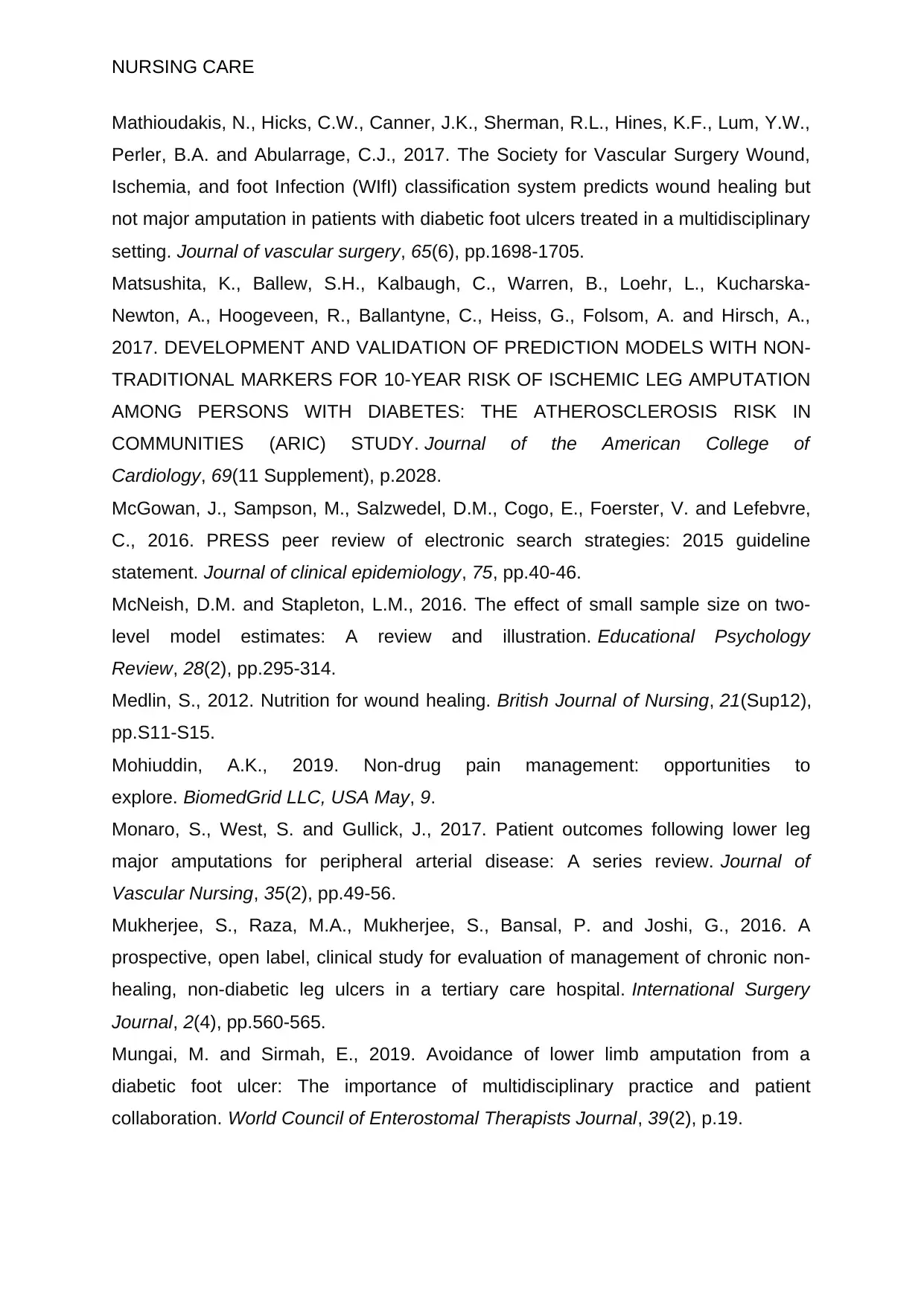
NURSING CARE
Mathioudakis, N., Hicks, C.W., Canner, J.K., Sherman, R.L., Hines, K.F., Lum, Y.W.,
Perler, B.A. and Abularrage, C.J., 2017. The Society for Vascular Surgery Wound,
Ischemia, and foot Infection (WIfI) classification system predicts wound healing but
not major amputation in patients with diabetic foot ulcers treated in a multidisciplinary
setting. Journal of vascular surgery, 65(6), pp.1698-1705.
Matsushita, K., Ballew, S.H., Kalbaugh, C., Warren, B., Loehr, L., Kucharska-
Newton, A., Hoogeveen, R., Ballantyne, C., Heiss, G., Folsom, A. and Hirsch, A.,
2017. DEVELOPMENT AND VALIDATION OF PREDICTION MODELS WITH NON-
TRADITIONAL MARKERS FOR 10-YEAR RISK OF ISCHEMIC LEG AMPUTATION
AMONG PERSONS WITH DIABETES: THE ATHEROSCLEROSIS RISK IN
COMMUNITIES (ARIC) STUDY. Journal of the American College of
Cardiology, 69(11 Supplement), p.2028.
McGowan, J., Sampson, M., Salzwedel, D.M., Cogo, E., Foerster, V. and Lefebvre,
C., 2016. PRESS peer review of electronic search strategies: 2015 guideline
statement. Journal of clinical epidemiology, 75, pp.40-46.
McNeish, D.M. and Stapleton, L.M., 2016. The effect of small sample size on two-
level model estimates: A review and illustration. Educational Psychology
Review, 28(2), pp.295-314.
Medlin, S., 2012. Nutrition for wound healing. British Journal of Nursing, 21(Sup12),
pp.S11-S15.
Mohiuddin, A.K., 2019. Non-drug pain management: opportunities to
explore. BiomedGrid LLC, USA May, 9.
Monaro, S., West, S. and Gullick, J., 2017. Patient outcomes following lower leg
major amputations for peripheral arterial disease: A series review. Journal of
Vascular Nursing, 35(2), pp.49-56.
Mukherjee, S., Raza, M.A., Mukherjee, S., Bansal, P. and Joshi, G., 2016. A
prospective, open label, clinical study for evaluation of management of chronic non-
healing, non-diabetic leg ulcers in a tertiary care hospital. International Surgery
Journal, 2(4), pp.560-565.
Mungai, M. and Sirmah, E., 2019. Avoidance of lower limb amputation from a
diabetic foot ulcer: The importance of multidisciplinary practice and patient
collaboration. World Council of Enterostomal Therapists Journal, 39(2), p.19.
Mathioudakis, N., Hicks, C.W., Canner, J.K., Sherman, R.L., Hines, K.F., Lum, Y.W.,
Perler, B.A. and Abularrage, C.J., 2017. The Society for Vascular Surgery Wound,
Ischemia, and foot Infection (WIfI) classification system predicts wound healing but
not major amputation in patients with diabetic foot ulcers treated in a multidisciplinary
setting. Journal of vascular surgery, 65(6), pp.1698-1705.
Matsushita, K., Ballew, S.H., Kalbaugh, C., Warren, B., Loehr, L., Kucharska-
Newton, A., Hoogeveen, R., Ballantyne, C., Heiss, G., Folsom, A. and Hirsch, A.,
2017. DEVELOPMENT AND VALIDATION OF PREDICTION MODELS WITH NON-
TRADITIONAL MARKERS FOR 10-YEAR RISK OF ISCHEMIC LEG AMPUTATION
AMONG PERSONS WITH DIABETES: THE ATHEROSCLEROSIS RISK IN
COMMUNITIES (ARIC) STUDY. Journal of the American College of
Cardiology, 69(11 Supplement), p.2028.
McGowan, J., Sampson, M., Salzwedel, D.M., Cogo, E., Foerster, V. and Lefebvre,
C., 2016. PRESS peer review of electronic search strategies: 2015 guideline
statement. Journal of clinical epidemiology, 75, pp.40-46.
McNeish, D.M. and Stapleton, L.M., 2016. The effect of small sample size on two-
level model estimates: A review and illustration. Educational Psychology
Review, 28(2), pp.295-314.
Medlin, S., 2012. Nutrition for wound healing. British Journal of Nursing, 21(Sup12),
pp.S11-S15.
Mohiuddin, A.K., 2019. Non-drug pain management: opportunities to
explore. BiomedGrid LLC, USA May, 9.
Monaro, S., West, S. and Gullick, J., 2017. Patient outcomes following lower leg
major amputations for peripheral arterial disease: A series review. Journal of
Vascular Nursing, 35(2), pp.49-56.
Mukherjee, S., Raza, M.A., Mukherjee, S., Bansal, P. and Joshi, G., 2016. A
prospective, open label, clinical study for evaluation of management of chronic non-
healing, non-diabetic leg ulcers in a tertiary care hospital. International Surgery
Journal, 2(4), pp.560-565.
Mungai, M. and Sirmah, E., 2019. Avoidance of lower limb amputation from a
diabetic foot ulcer: The importance of multidisciplinary practice and patient
collaboration. World Council of Enterostomal Therapists Journal, 39(2), p.19.
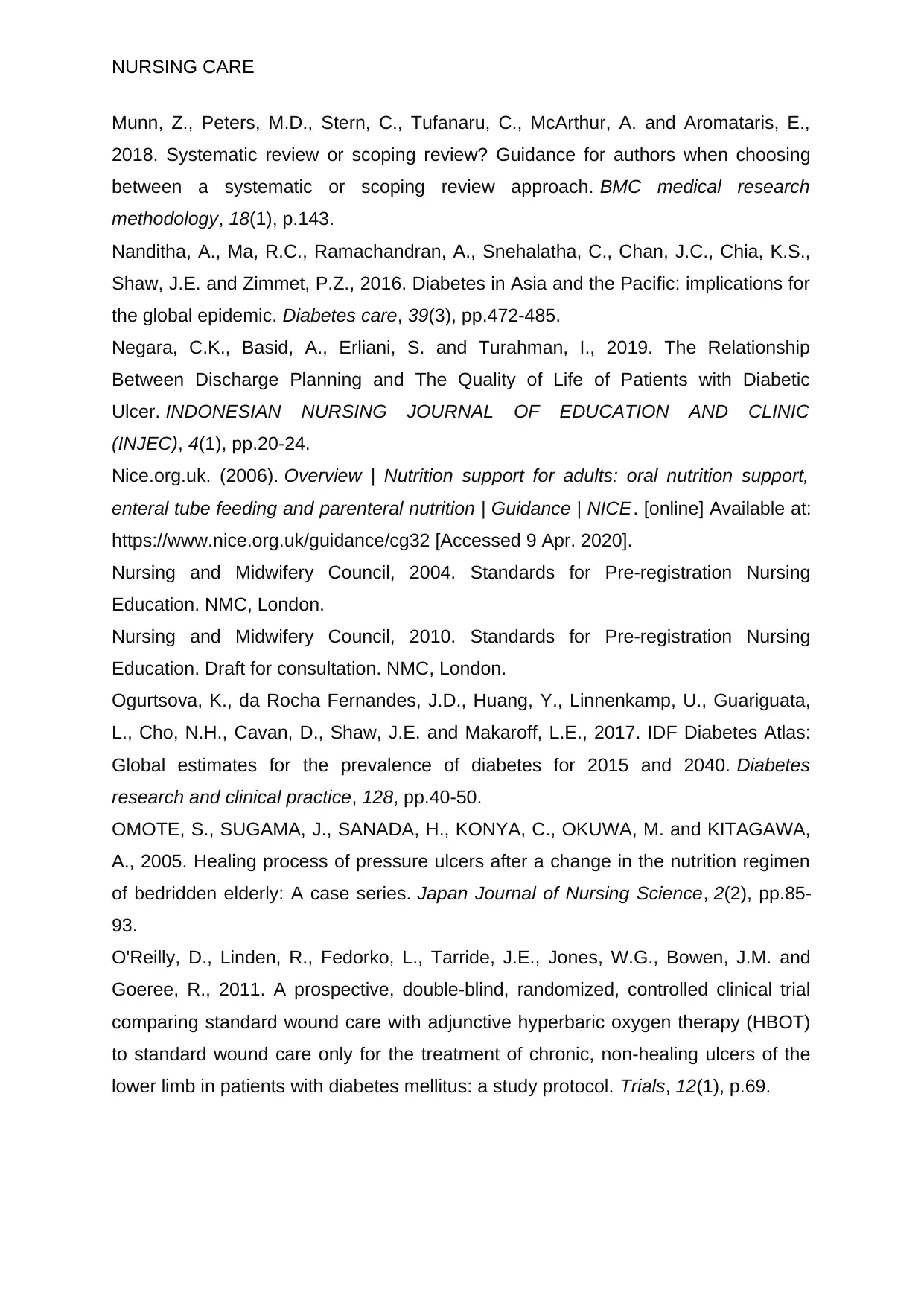
NURSING CARE
Munn, Z., Peters, M.D., Stern, C., Tufanaru, C., McArthur, A. and Aromataris, E.,
2018. Systematic review or scoping review? Guidance for authors when choosing
between a systematic or scoping review approach. BMC medical research
methodology, 18(1), p.143.
Nanditha, A., Ma, R.C., Ramachandran, A., Snehalatha, C., Chan, J.C., Chia, K.S.,
Shaw, J.E. and Zimmet, P.Z., 2016. Diabetes in Asia and the Pacific: implications for
the global epidemic. Diabetes care, 39(3), pp.472-485.
Negara, C.K., Basid, A., Erliani, S. and Turahman, I., 2019. The Relationship
Between Discharge Planning and The Quality of Life of Patients with Diabetic
Ulcer. INDONESIAN NURSING JOURNAL OF EDUCATION AND CLINIC
(INJEC), 4(1), pp.20-24.
Nice.org.uk. (2006). Overview | Nutrition support for adults: oral nutrition support,
enteral tube feeding and parenteral nutrition | Guidance | NICE. [online] Available at:
https://www.nice.org.uk/guidance/cg32 [Accessed 9 Apr. 2020].
Nursing and Midwifery Council, 2004. Standards for Pre-registration Nursing
Education. NMC, London.
Nursing and Midwifery Council, 2010. Standards for Pre-registration Nursing
Education. Draft for consultation. NMC, London.
Ogurtsova, K., da Rocha Fernandes, J.D., Huang, Y., Linnenkamp, U., Guariguata,
L., Cho, N.H., Cavan, D., Shaw, J.E. and Makaroff, L.E., 2017. IDF Diabetes Atlas:
Global estimates for the prevalence of diabetes for 2015 and 2040. Diabetes
research and clinical practice, 128, pp.40-50.
OMOTE, S., SUGAMA, J., SANADA, H., KONYA, C., OKUWA, M. and KITAGAWA,
A., 2005. Healing process of pressure ulcers after a change in the nutrition regimen
of bedridden elderly: A case series. Japan Journal of Nursing Science, 2(2), pp.85-
93.
O'Reilly, D., Linden, R., Fedorko, L., Tarride, J.E., Jones, W.G., Bowen, J.M. and
Goeree, R., 2011. A prospective, double-blind, randomized, controlled clinical trial
comparing standard wound care with adjunctive hyperbaric oxygen therapy (HBOT)
to standard wound care only for the treatment of chronic, non-healing ulcers of the
lower limb in patients with diabetes mellitus: a study protocol. Trials, 12(1), p.69.
Munn, Z., Peters, M.D., Stern, C., Tufanaru, C., McArthur, A. and Aromataris, E.,
2018. Systematic review or scoping review? Guidance for authors when choosing
between a systematic or scoping review approach. BMC medical research
methodology, 18(1), p.143.
Nanditha, A., Ma, R.C., Ramachandran, A., Snehalatha, C., Chan, J.C., Chia, K.S.,
Shaw, J.E. and Zimmet, P.Z., 2016. Diabetes in Asia and the Pacific: implications for
the global epidemic. Diabetes care, 39(3), pp.472-485.
Negara, C.K., Basid, A., Erliani, S. and Turahman, I., 2019. The Relationship
Between Discharge Planning and The Quality of Life of Patients with Diabetic
Ulcer. INDONESIAN NURSING JOURNAL OF EDUCATION AND CLINIC
(INJEC), 4(1), pp.20-24.
Nice.org.uk. (2006). Overview | Nutrition support for adults: oral nutrition support,
enteral tube feeding and parenteral nutrition | Guidance | NICE. [online] Available at:
https://www.nice.org.uk/guidance/cg32 [Accessed 9 Apr. 2020].
Nursing and Midwifery Council, 2004. Standards for Pre-registration Nursing
Education. NMC, London.
Nursing and Midwifery Council, 2010. Standards for Pre-registration Nursing
Education. Draft for consultation. NMC, London.
Ogurtsova, K., da Rocha Fernandes, J.D., Huang, Y., Linnenkamp, U., Guariguata,
L., Cho, N.H., Cavan, D., Shaw, J.E. and Makaroff, L.E., 2017. IDF Diabetes Atlas:
Global estimates for the prevalence of diabetes for 2015 and 2040. Diabetes
research and clinical practice, 128, pp.40-50.
OMOTE, S., SUGAMA, J., SANADA, H., KONYA, C., OKUWA, M. and KITAGAWA,
A., 2005. Healing process of pressure ulcers after a change in the nutrition regimen
of bedridden elderly: A case series. Japan Journal of Nursing Science, 2(2), pp.85-
93.
O'Reilly, D., Linden, R., Fedorko, L., Tarride, J.E., Jones, W.G., Bowen, J.M. and
Goeree, R., 2011. A prospective, double-blind, randomized, controlled clinical trial
comparing standard wound care with adjunctive hyperbaric oxygen therapy (HBOT)
to standard wound care only for the treatment of chronic, non-healing ulcers of the
lower limb in patients with diabetes mellitus: a study protocol. Trials, 12(1), p.69.
Paraphrase This Document
Need a fresh take? Get an instant paraphrase of this document with our AI Paraphraser
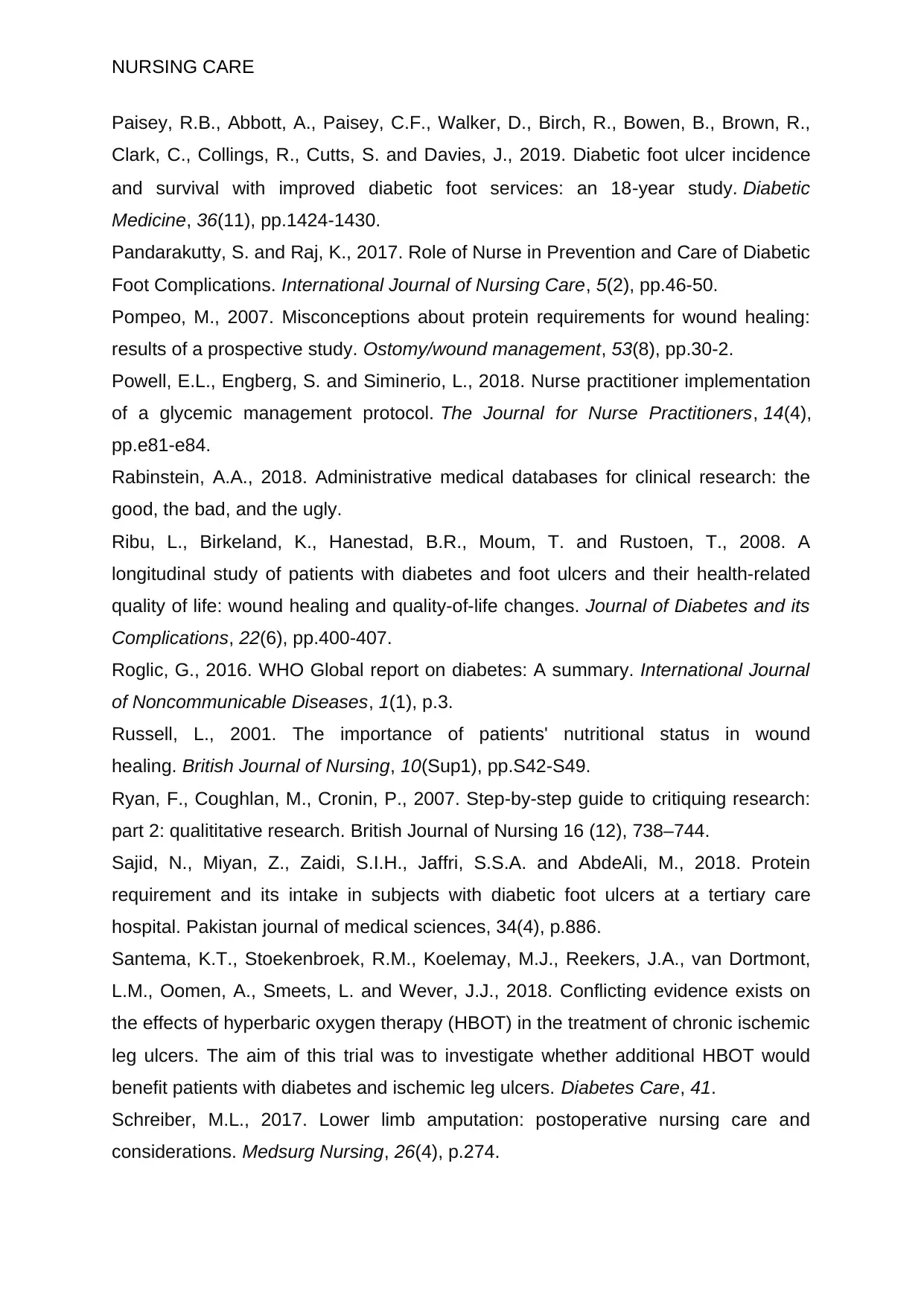
NURSING CARE
Paisey, R.B., Abbott, A., Paisey, C.F., Walker, D., Birch, R., Bowen, B., Brown, R.,
Clark, C., Collings, R., Cutts, S. and Davies, J., 2019. Diabetic foot ulcer incidence
and survival with improved diabetic foot services: an 18‐year study. Diabetic
Medicine, 36(11), pp.1424-1430.
Pandarakutty, S. and Raj, K., 2017. Role of Nurse in Prevention and Care of Diabetic
Foot Complications. International Journal of Nursing Care, 5(2), pp.46-50.
Pompeo, M., 2007. Misconceptions about protein requirements for wound healing:
results of a prospective study. Ostomy/wound management, 53(8), pp.30-2.
Powell, E.L., Engberg, S. and Siminerio, L., 2018. Nurse practitioner implementation
of a glycemic management protocol. The Journal for Nurse Practitioners, 14(4),
pp.e81-e84.
Rabinstein, A.A., 2018. Administrative medical databases for clinical research: the
good, the bad, and the ugly.
Ribu, L., Birkeland, K., Hanestad, B.R., Moum, T. and Rustoen, T., 2008. A
longitudinal study of patients with diabetes and foot ulcers and their health-related
quality of life: wound healing and quality-of-life changes. Journal of Diabetes and its
Complications, 22(6), pp.400-407.
Roglic, G., 2016. WHO Global report on diabetes: A summary. International Journal
of Noncommunicable Diseases, 1(1), p.3.
Russell, L., 2001. The importance of patients' nutritional status in wound
healing. British Journal of Nursing, 10(Sup1), pp.S42-S49.
Ryan, F., Coughlan, M., Cronin, P., 2007. Step-by-step guide to critiquing research:
part 2: qualititative research. British Journal of Nursing 16 (12), 738–744.
Sajid, N., Miyan, Z., Zaidi, S.I.H., Jaffri, S.S.A. and AbdeAli, M., 2018. Protein
requirement and its intake in subjects with diabetic foot ulcers at a tertiary care
hospital. Pakistan journal of medical sciences, 34(4), p.886.
Santema, K.T., Stoekenbroek, R.M., Koelemay, M.J., Reekers, J.A., van Dortmont,
L.M., Oomen, A., Smeets, L. and Wever, J.J., 2018. Conflicting evidence exists on
the effects of hyperbaric oxygen therapy (HBOT) in the treatment of chronic ischemic
leg ulcers. The aim of this trial was to investigate whether additional HBOT would
benefit patients with diabetes and ischemic leg ulcers. Diabetes Care, 41.
Schreiber, M.L., 2017. Lower limb amputation: postoperative nursing care and
considerations. Medsurg Nursing, 26(4), p.274.
Paisey, R.B., Abbott, A., Paisey, C.F., Walker, D., Birch, R., Bowen, B., Brown, R.,
Clark, C., Collings, R., Cutts, S. and Davies, J., 2019. Diabetic foot ulcer incidence
and survival with improved diabetic foot services: an 18‐year study. Diabetic
Medicine, 36(11), pp.1424-1430.
Pandarakutty, S. and Raj, K., 2017. Role of Nurse in Prevention and Care of Diabetic
Foot Complications. International Journal of Nursing Care, 5(2), pp.46-50.
Pompeo, M., 2007. Misconceptions about protein requirements for wound healing:
results of a prospective study. Ostomy/wound management, 53(8), pp.30-2.
Powell, E.L., Engberg, S. and Siminerio, L., 2018. Nurse practitioner implementation
of a glycemic management protocol. The Journal for Nurse Practitioners, 14(4),
pp.e81-e84.
Rabinstein, A.A., 2018. Administrative medical databases for clinical research: the
good, the bad, and the ugly.
Ribu, L., Birkeland, K., Hanestad, B.R., Moum, T. and Rustoen, T., 2008. A
longitudinal study of patients with diabetes and foot ulcers and their health-related
quality of life: wound healing and quality-of-life changes. Journal of Diabetes and its
Complications, 22(6), pp.400-407.
Roglic, G., 2016. WHO Global report on diabetes: A summary. International Journal
of Noncommunicable Diseases, 1(1), p.3.
Russell, L., 2001. The importance of patients' nutritional status in wound
healing. British Journal of Nursing, 10(Sup1), pp.S42-S49.
Ryan, F., Coughlan, M., Cronin, P., 2007. Step-by-step guide to critiquing research:
part 2: qualititative research. British Journal of Nursing 16 (12), 738–744.
Sajid, N., Miyan, Z., Zaidi, S.I.H., Jaffri, S.S.A. and AbdeAli, M., 2018. Protein
requirement and its intake in subjects with diabetic foot ulcers at a tertiary care
hospital. Pakistan journal of medical sciences, 34(4), p.886.
Santema, K.T., Stoekenbroek, R.M., Koelemay, M.J., Reekers, J.A., van Dortmont,
L.M., Oomen, A., Smeets, L. and Wever, J.J., 2018. Conflicting evidence exists on
the effects of hyperbaric oxygen therapy (HBOT) in the treatment of chronic ischemic
leg ulcers. The aim of this trial was to investigate whether additional HBOT would
benefit patients with diabetes and ischemic leg ulcers. Diabetes Care, 41.
Schreiber, M.L., 2017. Lower limb amputation: postoperative nursing care and
considerations. Medsurg Nursing, 26(4), p.274.
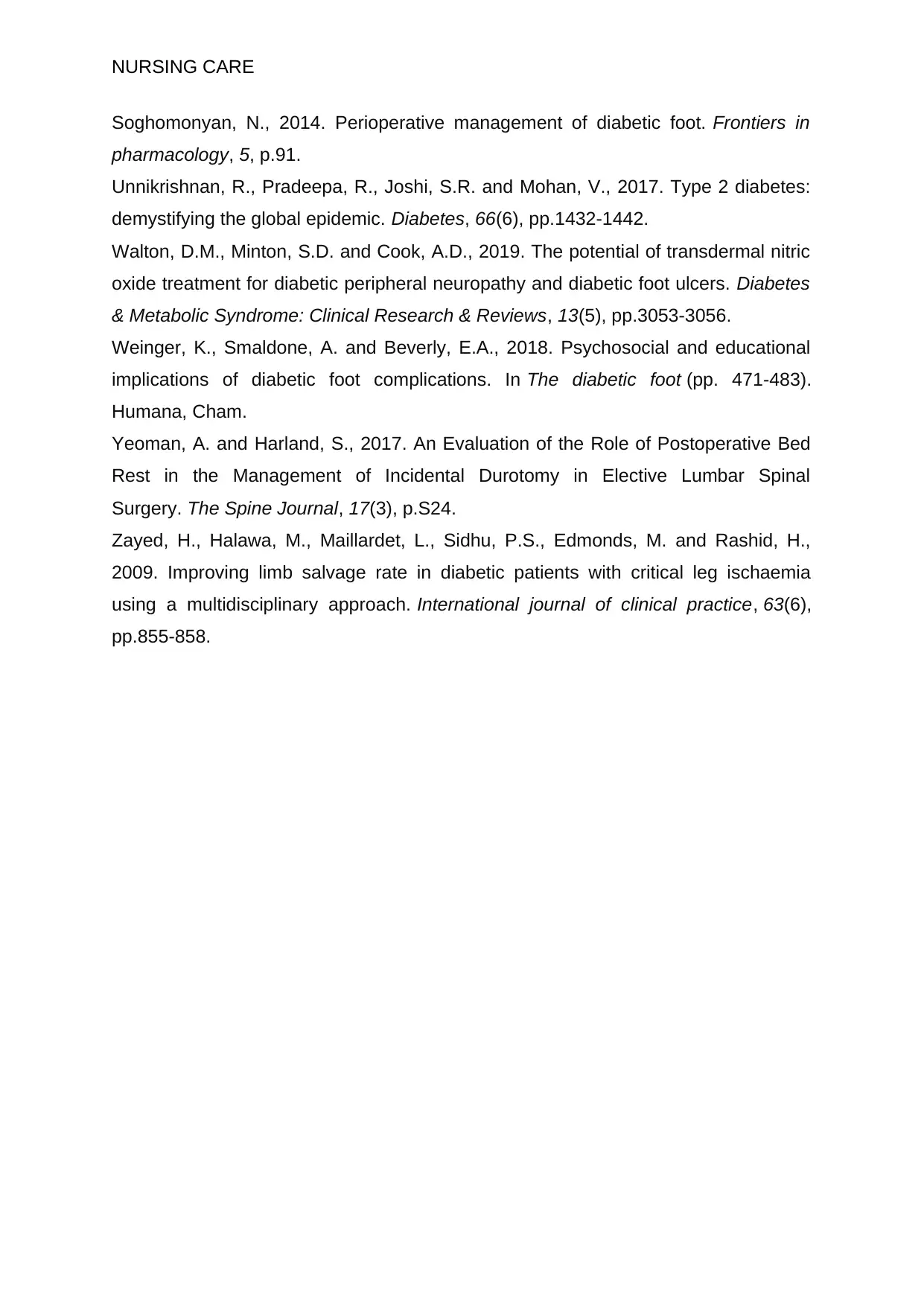
NURSING CARE
Soghomonyan, N., 2014. Perioperative management of diabetic foot. Frontiers in
pharmacology, 5, p.91.
Unnikrishnan, R., Pradeepa, R., Joshi, S.R. and Mohan, V., 2017. Type 2 diabetes:
demystifying the global epidemic. Diabetes, 66(6), pp.1432-1442.
Walton, D.M., Minton, S.D. and Cook, A.D., 2019. The potential of transdermal nitric
oxide treatment for diabetic peripheral neuropathy and diabetic foot ulcers. Diabetes
& Metabolic Syndrome: Clinical Research & Reviews, 13(5), pp.3053-3056.
Weinger, K., Smaldone, A. and Beverly, E.A., 2018. Psychosocial and educational
implications of diabetic foot complications. In The diabetic foot (pp. 471-483).
Humana, Cham.
Yeoman, A. and Harland, S., 2017. An Evaluation of the Role of Postoperative Bed
Rest in the Management of Incidental Durotomy in Elective Lumbar Spinal
Surgery. The Spine Journal, 17(3), p.S24.
Zayed, H., Halawa, M., Maillardet, L., Sidhu, P.S., Edmonds, M. and Rashid, H.,
2009. Improving limb salvage rate in diabetic patients with critical leg ischaemia
using a multidisciplinary approach. International journal of clinical practice, 63(6),
pp.855-858.
Soghomonyan, N., 2014. Perioperative management of diabetic foot. Frontiers in
pharmacology, 5, p.91.
Unnikrishnan, R., Pradeepa, R., Joshi, S.R. and Mohan, V., 2017. Type 2 diabetes:
demystifying the global epidemic. Diabetes, 66(6), pp.1432-1442.
Walton, D.M., Minton, S.D. and Cook, A.D., 2019. The potential of transdermal nitric
oxide treatment for diabetic peripheral neuropathy and diabetic foot ulcers. Diabetes
& Metabolic Syndrome: Clinical Research & Reviews, 13(5), pp.3053-3056.
Weinger, K., Smaldone, A. and Beverly, E.A., 2018. Psychosocial and educational
implications of diabetic foot complications. In The diabetic foot (pp. 471-483).
Humana, Cham.
Yeoman, A. and Harland, S., 2017. An Evaluation of the Role of Postoperative Bed
Rest in the Management of Incidental Durotomy in Elective Lumbar Spinal
Surgery. The Spine Journal, 17(3), p.S24.
Zayed, H., Halawa, M., Maillardet, L., Sidhu, P.S., Edmonds, M. and Rashid, H.,
2009. Improving limb salvage rate in diabetic patients with critical leg ischaemia
using a multidisciplinary approach. International journal of clinical practice, 63(6),
pp.855-858.
1 out of 39
Related Documents
Your All-in-One AI-Powered Toolkit for Academic Success.
+13062052269
info@desklib.com
Available 24*7 on WhatsApp / Email
![[object Object]](/_next/static/media/star-bottom.7253800d.svg)
Unlock your academic potential
© 2024 | Zucol Services PVT LTD | All rights reserved.




